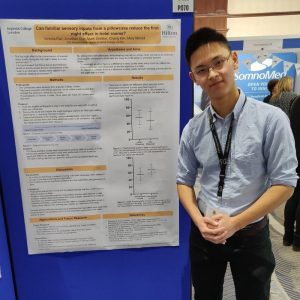
2022 A to L
THE FIRST ABSTRACTS FROM 2023 with REVIEWS of 2022
Stefanie Dillenhoefer , Dorothy Grogono , Ana Morales-Tirado.A year in review (2022): Modulators and COVID19, the story goes on….. Review J Cyst Fibros. 2023 Mar 6;S1569-1993(23)00065-6. doi: 10.1016/j.jcf.2023.03.001. Online ahead of print. Free PMC article pubmed.ncbi.nlm.nih.gov/36906393/

Fig. 1 Stefanie Dillenhoefer Linkedin
In this review the authors state they have aimed to cover some of the highlights of the cystic fibrosis (CF) literature in 2022, which again has been dominated by the SARS-CoV-2 (COVID-19) pandemic and modulator therapy. They have also explored other themes, such as novel findings in relation to pulmonary exacerbations, early lung disease and emerging areas for people with CF (pwCF).
— The free PMC article, accessed through the above PubMed link, is excellent and covers the main advances during the year.
Dr Stefanie Dillenhoefer (fig.1) is in the Department of Pediatric Pulmonology, Cystic Fibrosis Center, University Children’s Hospital of Ruhr University Bochum at St. Josef-Hospital, 44791 Bochum, Germany.
Jeeyeon Kim, Benjamin Lyman, Adrienne P Savant. Cystic fibrosis year in review 2022 Review Pediatr Pulmonol. 2023 Aug 18. doi: 10.1002/ppul.26641. Online ahead of print.pubmed.ncbi.nlm.nih.gov/37594137/

Fig. 2 Jeeyeon Kim
medicine.tulane.edu
Remarkable medical advancements have been made for people with cystic fibrosis (CF) in recent years, with an abundance of research continuing to be conducted worldwide. With concern for limitations in access to highly effective CFTR modulators, as well as the recent Coronavirus Disease-19 pandemic, there has been a consistent effort to understand and improve CF screening, disease burden, diagnosis, and management. Our aim in this review is to present articles from 2022 with an emphasis on clinically relevant studies. We hope this will serve as a broad overview of the research published in the past year.
Jeeyeon Kim (fig.2) is a resident at the Department of Pediatrics, Children’s Hospital of New Orleans, New Orleans, Louisiana, USA.and the Department of Pediatrics, Tulane University, New Orleans, Louisiana, USA.
2022
B L Aalbers, J E Brunsveld, C K van der Ent, J C van den Eijnden, J M Beekman, H G M Heijerman. Forskolin induced swelling (FIS) assay in intestinal organoids to guide eligibility for compassionate use treatment in a CF patient with a rare genotype. J Cyst Fibros 2022 Jan 30;S1569-1993(22)00028-5.doi: 10.1016/j.jcf.2022.01.008. Online ahead of print. pubmed.ncbi.nlm.nih.gov/35110005
Background: Forskolin-induced swelling of patient-derived organoids has been used to measure patient-specific CFTR function and CFTR modulator response. We present a case where CFTR function assessment in intestinal organoids was decisive for a patients’ acceptance to a compassionate use program.
Case description: A 56 years old female with cystic fibrosis compound heterozygous for F508del and a rare CFTR allele (c.3717+5G>T) experienced rapid clinical deterioration. The forskolin-induced swelling assay on her rectal organoids was used to confirm that the rare mutation is a minimal residual function mutation, and that other CFTR modulators would not likely be effective. Based on these two criteria and her clinical status, she was accepted for compassionate use of elexacaftor/tezacaftor/ivacaftor and showed improvement in all clinical parameters.
Conclusions: This reports describes a first example that intestinal organoids were used to identify a previously unknown CFTR mutation as a minimal function mutation. The individual FIS-based definition of minimal residual function, response to ele/tez/iva and/or lack of response to other CFTR modulating drugs, may thus provide a tool for access to ele/tez/ivatreatment for people with rare genotypes.
B L Aalbers is in the Department of pulmonology, UMC Utrecht, The Netherlands. Electronic address: b.l.aalbers-2@umcutrecht.nl.
Janice Abbott, Margaret A Hurley, Helen Chadwick, Daniel Peckham. Ways of coping and survival in Cystic Fibrosis: a 20-year longitudinal study. J Cyst Fibros 2022 Apr 20;S1569-1993(22)00100-X. doi: 10.1016/j.jcf.2022.04.011.Online ahead of print. [Pubmed]

Fig.3 Janice Abbott clan.ac.uk
Background: The relationship between ways of coping and health outcomes has been a focus of interest for decades. There is increasing recognition that positive psychological functioning can influence health outcomes beneficially. This work investigated the role of coping in predicting survival in CF.
Methods: A longitudinal observational cohort study with a 20-year follow-up period was undertaken. At entry to the study, demographic and clinical variables were recorded, and ways of coping were assessed us.UKing the Cystic Fibrosis Coping Scale which measures four distinct ways of coping: optimism, hopefulness, distraction and avoidance. Survival outcome was measured as time in days from the date of recruitment to exit from the study, where exit was either death, loss to follow-up or the end of the follow-up period.
Results: Survival time was modelled using Cox’s proportional hazards model. At baseline, 116 people with CF were recruited. By the census date, 54 people had died (14 men had died during 248,565 person-days of observation and 40 women had died during 358,372 person-days of observation). Optimism was the only way of coping that showed any beneficial effect on survival (RR=0.984, p=0.040) after adjustments for age, gender, ppFEV1 and the three other coping variables measured at baseline.
Conclusion: This work suggests that optimistic coping serves as a prognostic measure of survival in CF beyond key clinical and demographic variables. Ways of coping are modifiable, providing a target for clinical intervention; to improve quality of life and clinical outcomes and potentially increase longevity.
Janice Abbott (fig.3) is Professor of Health Psychoilogy at the School of Psychology, University of Central Lancashire, Preston, PR1 2HE, UK
Gimano D Amatngalim, Lisa W Rodenburg, Bente L Aalbers, Henriette Hm Raeven, Ellen M Aarts , Dounia Sarhane, Sacha Spelier, Juliet W Lefferts, Iris Al Silva, Wilco Nijenhuis, Sacha Vrendenbarg, Sabine Michel, Karin M de Winter-de Groot, Harry G Heijerman, Lukas C Kapitein, Magarida D Amaral, Cornelis K van der Ent, Jeffrey M Beekman. Measuring cystic fibrosis drug responses in organoids derived from 2D differentiated nasal epithelia. Life Sci Alliance 2022 Aug 3;5(12):e202101320.doi: 10.26508/lsa.202101320. Print 2022 [Pubmed]

Fig. 4 Gimano Amatngalim
LinkedIn
Cystic fibrosis is caused by genetic defects that impair the CFTR channel in airway epithelial cells. These defects may be overcome by specific CFTR modulating drugs, for which the efficacy can be predicted in a personalized manner using 3D nasal-brushing-derived airway organoids in a forskolin-induced swelling assay. Despite of this, previously described CFTR function assays in 3D airway organoids were not fully optimal, because of inefficient organoid differentiation and limited scalability. In this report, we therefore describe an alternative method of culturing nasal-brushing-derived airway organoids, which are created from an equally differentiated airway epithelial monolayer of a 2D air-liquid interface culture. In addition, we have defined organoid culture conditions, with the growth factor/cytokine combination neuregulin-1β and interleukin-1β, which enabled consistent detection of CFTR modulator responses in nasal-airway organoid cultures from subjects with cystic fibrosis.
Gimano D Amatngalim (fig.4) is a Biomedical Scientist in the Department of Pediatric Pulmonology, Wilhelmina Children’s Hospital, University Medical Center Utrecht, Utrecht University, Member of ERN-LUNG, Utrecht, The Netherlands and the University Medical Center Utrecht, Utrecht University, Utrecht, The Netherlands
Dorothea Appelt, Teresa Fuchs, Gratiana Steinkamp, Helmut Ellemunter. Malignancies in patients with cystic fibrosis: a case series J Med Case Rep 2022 Jan 19;16(1):27. doi: 10.1186/s13256-021-03234-1. [Pubmed]
Background: Previous reports have shown an increased number of colorectal cancers in patients with cystic fibrosis. We assessed the database of our cystic fibrosis centre to identify patients with all kinds of cancer retrospectively. All patients visiting the Cystic Fibrosis Centre Innsbruck between 1995 and 2019 were included
Case presentation: Among 229 patients with cystic fibrosis treated at the Cystic Fibrosis Centre in Innsbruck between 1995 and 2019, 11 subjects were diagnosed with a malignant disease. The median age at diagnosis was 25.2 years (mean 24.3 years). There were four gynaecological malignancies (cervical intraepithelial neoplasia and cervical cancer), two haematological malignancies (acute lymphocytic leukemia), one gastrointestinal malignancy (peritoneal mesothelioma), and four malignancies from other origins (malignant melanoma, neuroblastoma, adrenocortical carcinoma, and thyroid cancer). One malignancy occurred after lung transplantation. There was a strong preponderance of females, with 10 of the 11 cases occurring in women. Six deaths were attributed to cancer.
Conclusions: Most diagnoses were made below 30 years of age, and half of the subjects died from the malignant disease. Awareness of a possible malignancy is needed in patients with atypical symptoms. Regular screenings for cancer should also be considered, not only for gastrointestinal tumours.
Dr Dorothea Applelt is at the Medical University of Innsbruck, Cystic Fibrosis Centre Innsbruck, 6020, Innsbruck, Austria.
Michael Atkinson, Oliver Johnson, Niall Wilson, Martin Walshaw, Thomas Simon FitzMaurice. Eruptive melanocytic naevi following initiation of elexacaftor/ivacaftor/tezacaftor for cystic fibrosis. J Cyst Fibros. 2022 Nov;21(6):1070-1073. doi: 10.1016/j.jcf.2022.06.004. Epub 2022 Jun 2 pubmed.ncbi.nlm.nih.gov/35752560/
A 29 year old woman with cystic fibrosis (CF) presented to CF clinic following the sudden development of over 200 pigmented naevi located predominately on the trunk and limbs 3 months after commencing elexacaftor/tezacaftor/ivacaftor, a novel triple-therapy CFTR modulator therapy for CF. Skin biopsy confirmed benign naevi and the clinical presentation was consistent with eruptive melanocytic naevi. Elexacaftor/tezacaftor/ivacaftor received marketing authorisation in August 2020 and this is the first report of associated naevi. The individual described here remains clinically well, and continues on elexacaftor/tezacaftor/ivacaftor with dermatology follow-up.
Dr Michael Atkinson is at the Adult CF Unit, Liverpool Heart and Chest Hospital, Thomas Drive, Liverpool L14 3PE, UK.
P Aurora, Julie Anne Duncan, S Lum, G Davies, A Wade, J Stocks, L Viviani, E Raywood, C Pao, G Ruiz, A Bush, London Cystic Fibrosis Collaboration (LCFC). Early Pseudomonas aeruginosa predicts poorer pulmonary function in preschool children with cystic fibrosis. J Cyst Fibros 2022 Apr 30;S1569-1993(22)00102-3.doi: 10.1016/j.jcf.2022.04.013.Online ahead of print.[Pubmed]

Fig. 5 Paul Aurora Author’s photo
Background: We previously reported relatively normal pulmonary function (2 years of age) and computed tomography (CT, 1 year of age) in cystic fibrosis (CF) newborn screened (NBS) infants. We now report follow up of these children to preschool age.
Methods: 67 NBS children with CF and 41 healthy controls underwent pulmonary function tests in infancy (∼3 months, 1 year and 2 years) and at preschool (3-6 years). Broncho-alveolar lavage (BAL) and CT were undertaken in those with CF at 1 year. Primary outcomes at preschool were lung clearance index (LCI) and forced expired volume (FEV0.75). Risk factors for lung function impairment were identified by regression modelling, emphasising factors that could be identified or measured in the first 2 years of life.
Results: At preschool age children with CF had poorer lung function than controls, mean(95% CI) difference in LCI z-score: 1.47(0.96;1.97) and FEV0.75 z-score -0.54(-0.98; -0.10). Isolation of Pseudomonas aeruginosa before 6 months was a highly significant predictor of raised (abnormal) preschool LCI, associated with a mean (95%CI) increase of 1.69(0.43, 2.95) z-scores, compared to those with no Pseudomonas aeruginosa during the first 2 years of life. Including 2 year LCI and 1 year CT data in the predictive model increased the r2 from 13% to 61%.
Conclusions: Lung function deteriorates after 2 years in NBS children with CF. Isolation of Pseudomonas aeruginosa before 6 months and minor abnormalities of infant lung function tests and CT in infancy are associated with higher preschool LCI.
Paul Aurora (fig.5) is in the Department of Infection, Immunity, Inflammation Research and Teaching Department, UCL Great Ormond Street Institute of Child Health, 30 Guilford Street, London WC1N 1EH, United Kingdom; Respiratory Medicine, Great Ormond Street Hospital for Children NHS Foundation Trust, London, United Kingdom.
I M Balfour-Lynn , M Puckey , N J Simmonds, J C Davies. Uncertainties Revisiting a diagnosis of cystic fibrosis and considerations. Review Paediatr Respir Rev. 2022 Jun;42:29-34. doi: 10.1016/j.prrv.2021.11.002. Epub 2021 Dec 8. [Pubmed]

Fig. 6 Ian Balfour-Lynn
There is now increased knowledge and experience of newborn screening around the world. There is also a better understanding of CF gene analysis, informed by international databases. This has resulted in a small number of children and adults having their diagnosis of CF reversed. This article illustrates this issue with three cases. It considers how best to tell children and adults with their families, and the reactions that may be encountered. It also discusses practical issues of removing the diagnosis.
Ian Balfour0Lynn (fig.6) is consultant paediatrician at the Royal Brompton, London
H L Barr, T Bihouee, A M Zwitserloot. A year in review: Real world evidence, functional monitoring and emerging therapeutics in 2021. J Cyst Fibros 2022 Mar;21(2):191-196.doi: 10.1016/j.jcf.2022.02.014.Epub 2022 Mar 7. Free PMC article [Pubmed]

Fig. 7 Helen Barr
Facebook
This is a comprehensive and extensively referenced review of significant areas of change and new knowledge during 2021. The Free PMC article is available and strongly recommended.
There are joint first authors. The corresponding author is Dr Helen Barr consultant respiratory physician at the Nottingham University Hospitals NHS Trust, Nottingham, United Kingdom; Nottingham Respiratory Biomedical Research Centre, University of Nottingham, Nottingham, United Kingdom.
Helen Barr (fig.7) is a respiratory consultant at the City Hospital Nottingham
Rosara M Bass, Babette S Zemel Virginia A Stallings, Mary B Leonard Jaime Tsao Andrea Kelly. Bone accrual and structural changes over one year in youth with cystic fibrosis. J Clin Transl Endocrinol 2022 Mar 25;28:100297.doi: 10.1016/j.jcte.2022.100297.eCollection 2022 Jun.[Pubmed]

Fig. 8 Rosara Bass linkedin.com
Background: Pediatric bone accrual governs peak bone mass and strength. Longitudinal studies of bone health in youth with cystic fibrosis (CF) may provide insight into CF-related bone disease (CFBD), a prevalent co-morbidity in adults with CF.
Methods: This one-year longitudinal study of youth with pancreatic insufficient CF, enrolled in a nutrition intervention study [n = 62 (36 M/26F)] 1) examined dual-energy x-ray absorptiometry (DXA)-defined lumbar spine (LS) and total body less head (TBLH) bone accrual and 2) compared their changes in peripheral quantitative computed tomography (pQCT) cortical and trabecular tibial bone density and geometry to those of a healthy reference group [n = 143 (68 M/75F)].Main outcome measures were 1) DXA: lumbar spine areal bone mineral density (LSaBMD) and total body less head bone mineral content (TBLH-BMC), sex- and pubertal status-specific, height velocity (HV)-adjusted or HV and lean body mass velocity (HV-LBMV)-adjusted annualized velocity-Z scores and 2) pQCT: age, sex, pubertal status and, when appropriate, tibial length adjusted Z-scores for bone architecture measures.DXA velocity-Z were compared to expected mean of 0 and correlations with clinical parameters (age, BMI-Z and FEV1%-predicted) tested. Within-subject comparisons of HV-adjusted and LBMV-HV-adjusted DXA velocity-Z were conducted in CF.pQCT Z-scores were compared between the two groups over one year using longitudinal models. Longitudinal relationships between measures of bone health and clinical parameters (age, BMI-Z and FEV1%-predicted) were examined in individuals with CF.
Results: DXA velocity-Z were higher than normal in females (p < 0.05) but not males with CF. HV-adjusted and LBMV-HV-adjusted velocity-Z did not differ for LSaBMD or TBLH-BMC.In males with CF, both HV-adjusted and LBMV-HV-adjusted LSaBMD velocity-Z scores correlated negatively with age (HV rho: -0.35; p = 0.045 and LBMV-HV rho: -0.47; p = 0.0046). In males with CF BMI-Z correlated positively with HV-adjusted LSaBMD velocity-Z (rho: 0.37; p = 0.034), but this relationship did not persist for LBMV-HV (rho: 0.14; p = 0.42). In females with CF, no correlations between LSaBMD velocity-Z scores and age or BMI-Z were found (all p > 0.05). No correlations between LSaBMD velocity-Z scores and FEV1%-predicted were seen in either sex (all p > 0.12). TBLH-BMC velocity Z-scores were not correlated with clinical parameters in either sex (all p > 0.1).At baseline, multiple pQCT parameters were lower in CF (p < 0.05). pQCT Z-scores did not differ between baseline and one-year in either CF or reference group. In a longitudinal model comparing pQCT-Z changes in CF and reference, multiple pQCT-Z outcomes remained lower in CF, but the changes in parameters did not differ in CF vs reference (all p > 0.26). Lower pQCT outcomes in CF were largely restricted to males (CF group*female sex interaction beta coefficients > 0). In this combined longitudinal model, of both CF and reference, BMI-Z was positively associated with pQCT-Z parameters(p < 0.001).Multiple pQCT-Z outcomes positively correlated with both BMI-Z and FEV1%-predicted in males with CF, and with FEV1%-predicted in females with CF (p < 0.05). Age was negatively associated with section modulus (p = 0.001) in males and with cortical density-Z in females (p < 0.001).
Conclusions: With improved longevity, bone health in CF is of increasing importance. On average, bone accrual was preserved in youth with CF, and while deficits in bone geometry and strength were found, these deficits did not worsen over the one-year study. Lower LS bone accrual with increasing age suggests emerging adulthood is a period of vulnerability in CF while the role of LBM in bone health is underscored by the lack of relationship between LBMV-adjusted accrual and BMI. These findings may be useful in targeting screening practices and interventions.
Keywords: BMC, Bone mineral content; Bone accrual; Bone health; CF, Cystic Fibrosis; Cystic fibrosis; DXA velocity; DXA, Dual energy x-ray densiometry; FEV1, Forced expiratory volume in one second; HAZ, height-for-age-z-score adjusted; HV, height velocity; LBM, lean body mass; LS, lumbar spine; Peripheral quantitative computed tomography; TBLH, total body less head; Vel-Z, velocity-Z; Z-score; aBMD, areal bone mineral density; pQCT, peripheral quantitative tomography.
Rosara M Bass (fig.8) is in the Division of Gastroenterology, Hepatology and Nutrition, The Children’s Hospital of Philadelphia, Philadelphia, PA 19146 USA and the Department of Pediatrics, The University of Pennsylvania, Philadelphia, PA 19146, USA.
Bethany Batson, Bryan Zorn, Giorgia Radicioni, Stephanie Livengood, Tadahiro Kumagai, Hong Dang, Agathe Ceppe, Phillip Clapp, Michael Tunney, Stuart Elborn, Gerry McElvaney, Marianne Muhlebach, Richard C Boucher, Michael Tiemeyer, Matthew Wolfgang, Mehmet Kesimer.Cystic Fibrosis Airway Mucus Hyperconcentration Produces a Vicious Cycle of Mucin, Pathogen, and Inflammatory Interactions that Promote Disease Persistence. Am J Respir Cell Mol Biol 2022 Apr 29.doi: 10.1165/rcmb.2021-0359OC. Online ahead of print. [Pubmed]

Fig. 10 Mehmet Kesimer UNC School of Medicine

Fig. 9 Bethany Batson UNC School of Medicine
The dynamics describing the vicious cycle characteristic of CF lung disease, initiated by stagnant mucus and perpetuated by infection and inflammation, remain unclear.
Here we determine the effect of the CF airway milieu, with persistent muco-obstruction, resident pathogens, and inflammation, on the mucin quantity/quality that govern lung disease pathogenesis/progression. The concentrations of MUC5AC and MUC5B, were measured and characterized in sputum samples from CF (N=44) and healthy (N=29) subjects with respect to their macromolecular properties, degree of proteolysis, and glycomics diversity. These parameters were related to quantitative microbiome and clinical data.
MUC5AC, and MUC5B concentrations were elevated, 30- and 8-fold respectively, in CF as compared to control sputum. Mucin parameters did not correlate with hypertonic saline, inhaled corticosteroids or antibiotics use. No differences in mucin parameters were detected at baseline vs during exacerbations. Mucin concentrations significantly correlated with the age and sputum human neutrophil elastase (HNE) activity. Although significantly more proteolytic cleavages were detected in CF mucins, their macromolecular properties, e.g., size and molecular weight, were not significantly different than controls likely reflecting the role of S-S bonds in maintaining multimeric structures. No evidence of giant mucin macromolecule reflecting oxidative stress-induced cross-linking was found. Mucin glycomic analysis revealed significantly more sialylated glycans in CF and the total abundance of non-sulfated O-glycans was correlated with the relative abundance of pathogens.
Collectively, the interaction of mucins, pathogens, epithelium, and inflammatory cells promotes proteomic and glycomic changes that reflects a persistent muco-obstructive, infectious, and inflammatory state.
Bethany Batson (Fig. 9) is in the Kesimer Lab. at the University of North Carolina, Pathology and Laboratory Medicine , Chapel Hill, North Carolina, United States.
Mehmet Kesimer (fig 10) is Professor of Pathology and Laboratory Medicine at the Marsico Lung Institute, Cystic Fibrosis/Pulmonary Research and Treatment Center
Nelufa Begum, Catherine A Byrnes, Joyce Cheney, Peter J Cooper, Emmanuelle Fantino, Nicholas Gailer, Keith Grimwood, Diana GutierrezCardenas , John Massie, Colin F Robertson, Peter D Sly, Harm Awm Tiddens, Claire E Wainwright , Robert S Ware. Factors in childhood associated with lung function decline to adolescence in cystic fibrosis. Cyst Fibros. 2022 Nov;21(6):977-983. doi: 10.1016/j.jcf.2022.03.008. Epub 2022 Mar 24. pubmed.ncbi.nlm.nih.gov/35341694/
Background: Despite improvements in general health and life expectancy in people with cystic fibrosis (CF), lung function decline continues unabated during adolescence and early adult life.
Methods: We examined factors present at age 5-years that predicted lung function decline from childhood to adolescence in a longitudinal study of Australasian children with CF followed from 1999 to 2017.
Results: Lung function trajectories were calculated for 119 children with CF from childhood (median 5.0 [25%-75%=5.0-5.1]) years) to early adolescence (median 12.5 [25%-75%=11.4-13.8] years). Lung function fell progressively, with mean (standard deviation) annual change -0.105 (0.049) for forced vital capacity (FVC) Z-score (p<0.001), -0.135 (0.048) for forced expiratory volume in 1-second (FEV1) Z-score (p<0.001), -1.277 (0.221) for FEV1/FVC% (p<0.001), and -0.136 (0.052) for forced expiratory flow between 25% and 75% of FVC Z-score (p<0.001).
Factors present in childhood predicting lung function decline to adolescence, in multivariable analyses, were hospitalisation for respiratory exacerbations in the first 5-years of life (FEV1/FVC p = 0.001, FEF25-75p = 0.01) and bronchoalveolar lavage neutrophil elastase activity (FEV1/FVC% p = 0.001, FEV1p = 0.05, FEF25-75p = 0.02). No examined factor predicted a decline in the FVC Z-score.
Conclusions: Action in the first 5-years of life to prevent and/or treat respiratory exacerbations and counteract neutrophilic inflammation in the lower airways may reduce lung function decline in children with CF, and these should be targets of future research.
Dr Nelufa Begum is with the Children’s Health and Environment Program, Child Health Research Centre, The University of Queensland, 62 Graham St, South Brisbane, QLD 4101, Australia.
Lauryn A Benninger, Cesar Trillo, Jorge Lascano. CFTR modulator use in post lung transplant recipients. J Heart Lung Transplant 2021 Dec;40(12):1498-1501.doi: 10.1016/j.healun.2021.08.009.Epub 2021 Aug 26.

Fig. 11 Lauryn Benninger researchgate.net
Cystic Fibrosis Transmembrane Conductance Regulator (CFTR) modulator therapy has previously been contraindicated in solid organ transplant recipients. This was due to lack of data and concern for interactions with immunosuppressive drug regimens. However, in post-lung transplant recipients, CFTR modulators may improve extrapulmonary manifestations of cystic fibrosis without impacting graft function or immunosuppressive drug levels. Herein, we present our single center experience with the use of elexacaftor/tezacaftor/ivacaftor, Trikafta, in adult post-lung transplant recipients.
Dr Lauryn A Benninger (Fig. 11) is a pulmonologist in the Department of Internal Medicine, Division of Pulmonary, Critical Care and Sleep Medicine, University of Florida College of Medicine, Gainesville, Florida
Divyalakshmi Bhaskaran, Kathryn Bateman. A case of Elexacaftor-Tezacaftor-Ivacaftor induced rash resolving without interruption of treatment. Case Reports J Cyst Fibros. 2022 Nov;21(6):1077-1079. doi: 10.1016/j.jcf.2022.06.011. Epub 2022 Jul 12. pubmed.ncbi.nlm.nih.gov/35840534/

Fig.12 Kathryn Bateman
The triple combination of Elexacaftor-Tezacaftor-Ivacaftor (ELX-TEZ-IVA) has been shown to markedly improve lung function in persons with cystic fibrosis (pwCF). An important adverse effect of the drug is rash, which was reported in clinical trials and highlighted in case reports. Our report demonstrates a similar adverse event with the drug in one of our patients with spontaneous resolution of the rash not necessitating cessation of treatment or desensitization to the drug as were done in other cases. We highlight through our report the heterogeneity of the clinical presentation of the rash when on triple therapy and the need for further studies to understand the immunological mechanism of this adverse event.
Divyalakshmi Bhaskaran is NIHR Academic Clinical Fellow, Leeds Teaching Hospitals NHS Foundation Trust, United Kingdom.
Kathryn Bateman (fig.12) is Cystic Fibrosis/Respiratory Medicine Consultant, Bristol Adult Cystic Fibrosis Centre, United Kingdom.
Sharon L Biggs, Amy V Jennison, Haakon Bergh, Rikki Graham, Graeme Nimmo, David Whiley. Limited evidence of patient-to-patient transmission of Staphylococcus aureus strains between children with cystic fibrosis, Queensland, Australia. PluS One. 2022 Oct 7;17(10):e0275256. doi: 10.1371/journal.pone.0275256. eCollection 2022. pubmed.ncbi.nlm.nih.gov/36206247/
Objectives: Here we used whole genome sequencing (WGS) to understand strain diversity and potential for patient-to-patient transmission of Staphylococcus aureus among children with cystic fibrosis (CF) in Queensland, Australia.
Methods: S. aureus isolates (n = 401) collected between January 2018 and April 2019 from 184 patients with CF (n = 318 isolates) and 76 patients without CF (n = 83 isolates) were subjected to WGS and subsequent multilocus sequence typing (MLST), and a phylogeny was constructed from core genome single nucleotide polymorphism (SNP) analysis. The subsequent data was compared with available patient information.
Results: WGS revealed that patients with CF were essentially colonised by the same genotypes as those seen in patients without CF. Sequence types (ST) for our patients with CF were predominantly ST5 (20.1%), ST30 (7.3%), ST15 (6.3%) and ST8 (5.3%). Two Australian clones, ST93 and ST239, typically seen in skin infections and health-care settings, respectively, were notably absent from our patients with CF. Based on a SNP distance threshold of 14 SNPs, 20 cluster types involving 50/260 patients were evident; of these, 6 clusters contained only patients found to be siblings or otherwise living in the same household. Epidemiological relationships could not be determined for a remaining 14 cluster types involving 38 patients, comprising 2-7 (median 2) patients each. Multiple S. aureus genotypes were observed in 19/73 CF patients who provided more than one sample.
Conclusion: These results show that WGS is a useful tool for surveillance of S. aureus strains in children with CF and that the strains in our CF cohort were largely consistent with those circulating in patients without CF. Overall, this confirms previous findings and indicates that S. aureus acquisition in children with CF is similar to that of other patient groups, with limited evidence of potential patient-to-patient transmission within this patient group.
Sharon L Biggs is a PhD student at the School of Medicine, The University of Queensland, UQ Centre for Clinical Research (UQCCR), Herston, Queensland, Australia.
Marcel J C Bijvelds , Floris J M Roos Kelly F Meijsen, Henk P Roest, Monique M A Verstegen, Hettie M Janssens, Luc J W van der Laan Hugo R de Jonge. Rescue of chloride and bicarbonate transport by elexacaftor-ivacaftor-tezacaftor in organoid-derived CF intestinal and cholangiocyte monolayers. J Cyst Fibros 2022 May;21(3):537-543.doi: 10.1016/j.jcf.2021.12.006. Epub 2021 Dec 23. Free article [Pubmed]

Fig. 13 Marcel J C Bijuvelds
Background: In cystic fibrosis (CF), loss of CF transmembrane conductance regulator (CFTR)-dependent bicarbonate secretion precipitates the accumulation of viscous mucus in the lumen of respiratory and gastrointestinal epithelial tissues. We investigated whether the combination of elexacaftor (ELX), ivacaftor (IVA) and tezacaftor (TEZ), apart from its well-documented effect on chloride transport, also restores Phe508del-CFTR-mediated bicarbonate transport.
Methods: Epithelial monolayers were cultured from intestinal and biliary (cholangiocyte) organoids of homozygous Phe508del-CFTR patients and controls. Transcriptome sequencing was performed, and bicarbonate and chloride transport were assessed in the presence or absence of ELX/IVA/TEZ, using the intestinal current measurement technique.
Results: ELX/IVA/TEZ markedly enhanced bicarbonate and chloride transport across intestinal epithelium. In biliary epithelium, it failed to enhance CFTR-mediated bicarbonate transport but effectively rescued CFTR-mediated chloride transport, known to be requisite for bicarbonate secretion through the chloride-bicarbonate exchanger AE2 (SLC4A2), which was highly expressed by cholangiocytes. Biliary but not intestinal epithelial cells expressed an alternative anion channel, anoctamin-1/TMEM16A (ANO1), and secreted bicarbonate and chloride upon purinergic receptor stimulation.
Conclusions: ELX/IVA/TEZ has the potential to restore both chloride and bicarbonate secretion across CF intestinal and biliary epithelia and may counter luminal hyper-acidification in these tissues.
Marcel J C Bijvelds (Fig. 13) is a Principal Investigator in the Department of Gastroenterology and Hepatology, Erasmus MC, University Medical Center Rotterdam, PO Box 2040, 3000CA Rotterdam, the Netherlands.
Felicity K Boardman, Corinna C Clark. What is a ‘serious’ genetic condition? The perceptions of people living with genetic conditions. Eur J Hum Genet 2022 Feb;30(2):160-169. doi: 10.1038/s41431-021-00962-2.Epub 2021 Sep 27. Free PMC article pubmed.ncbi.nlm.nih.gov/34565797/

Fig. 14 Felicity Boardman theconversation.com
Despite no consensus on the definition of ‘seriousness’, the concept is regularly used in policy and practice contexts to categorise conditions, determine access to genetic technologies and uses of selective pregnancy termination. Whilst attempts have been made to create taxonomies of genetic condition seriousness to inform clinical and policy decision-making, these have often relied on condition appraisals made by health and genetics professionals. The views of people with genetic conditions have been largely under-represented.
This study explores the concept of seriousness through the perspectives of people with a range of ‘clinically serious’ conditions (fragile X conditions, spinal muscular atrophy, cystic fibrosis, haemophilia, thalassaemia). Attitudes towards suffering, quality of life (QoL) and selective pregnancy termination were elucidated from 45 in-depth qualitative interviews and 469 postal/online surveys.
The majority of participants reported good health/wellbeing, and the capacity for good QoL, despite experiencing suffering with their condition. Notably, participants with later-onset conditions held more negative views of their health and QoL, and were more likely to view their condition as an illness, than those with early-onset conditions. These participants were more likely to see their condition as part of their identity.
Whilst most participants supported prenatal screening, there was little support for selective termination. Moreover, social environment emerged as a critical mediator of the experience of the condition. The complex and rich insights of people living with genetic conditions might usefully be incorporated into future genetic taxonomies of ‘seriousness’ to ensure they more accurately reflect the lived reality of those with genetic conditions.
Prof. Felicity Boardman (fig.14) is at Warwick Medical School, University of Warwick, CV4 7HL, Coventry, UK.
The full article is available and recommended.
Crystal Bourke , Sunalene Devadason, William Ditcham, Julie Depiazzi, Mark L Everard. Controlled inhalation improves central and peripheral deposition in cystic fibrosis patients with moderate lung disease. J Paediatr Child Health 2022 Feb 17. doi: 10.1111/jpc.15909. Online ahead of print. pubmed.ncbi.nlm.nih.gov/35174574/
Aim: With progressive impairment of lung function, deposition of inhaled drug in the lungs becomes progressively more central, limiting its effectiveness. This pilot study explored the possibility that long slow inhalations might improve delivery of aerosol to the lung periphery in cystic fibrosis patients with moderate lung disease.
Methods: Five subjects aged 12-18 years (mean FEV1 72%; range 63-80%) inhaled a radiolabelled aerosol from a jet nebuliser on two occasions. Two inhalation techniques were compared: breathing tidally from a standard continuous output nebuliser and using long slow inhalations from the AKITA® JET system.

An example of one participant’s gamma scintigraphy images (anterior view) showing significantly decreased deposition in the orogastric regions with long slow inhalations. (a) Standard delivery with tidal breathing. (b) Dosimetric delivery with long slow inhalation – (advise see free full article via Pubmed link(
Results: Long slow breaths resulted in much lower oropharyngeal deposition with higher lung doses. Importantly, the peripheral lung increased proportionately. The increased lung dose is attributable to more of the larger inhaled droplets passing into the lower airways. This would be expected to increase the central deposition unless significantly more of the smaller droplets were able to penetrate deeper into the lungs. The data support improved delivery of drug to the distal lung when compared with tidal breathing.
Conclusion: These pilot data suggest that this approach may prove to be clinically relevant in improving the efficacy of inhaled medication in those with moderate-severe lung disease.
Crystal Bourke is in the Physiotherapy Department, Perth Children’s Hospital, Perth, Western Australia, Australia.
Rory A Cameron, Daniel Office, Jessie Matthews, Mark Rowley, Janice Abbott, Nicholas J Simmonds, Jennifer A Whitty, Siobhán B Carr. Treatment preference amongst people with cystic fibrosis: the importance of reducing treatment burden Chest 2022 Jul 19;S0012-3692(22)01248-X.doi: 10.1016/j.chest.2022.07.008.Online ahead of print. Free article pubmed.ncbi.nlm.nih.gov/35868349/

Fig. 15 Rory Cameron arc-eoe.nihr.ac.uk
Background: There is a growing consensus that the perspective of the patient should be considered in the evaluation of novel interventions.
Research question: What treatment outcomes matter to people with cystic fibrosis (CF), and what trade-offs would they make to realise these outcomes?
Study design and methods: Adults attending a specialist CF centre were invited to complete an online discrete choice experiment (DCE). The DCE required participants to evaluate hypothetical CF treatment profiles, defined by impact on lung function, pulmonary exacerbations, abdominal symptoms, life expectancy, quality of life, inhaled medicines usage, and physiotherapy requirement. Choice data were analysed using multinomial logit and latent class models.
Results: 103 people with CF completed the survey (median age 35 years (range 18-76); 52% female; mean ppFEV1 69% (SD 22)). On average, an improvement in life expectancy by 10 years or more had the greatest impact on treatment preference, followed by a 15% increase in lung function. However, it was shown that people would trade substantial reductions in these key outcomes to reduce treatment time or burden. Preference profiles were not uniform across the sample: three distinct subgroups were identified, each placing markedly different importance on the relative importance of both life expectancy and lung function compared to other attributes.
Interpretation: The relative importance of treatment burden to people with CF, compared to life expectancy and lung function suggests it should be routinely captured in clinical trials as an important secondary outcome measure. When considering the patient perspective, it is important that decision makers recognise that the values of people with CF are not homogenous.
Rory A Cameron (fig.15) is Senior Research Associate at Norwich Medical School, University of East Anglia, Norwich, UK; National Institute for Health Research, Applied Research Collaboration, East of England.
Isabel Gascon Casaredi, Michelle Shaw, Valerie Waters, Ryan Seeto, Ana Blanchard, Felix Ratjen. Impact of antibiotic eradication therapy of Pseudomonas aeruginosa on long term lung function in cystic fibrosis. J Cyst Fibros. 2022 Aug 19;S1569-1993(22)00645-2.doi: 10.1016/j.jcf.2022.08.007.Online ahead of print. pubmed.ncbi.nlm.nih.gov/35995678/

Fig. 16 Isobel gascon Casaredi sjdhospitalbarcelona.org/
Introduction: While antibiotic eradication therapy (AET) of early Pseudomonas aeruginosa infection is considered standard of care, its long-term effect on the subsequent course of cystic fibrosis (CF) lung disease remains unclear.
Methods: CF patients who were P. aeruginosa-free for at least a year and had a minimum of 10 years of pulmonary function measurements were included. Subjects were categorized as Never if they never had P. aeruginosa isolated from a respiratory tract sample. Subjects changed to the Eradicated group if they had a P. aeruginosa infection, were treated with AET, and subsequently cleared their infection. Subjects changed to the Chronic group if AET did not clear their P. aeruginosa infection. The primary outcome was absolute FEV1 decline over time, with age as the time variable. Mixed-effects linear regression models were used to account for the repeated lung function measurements over time within each patient.
Results: 205 CF subjects (48% female) were included; the median (IQR) age at first infection was 9.6 (5.6, 14.6) years. The median (IQR) follow-up was 10.2 (5.7, 14.7) years for the Eradicated group, 8.8 (4.5, 14.9) years for the Chronic group and 2.8 (1.0, 5.7) years for the Never group was among those patients that had at least one P. aeruginosa infection over the study period, annual lung function decline of FEV1 was significantly less (-1.11% predicted/year; 95% CI: -1.18, -1.04) in the Eradication group compared to the Chronic group (-1.57%; -1.64, -1.50) (p<0.001).
Conclusions: Antibiotic eradication therapy against P. aeruginosa improves lung function trajectory in CF patients.
Dr Isabel Gascon Casaredi (fig.16) is at the Division of Respiratory Medicine, Department of Pediatrics, Hospital Sant Joan de Déu de Barcelona, Universidad de Barcelona, Barcelona, Spain; Division of Respiratory Medicine, Department of Paediatrics, University of Toronto, Toronto, Canada.
Helen K Chadwick, Janice Abbott, Margaret Anne Hurley, Louise Dye, Clare L Lawton, Michael W Mansfield, Daniel Peckham. Cystic fibrosis-related diabetes (CFRD) and cognitive function in adults with cystic fibrosis. J Cyst Fibros 2022 May;21(3):519-528.doi: 10.1016/j.jcf.2021.04.014. Epub 2021 Jun 14. Free article pubmed.ncbi.nlm.nih.gov/34134937/

Fig. 17 Helen K Chadwick leeds.academia.edu
Background: Being able to function cognitively is imperative for successful achievement in school, working life, and disease self-management. Diabetes is known to cause changes in brain structure and long-term cognitive dysfunction. This work investigated cystic fibrosis-related diabetes (CFRD) as a mechanism for cognitive impairment in people with CF. It was hypothesised that cognition would be poorer in adults with CFRD than in those with CF without diabetes (CFND) or in healthy controls.
Methods: Cognitive performance was assessed using the Cambridge Neuropsychological Test Automated Battery which provides a comprehensive cognitive assessment with tests mapping onto specific brain regions. Demographic, clinical and self-reported health data were documented for all participants. CF specific clinical variables were recorded for the two CF groups.
Results: Ninety-eight people with CF (49CFRD,49CFND) and 49 healthy controls were recruited. People with CF demonstrated deficits in aspects of verbal and spatial memory, processing speed and cognitive flexibility compared with healthy controls, with all areas of the brain implicated. Those with CFRD had additional difficulties with higher-level processes known collectively as ‘executive function’, which demand greater cognitive load and recruit the prefrontal cortex. Compared with healthy controls, those with CFND and CFRD had an estimated 20% and up to 40% reduction in processing speed respectively.
Conclusion: Managing CF requires higher order executive function. Impairments may be sufficient to interfere with self-care and the ability to perform everyday tasks efficiently. At which point in the CF disease trajectory these difficulties begin, and what may attenuate them, has yet to be determined.
Helen K Chadwick (fig.17) is in the School of Psychology, University of Leeds, Leeds LS2 9JT, UK; Leeds Institute of Medical Research at St James’s, University of Leeds, Leeds LS2 9JT, UK; Adult Cystic Fibrosis Unit, St James’s University Hospital, Leeds Teaching Hospitals NHS Trust, Leeds LS9 7TF, UK.
Ann Cheng, Olivia Baker, Uta Hill. Elexacaftor, tezacaftor and ivacaftor: a case of severe rash and approach to desensitisation. BMJ Case Rep 2022 Mar 2;15(3):e247042. doi: 10.1136/bcr-2021-247042. pubmed.ncbi.nlm.nih.gov/35236685

Fig. 18 Ann Cheng uk.linkedin.com
We present a case of severe rash following induction of elexacaftor, tezacaftor and ivacaftor (ELX/TEZ/IVA) in a young adult male cystic fibrosis patient. While rash is a commonly reported side effect which resolves in 1-2 weeks with minimal intervention, our patient had presented with fever and widespread rash prompting medication cessation. After a washout period, reintroduction with 1/2 tablet of ELX/TEZ/IVA produced a similar systemic response within 24 hours. Repeat attempt, this time with 1/8 tablet and increasing in increments of an eighth daily, was successful and has allowed our patient to experience the transformative benefits of ELX/TEZ/IVA including improved pulmonary function and reduced episodes of infective exacerbation. This case illustrates one of the most common side effects of ELX/TEZ/IVA triple therapy, and our experience of desensitisation to ELX/TEZ/IVA in a challenging case of rash.
Dr Ann Cheng (fig.18) is NIHR Academic Clinical Fellow in the Department of Infection, Immunity and Cardiovascular Disease, The University of Sheffield, Sheffield, UK. Also Cambridge Centre for Lung Infection, Royal Papworth Hospital, Cambridge, UK.
Hongbo Cheng, Shenmin Yang, Qingxia Meng, Bo Zheng, YidongGu, Luyun Wang, Tao Song, Chunlu Xu, Gaigai Wang, Mutian Han, Liyan Shen, Jie Ding, Hong Li, Jun Ouyang, Ding, Hong Li Jun Ouyang. Genetic analysis and intracytoplasmic sperm injection outcomes of Chinese patients with congenital bilateral absence of vas deferens. J Assist Reprod Genet 2022 Feb 4.doi: 10.1007/s10815-022-02417-z. Online ahead of print. pubmed.ncbi.nlm.nih.gov/35119551/
Purpose: Congenital bilateral absence of the vas deferens (CBAVD) is a major cause of obstructive azoospermia and male factor infertility. CBAVD is mainly caused by mutations in the genes encoding CFTR (cystic fibrosis transmembrane conductance regulator) and ADGRG2 (adhesion G protein-coupled receptor G2). This study aimed to describe CFTR and ADGRG2 variations in 46 Chinese CBAVD patients and evaluated sperm retrieval and assisted reproductive technology outcomes.
Methods: The CFTR and ADGRG2 genes were sequenced and analyzed by whole-exome sequencing (WES), and variations were identified by Sanger sequencing. Bioinformatic analysis was performed. We retrospectively reviewed the outcomes of patients undergoing sperm retrieval surgery and intracytoplasmic sperm injection (ICSI).
Results: In total, 35 of 46 (76.09%) patients carried at least one variation in CFTR, but no copy number variants or ADGRG2 variations were found. In addition to the IVS9-5 T allele, there were 27 CFTR variations, of which 4 variations were novel and predicted to be damaging by bioinformatics. Spermatozoa were successfully retrachieved in 46 patients, and 39 of the patients had their own offspring through ICSI.
Conclusion: There are no obvious hotspot CFTR mutations in Chinese CBAVD patients besides the IVS9-5 T allele. Therefore, WES might be the best detection method, and genetic counselling should be different from that provided to Caucasian populations. After proper counselling, all patients can undergo sperm retrieval from their epididymis or testis, and most of them can have their own children through ICSI.
Hongbo Cheng is in the Department of Urology, The First Affiliated Hospital of Soochow University, Suzhou, 215000, Jiangsu, and the China.Center for Reproduction and Genetics, NHC Key Laboratory of Male Reproduction and Genetics, Suzhou Municipal Hospital, The Affiliated Suzhou Hospital of Nanjing Medical University, Suzhou, China.
Eva Choong, Alain Sauty , Angela Koutsokera , Sylvain Blanchon , Pascal André , Laurent Decosterd. Therapeutic Drug Monitoring of Ivacaftor, Lumacaftor, Tezacaftor, and Elexacaftor in Cystic Fibrosis: Where Are We Now? Pharmaceutics 2022 Aug 11;14(8):1674.doi: 10.3390/pharmaceutics14081674 Free PMC article pubmed.ncbi.nlm.nih.gov/36015300/

Fig. 19 Eva Choong ch.linkedin.com
Drugs modulating the cystic fibrosis transmembrane conductance regulator (CFTR) protein, namely ivacaftor, lumacaftor, tezacaftor, and elexacaftor, are currently revolutionizing the management of patients with cystic fibrosis (CF), particularly those with at least one F508delvariant (up to 85% of patients). These “caftor” drugs are mainly metabolized by cytochromes P450 3A, whose enzymatic activity is influenced by environmental factors, and are sensitive to inhibition and induction. Hence, CFTR modulators are characterized by an important interindividual pharmacokinetic variability and are also prone to drug-drug interactions. However, these CFTR modulators are given at standardized dosages, while they meet all criteria for a formal therapeutic drug monitoring (TDM) program that should be considered in cases of clinical toxicity, less-than-expected clinical response, drug or food interactions, distinct patient subgroups (i.e., pediatrics), and for monitoring short-term adherence.
While the information on CFTR drug exposure-clinical response relationships is still limited, we review the current evidence of the potential interest in the therapeutic drug monitoring caftor drugs in real-life settings.
Dr Eva Choong (fig.19) is Lab Deputy at Clinical Pharmacology, Department of Laboratory Medicine and Pathology, Lausanne University Hospital and University of Lausanne, 1011 Lausanne, Switzerland.
Jonathan D Cogen, Anna V Faino, Frankline Onchiri, Ronald L Gibson, Lucas R Hoffman, David P Nichols, Margaret Rosenfeld, Matthew P Kronman. Clinical Outcomes of Antipseudomonal versus Other Antibiotics among Children with Cystic Fibrosis without Pseudomonas aeruginosa. Ann Am Thorac Soc 2022 Aug;19(8):1320-1327.doi: 10.1513/AnnalsATS.202111-1294OC pubmed.ncbi.nlm.nih.gov/35289740/

Fig. 20 Jonathan D Cogen seattlechildrens.org
Rationale: Antibiotic selection for pulmonary exacerbation (PEx) management in children with cystic fibrosis is typically guided by prior respiratory culture results. Although antipseudomonal antibiotics are often used in children with chronic Pseudomonas aeruginosa (Pa) airway infection, no data exist to guide antibiotic selection in children who are culture negative for Pa for ≥1 year.
Conclusions: The study showed that despite their common use, including antibiotics effective against Pa may provide no additional benefit for PEx treatment among children who are Pa negative for at least 1 year prior. The authors suggest prospective trials are warranted to directly test this hypothesis.
Jonathan D Cogen (fig.20) is at the Division of Pulmonary and Sleep Medicine and Biostatistics, Epidemiology, and Analytics in Research, Seattle Children’s Research Institute, Seattle, Washington Diseases.
Bethany Collins, Christopher Fortner, Amanda Cotey, Charles R Jr Esther, Aaron Trimble. Drug exposure to infants born to mothers taking Elexacaftor, Tezacaftor, and Ivacaftor. J Cyst Fibros 2022 Jul;21(4):725-727.doi: 10.1016/j.jcf.2021.12.004. Epub 2021 Dec 22. pubmed.ncbi.nlm.nih.gov/34952795/

Fig. 21 Bethany Collins ousu.edu
Elexacaftor, tezacaftor, ivacaftor (ETI) have been associated with marked clinical improvements in adults with CF, which appears to be associated with increased fertility. However, maternal and fetal effects of therapy continued during pregnancy are not well understood. We collected maternal blood, infant blood, cord blood, and breast milk from 3 mother-infant pairs from women who elected to remain on ETI therapy while pregnant. Our results demonstrated relatively high levels of ETI in cord blood, suggesting placental transfer of these compounds, as well as low levels of ETI in breast milk and infant blood, suggesting further transfer of these compounds to breast-fed infants in the postnatal period. These data underscore the need for larger studies on the effects of modulator surrounding reproduction.
Bethany Collins (fig.21) is in the Division of Pulmonary and Critical Care Medicine, Department of Medicine, Oregon Health & Science University.
Adèle Coriati, Xiayi Ma, Jenna Sykes, Sanja Stanojevic, Rasa Ruseckaite, Lydie Lemonnier, Clémence Dehillotte, Jan Tate, Catherine Ann Byrnes, Scott C Bell, Pierre Regis Burgel, Anne L Stephenson. Beyond borders: cystic fibrosis survival between Australia, Canada, France and New Zealand. Thorax. 2022 Sep 15;thoraxjnl-2022-219086.doi: 10.1136/thorax-2022-219086.Online ahead of print. pubmed.ncbi.nlm.nih.gov/35109163

Fig. 22 Adele Coriati linkedin.com
Background: Life expectancy for people with cystic fibrosis (CF) varies considerably both within and between countries. The objective of this study was to compare survival among countries with single-payer healthcare systems while accounting for markers of disease severity.
Methods: This cohort study used data from established national CF registries in Australia, Canada, France and New Zealand from 2015 to 2019. Median age of survival for each of the four countries was estimated using the Kaplan-Meier method. A Cox proportional hazards model was used to compare risk of death between Canada, France and Australia after adjusting for prognostic factors. Due to low number of deaths, New Zealand was not included in final adjusted models.
Results: Between 2015 and 2019, a total of 14 842 people (3537 Australia, 4434 Canada, 6411 France and 460 New Zealand) were included. The median age of survival was highest in France 65.9 years (95% CI: 59.8 to 76.0) versus 53.3 years (95% CI: 48.9 to 59.8) for Australia, 55.4 years (95% CI: 51.3 to 59.2) for Canada and 54.8 years (95% CI: 40.7 to not available) for New Zealand. After adjusting for individual-level factors, the risk of death was significantly higher in Canada (HR 1.85, 95% CI: 1.48 to 2.32; p<0.001) and Australia (HR 2.08, 95% CI: 1.64 to 2.64; p<0.001) versus France.
Interpretation: We observed significantly higher survival in France compared with countries with single-payer healthcare systems. The median age of survival in France exceeded 60 years of age despite having the highest proportion of underweight patients which may be due to differences in availability of transplant.
Dr Adèle Coriati (fig.22) is a post doctoral fellow in the Department of Respirology, St Michael’s Hospital, Toronto, Ontario, Canada
Harriet Corvol , Sandra de Miranda, Clémence Dehillotte, Lydie Lemonnier, Raphael Chiron, Isabelle Danner-Boucher, Rebecca Hamidfar, Véronique Houdouin, Julie Macey, Christophe Marguet, Marlène Murris-Espin, Quitterie Reynaud, Philippe Reix, Martine Reynaud Gaubert, Astrid Kemgang, Pierre-Régis Burgel, French Cystic Fibrosis Reference Network study group. Cumulative Incidence and Risk Factors for Severe COVID-19 in French People with Cystic Fibrosis. Clin Infect Dis 2022 Apr 27;ciac333.doi: 10.1093/cid/ciac333. Online ahead of print. pubmed.ncbi.nlm.nih.gov/35475917/

Fig. 23 Harriet Corvol researchgate.net
Background: Severe acute respiratory syndrome coronavirus 2 (SARS-CoV-2) infections are closely monitored in people with cystic fibrosis (pwCF), with a special emphasis on severe cases. Previous studies used hospitalization rates as proxy for severity
Objective: criteria were applied for defining severity (e.g., respiratory failure and/or death). Data were compared to those from all French pwCF using the French CF Registry.
Results: As of April 30, 2021, 223 pwCF were diagnosed with COVID-19, with higher risks in adults (≥18 years, odds ratio [OR] = 2.52, 95% confidence interval [CI] = 1.82-3.48) and post-transplant individuals (OR = 2.68, 95% CI = 1.98-3.63). Sixty (26.9%) patients were hospitalized, with an increased risk in post-transplant individuals (OR = 4.74, 95% CI = 2.49-9.02). In 34 (15%) cases, COVID-19 was considered severe; 28/60 (46.7%) hospitalizations occurred in patients without objective criteria of severity. Severe cases occurred mostly in adults (85.3%) and post-transplant pwCF (61.8%, OR = 6.02, 95% CI = 2.77-13.06). In non-transplanted pwCF, risk factors for severity included low lung function (median ppFEV1 54.6% vs. 75.1%, OR = 1.04, 95% CI = 1.01-1.08) and CF-associated diabetes (OR = 3.26, 95% CI = 1.02-10.4). While most cases recovered without sequelae (n = 204, 91.5%), 16 (13%) were followed for possible sequelae, and three post-transplant females died.
Conclusions: Severe COVID-19 cases occurred infrequently during the first year of the pandemic in French pwCF. Non-transplanted adults with severe respiratory disease or diabetes and post-transplant individuals were at risk for severe COVID-19. Thus, specific preventive measures should be proposed.
Harriet Corvol (fig. 23) is Head of the Pediatric Respiratory Department and Pediatric CF Center, Assistance Publique Hôpitaux de Paris (APHP), Hôpital Trousseau, Paris, France and Professor at the Sorbonne Université, Centre de Recherche Saint-Antoine, Paris, France.
Harriet Corvol , Blandine Prevost , Guillaume Aubertin , Guillaume Thouvenin , Jessica Taytard , Nadia Nathan. COVID-19 and pediatric pulmonology: feedback from an expert center after the first year of the pandemic.Pediatr Pulmonol. 2022 Nov 10. doi: 10.1002/ppul.26235. Online ahead of print. pubmed.ncbi.nlm.nih.gov/36353967/
The coronavirus disease 2019 (COVID-19) outbreak has evolved with different waves corresponding to subsequent severe acute respiratory syndrome coronavirus 2 (SARS-CoV-2) mutations. While the most severe cases have been observed in the elderly and in individuals with underlying comorbidities, severe pediatric and young adult cases have been observed, as well as post-infectious inflammatory syndromes and persistent symptoms leading to long-COVID. This manuscript describes the experience of a pediatric respiratory unit during the first year of the pandemic and reviews the corresponding literature with a special emphasis on children and young people with underlying conditions, such as immunosuppression, sickle cell disease, and cystic fibrosis. This article is protected by copyright. All rights reserved.
Harriet Corvol (fig above) is at the Service de Pneumologie Pédiatrique, Centre de Référence des Maladies Respiratoires Rares RespiRare et Centre de Ressources et de Compétences pour la Mucoviscidose, Sorbonne Université et APHP, Hôpital Armand Trousseau, 75012, Paris, France.and the Centre de recherche Saint Antoine (CRSA), 75012, Paris, France
Hanna Crow , Charles Bengtson, Xiaosong Shi , Leland Graves 3rd , Abeer Anabtawi. CGM (continuous glucose monitoring) patterns in adults with cystic fibrosis-related diabetes before and after elexacaftor-tezacaftor-ivacaftor therapy. J Clin Transl Endocrinol 2022 Oct 1;30:100307. doi: 10.1016/j.jcte.2022.100307. eCollection 2022 Dec. pubmed.ncbi.nlm.nih.gov/36217440

Fig. 24 Hanna Crow
health.usnews.com
Cystic fibrosis-related diabetes (CFRD) is a common complication of cystic fibrosis that is associated with worse outcomes and higher mortality rates. CF transmembrane conductance regulator gene (CFTR) modulators have shown favorable effects on lung function, pulmonary exacerbations, and nutrition status. However, data regarding effects of CFTR modulators on glycemic control among those with CFRD is lacking. In this retrospective study, CGM data was analyzed to determine effect of elexacaftortezacaftor- ivacaftor therapy (ETI), a CFTR modulator, on glucose control among patients with CFRD. No difference was seen in glucose patterns after 3- and 6- months of starting ETI.
Hanna Crow (fig.24) is an endocrinologist, diabetes, metabolism and internal medicine at the Department of Internal medicine, Kansas Medical Center.
Mélanie Faria da Cunha, Iwona Pranke , Ali Sassi, Christiane Schreiweis, Stéphanie Moriceau, Dragana Vidovic, Aurélie Hatton, Mariane Sylvia Carlon, Geordie Creste , Farouk Berhal, Guillaume Prestat, Romain Freund , Norbert Odolczyk, Jean Philippe Jais Christine Gravier-Pelletier, Piotr Zielenkiewicz, Vincent Jullien, Alexandre Hinzpeter, Franck Oury, Aleksander Edelman, Isabelle Sermet-Gaudelus Systemic bis-phosphinic acid derivative restores chloride transport in Cystic Fibrosis mice. Sci Rep 2022 Apr 12;12(1):6132.doi: 10.1038/s41598-022-09678-9.Free PMC article pubmed.ncbi.nlm.nih.gov/35413967/

Fig. 25 Melanie da Cunha researchgate.net
c407 is a bis-phosphinic acid derivative which corrects CFTR dysfunction in epithelial cells carrying the F508del mutation. This study aimed to investigate c407 in vivo activity in the F508del Cftrtm1Eur murine model of CF. Using nasal potential difference measurement, we showed that in vivo administration of c407 by topical, short-term intraperitoneal and long-term subcutaneous route significantly increased the CFTR dependent chloride (Cl–) conductance in F508del Cftrtm1Eur mice. This functional improvement was correlated with a relocalization of F508del-cftr to the apical membrane in nasal epithelial cells. Importantly, c407 long-term administration was well tolerated and in vitro ADME toxicologic studies did not evidence any obvious issue.
Our data provide the first in vivo preclinical evidence of c407 efficacy and absence of toxicity after systemic administration for the treatment of Cystic Fibrosis.
Mélanie Faria da Cunha (fig.25) is at NSERM U1151, équipe 11, Paris, France and 2Université de Paris, Paris, France.
Máire Curran , Audrey C Tierney , Louise Collins , Lauren Kennedy , Ciara McDonnell , Andrew J Jurascheck , Ali Sheikhi , Cathal Walsh , Brenda Button , Brian Casserly , Roisin Cahalan . Steps Ahead: Optimising physical activity in adults with cystic fibrosis: A pilot randomised trialusing wearable technology, goal setting and text message feedbackJ Cyst Fibros. 2022 Nov 16;S1569-1993(22)01411-4. doi: 10.1016/j.jcf.2022.11.002. Online ahead of print pubmed.ncbi.nlm.nih.gov/36402730/

Fig. 26 Maire Curran
Background: Regular participation in physical activity (PA) is encouraged for people with Cystic Fibrosis (CF). This study aimed to assess the effectiveness of an intervention using wearable technology, goal setting and text message feedback on PA and health outcomes in people with CF.
Methods: This was a pilot randomised trial conducted at University Hospital Limerick. Participants were randomly assigned to the intervention (INT) or active comparator (AC). The 12-week intervention consisted of wearable technology (Fitbit Charge 2) which was remotely monitored, and participants set step count goals. Participants were sent a one-way text message once a week over 12 weeks to positively reinforce and encourage PA participation. The AC group received the wearable technology alone. Follow up was assessed at 24 weeks. Outcomes assessed were PA, aerobic capacity, lung function, sleep, quality of life and wellbeing.
Results: Step count increased significantly for the INT group over 12 weeks when compared to the AC group (p=0.019). The INT group had a 28% week-to-week percentage change (Weeks 1-12), while the AC group reduced by 1%, p=0.023. Within group changes demonstrated that VO2 peak (ml/kg/min) significantly increased for the INT group at 12 weeks (24.4 ±7.65 to 26.13 ±7.79, p=0.003) but not at 24 weeks (24.45 ±7.05, p=0.776). There were no significant differences observed for VO2 peak (ml/kg/min) for the AC group. There was no significant effect on lung function, sleep, well-being, or quality of life for either group.
Conclusions: A personalised PA intervention using wearable technology, goal setting and text message feedback increased PA and aerobic capacity in people with CF. Integration of this intervention into usual care may encourage regular PA participation for people with CF.
Maire Curran (fig.25) is a specialist physiotherapist at School of Allied Health, University of Limerick, Limerick, Ireland; University Hospital Limerick, Limerick, Ireland; Health Research Institute, University of Limerick, Limerick, Ireland.
Chelsea S Davis, Anna V Faino, Frankline Onchiri, Ronald L Gibson , Lina Merjaneh, Bonnie W Ramsey, Margaret Rosenfeld, Jonathan D Cogen. SystemicCorticosteroids in the Management of Pediatric Cystic Fibrosis Pulmonary Exacerbations. Ann Am Thorac Soc 2022 Aug 31.doi: 10.1513/AnnalsATS.202203-201OC.Online ahead of print. pubmed.ncbi.nlm.nih.gov/35413967/

Fig. 26 Chelsea S Davis seattlechildrens.org
Rationale: Pulmonary exacerbation (PEx) events contribute to lung function decline in people with cystic fibrosis (CF). CF Foundation PEx guidelines note a short course of systemic corticosteroids may offer benefit without contributing to long-term adverse effects. However, insufficient evidence exists to recommend systemic corticosteroids for PEx treatment.
Objectives: To determine if systemic corticosteroids for the treatment of in-hospital pediatric PEx is associated with improved clinical outcomes compared to treatment without systemic corticosteroids.
Methods: Retrospective cohort study using the CF Foundation Patient Registry-Pediatric Health Information System linked database. People with CF were included if hospitalized for a PEx between 2006-2018 and were 6-21 years of age. Time to next PEx was assessed by Cox proportional hazards regression. Lung function outcomes were assessed by linear mixed effect modeling and generalized estimating equations. To address confounding by indication, inverse probability treatment weighing was used.
Results: 3,471 people with CF contributed 9,787 PEx for analysis. Systemic corticosteroids were used in 15% of all PEx. In our primary analysis, systemic corticosteroids were not associated with better pre- to post-PEx percent predicted forced expiratory volume in 1 second responses (mean difference, -0.36, 95% CI: -1.14, 0.42; p=0.4) or a higher odds of returning to lung function baseline (odds ratio (OR), 0.97, 95% CI: 0.84-1.12; p=0.7), but were associated with a reduced chance of future PEx requiring intravenous antibiotics (hazard ratio (HR), 0.91 (95% CI: 0.85-0.96; p=0.002). When restricting the analysis to one PEx per person, lung function outcomes remained no different among PEx treated with or without systemic corticosteroids, but in contrast to our primary analysis, the use of systemic corticosteroids was no longer associated with a reduced chance of having a future PEx requiring intravenous antibiotics (HR 0.96 (95% CI: 0.86, 1.07; p=0.42).
Conclusions: Systemic corticosteroid treatment for in-hospital pediatric PEx was not associated with improved lung function outcomes. Prospective trials are needed to better evaluate the risks and benefits of systemic corticosteroid use for PEx treatment in children with CF.
Chelsea Susanne Davis, (fig 26) is at the University of Washington, Pediatrics, Seattle, Washington, United States.
Kevin J Downes , Austyn Grim, Laura Shanley, Ronald C Rubenstein, Athena F Zuppa, Marc R Gastonguay. A Pharmacokinetic Analysis of Tobramycin in Patients Less than Five Years of Age with Cystic Fibrosis: Assessment of Target Attainment with Extended-Interval Dosing through Simulation. Antimicrob Agents Chemother 2022 Apr 28;e0237721.doi: 10.1128/aac.02377-21.Online ahead of print. pubmed.ncbi.nlm.nih.gov/35481751/

Fig. 27 Kevin Downes research.chop.edu
Extended interval dosing of tobramycin is recommended for treatment of pulmonary exacerbations in adults and older children with cystic fibrosis (CF), but da ta are limited in patients less than 5 years of age. We performed a retrospective population pharmacokinetic (PK) analysis of hospitalized children with CF <5 years of age prescribed intravenous tobramycin for a pulmonary exacerbation from March 2011 to September 2018 at our hospital. Children with normal renal function who had ≥1 tobramycin concentration available were included. Nonlinear mixed effects population PK modeling was performed using NONMEM using data from the first 48 h of tobramycin treatment. Monte Carlo simulations were implemented to determine the fraction of simulated patients that met published therapeutic targets with regimens of 10-15 mg/kg/day once-daily dosing. Fifty-eight patients received 111 tobramycin courses (range 1-9/patient). A two-compartment model best described the data. Age, glomerular filtration rate, and vancomycin coadministration were significant covariates on tobramycin clearance. The typical values of clearance and central volume of distribution were 0.252 L/hr/kg^0.75 and 0.308 L/kg, respectively. No once-daily regimens achieved all pre-specified targets simultaneously in >75% of simulated subjects. A dosage of 13 mg/kg/dose best met the predefined targets of Cmax >25 mg/L and AUC24 of 80-120 mg·h/L.
Based on our population PK analysis and simulations, once-daily dosing of tobramycin would not achieve all therapeutic goals in young patients with CF. However, extended-interval dosing regimens may attain therapeutic targets in the majority of young patients.
Kevin J Downes (fig.27) is attending physician at the Division of Infectious, Diseases at the Children’s Hospital of Philadelphia, Philadelphia, Pennsylvania, USA. and other departments.
Neele Dellschaft, Caroline Hoad, Luca Marciani, Penny Gowland, Robin Spiller. Small bowel water content assessed by MRI in health and disease: a collation of single-centre studies. Aliment Pharmacol Ther 2022 Feb;55(3):327-338. doi: 10.1111/apt.16673. Epub 2021 Oct 30. [Pubmed]

Fig. 28 Neele Dellschaft nddcbru.org.uk
Background: New developments in MRI have allowed the non-invasive, accurate measurement of the small bowel water content (SBWC).
Aims: To collate studies measuring SBWC following ingestion of a range of foods in both health and disease to provide data for adequately powering future studies in this area.
Methods: This collation brings together 29 studies including 954 participants (530 healthy, 54 diverticulosis, 255 IBS, 53 functional constipation, 12 cystic fibrosis, 15 Crohn’s disease, 20 coeliac disease, 15 scleroderma) which have been carried out in a single centre using comparable study designs.
Results: Fasting SBWC (mean 82 [SD 65] mL) shows high variability with a small decline with advancing age (healthy volunteers only; individual patient data). Fasting values are increased in untreated coeliac disease (202 [290] mL, P = 0.004). Post-prandial SBWC shows less intra-individual variability than fasting values in healthy volunteers. SBWC is increased by eating, most markedly by high fat meals but also by fibre, both viscous and particulate. Indigestible residue accumulates in late post-prandial period but empties soon after ingestion of a high calorie meal which produces a significant drop (by 50 [52] mL) in healthy volunteers. The associated fall in SBWC is abnormal in people with cystic fibrosis (SBWC reduced by 10 [121] mL, P = 0.002) and in people with irritable bowel syndrome with diarrhoea (SBWC reduced by 17 [43] mL, P = 0.007).
Conclusions: SBWC as assessed by MRI is a valuable biomarker indicating the balance of secretion and absorption in health and disease and the impact of treatments.
Dr Neele Dellschaft (fig.28) is a Research Fellow at the Sir Peter Mansfield Imaging Centre, University of Nottingham, Nottingham, UK. NIHR Nottingham Biomedical Research Centre (BRC), Nottingham University Hospitals NHS Trust and University of Nottingham, Nottingham, UK
Maya Desai, Chris Hine, Joanna L Whitehouse. Keith Brownlee, Susan C Charman, Prasad Nagakumar. Who are the 10%? – Non eligibility of cystic fibrosis (CF) patients for highly effective modulator therapies. Respir Med 2022 Aug;199:106878.doi: 10.1016/j.rmed.2022.106878. Epub 2022 May 16. [Pubmed]

Fig. 29 Maya Desai birmingham mail.co.uk
Background: The availability of mutation-specific cystic fibrosis modulator therapies has the potential to improve the lives of children and adults with cystic fibrosis. The frequency of mutations causing defects in the cystic fibrosis transmembrane conductance regulator (CFTR) function varies between sub-groups in multi-ethnic populations. The profile of patients eligible for CFTR modulator ivacaftor/tezacaftor/elexacaftor (Kaftrio™) therapy based on ethnicity has not been reported in the United Kingdom CF population.
Methods: We conducted a descriptive cross-sectional analysis of patients in the UK CF Registry who had annual review data submissions in 2019. Data analysed included demographic characteristics, spirometry, chronic Pseudomonas status, nutrition, and CF related diabetes status. The genotype data was stratified by whether there was at least one copy of F508del or no copy of F508del as current eligibility for ivacaftor/tezacaftor/elexacaftor, or projected future eligibility, is defined as having at least one copy of F508del mutation.
Results: Data from 9887 patients were reviewed, 46.7% female, mean age 22.5 years. 8.6% (n = 852) patients had no copy of F508del making them ineligible for ivacaftor/tezacaftor/elexacaftor. Overall, 93.4% of patients were of white ethnicity, with a similar proportion of those with at least one F508del being white (95.6%). This was reduced to 70.0% of those with no F508del. The proportion of people of Asian ethnicity was much higher in the no F508del group (19.2% vs 1.2%). Compared with one F508del patients, the no F508del group were older (25.2 years vs 22.2 years, p < 0.001), had higher prevalence of pancreatic sufficiency (39.0% vs 14.9% p < 0.001), lower prevalence of chronic Pseudomonas infection (21.1% vs. 26.6%, p < 0.001), and higher best FEV1from the previous year (proportion with greater than 70% FEV1 predicted, 66.1% vs 63.0%, p = 0.005).
Conclusion: Patients from black, Asian and minority ethnic backgrounds are significantly less likely to be eligible for ivacaftor/tezacaftor/elexacaftor based on the current prescribing policy in the UK. At present this is the most highly effective CF modulator therapy available to treat people with CF. The CF community should urgently address the unmet need for effective targeted therapies for patients without F508del.
Maya Desai (fig 29) is Respiratory Clinical Lead in the Department of Cystic Fibrosis and Respiratory Medicine, Birmingham Women’s and Children’s Hospital, Steelhouse Lane, Birmingham, UK.
Daniela Dolce, Laura Claut, Carla Colombo, Antonella Tosco, Alice Castaldo, Rita Padoan, Silviana Timpano, Benedetta Fabrizzi, Paolo Bonomi, Giovanni Taccetti, Vito Terlizzi. Different management approaches and outcome for infants with an inconclusive diagnosis following newborn screening for cystic fibrosis (CRMS/CFSPID) and Pseudomonas aeruginosa isolation. J Cyst Fibros 2022 Jul 19;S1569-1993(22)00626-9.doi: 10.1016/j.jcf.2022.07.007.Online ahead of print. pubmed.ncbi.nlm.nih.gov/35869019/

Fig. 30 Vito Terlizzi miodottore.it
Introduction: Evidence is currently lacking to guide the management of cystic fibrosis (CF) transmembrane conductance regulator-related metabolic syndrome CF screen-positive inconclusive diagnosis (CRMS/CFSPID) with Pseudomonas aeruginosa (Pa)-positive respiratory culture. This study assessed the clinical data, management, and outcomes of an Italian cohort of CRMS/CFSPID infants with Pa isolated from their airways.
Methods: Data of Pa-positive CRMS/CFSPID infants born between January 2011 and August 2018 and followed at five CF Italian centres were retrospectively extracted. Further data were collected until June 2021 to assess outcomes, prevalence of subjects treated with antimicrobials, and treatment type and duration.
Results: Forty-three asymptomatic CRMS/CFSPID patients (median age on 30 June 2021, 82 months; interquartile range [IQR], 63-98 months) with at least one positive airway culture for non-mucoid Pa (median age at first isolation, 18.7 months; IQR, 7-25 months) were enrolled. Of them, 24 (55.8%) underwent anti-Pa therapy. Pa clearance occurred in 22 (91.6%) of 24 patients versus spontaneous clearance in 16 of 19 (84.2%) untreated patients (chi-square, 0.5737; p = 0.44878). After a median follow-up of 6.2 years (IQR, 3.0-9.9), 7 (16.3%) were diagnosed with CF after a pathological sweat test (median age, 43 months; IQR, 28-77 months), 3 (7%) developed recurrent pancreatitis or isolated bronchiectasis consistent with CFTR-related disorder, and the CRMS/CFSPID classification remained in 33 (76.7%).
Conclusions: Pa detection frequently occurs in asymptomatic infants with CRMS/CFSPID but tends to clear spontaneously. More studies are needed to determine if Pa isolation can predict evolution.
Daniela Dolce is at the Meyer Children’s Hospital, Cystic Fibrosis Regional Reference Center, Department of Paediatric Medicine, Florence, Italy.
Michael Doumit , Sandra Chuang , Peter Middleton , Hiran Selvadurai , Sheila Sivam, Rasa Ruseckaite, Susannah Ahern, Kylie Ann Mallitt , Verity Pacey , Kelly Gray, Adam Jaffe. Clinical outcomes of adults and children with cystic fibrosis during the COVID-19 pandemic.J Cyst Fibros. 2022 Sep 16;S1569-1993(22)00685-3. doi: 10.1016/j.jcf.2022.09.006. Online ahead of print. [Pubmed] Free PMC article

Fig 31 Michael Doumit researchers.mq.edu.au
Background: The onset of the COVID-19 pandemic was associated with restricted community movement and limited access to healthcare facilities, resulting in changed clinical service delivery to people with cystic fibrosis (CF). This study aimed to determine clinical outcomes of Australian adults and children with CF in the 12-months following the onset of the COVID-19 pandemic.
Methods: This longitudinal cohort study used national registry data. Primary outcomes were 12-month change in percent predicted forced expiratory volume in one second (FEV1 %pred), body mass index (BMI) in adults and BMI z-scores in children. A piecewise linear mixed-effects model was used to determine trends in outcomes before and after pandemic onset.
Results: Data were available for 3662 individuals (median age 19.6 years, range 0-82). When trends in outcomes before and after pandemic onset were compared; FEV1 %pred went from a mean annual decline of -0.13% (95%CI -0.36 to 0.11) to a mean improvement of 1.76% (95%CI 1.46-2.05). Annual trend in BMI improved from 0.03 kg/m2 (95%CI -0.02-0.08) to 0.30 kg/m2 (95%CI 0.25-0.45) and BMI z-scores improved from 0.05 (95%CI 0.03-0.07) to 0.12 (95%CI 0.09-0.14). Number of hospitalisations decreased from a total of 2656 to 1957 (p < 0.01). Virtual consultations increased from 8% to 47% and average number of consultations per patient increased from median (IQR) of 4(2-5) to 5(3-6) (p < 0.01).
Conclusion: In the 12-months following the onset of the COVID-19 pandemic, there was an improvement in the clinical outcomes of people with CF when compared to the pre-pandemic period.
Michael Doumit (fig.31) is at the Department of Health Sciences, Macquarie University, Department of Health Sciences, 75 Talavera Rd, Macquarie University, Macquarie Park, NSW 2109, Australia; School of Women’s and Children’s Health, University of New South Wales, Address Level 8, Bright Alliance Building, High St, Randwick, NSW, Australia.
Pavel Drevinek, Katarina Stepankova, Lukasz Wozniacki, Adrien Halasz, Guergana Petrova, Halyna Makukh, Alla Belinska , Dorota Sands. Availability of CFTR modulators in countries of Eastern Europe: The reality in 2022. J Cyst Fibros. 2022 Nov;21(6):1082-1083. doi: 10.1016/j.jcf.2022.08.014. Epub 2022 Aug 23. pubmed.ncbi.nlm.nih.gov/36028424/

Fig. 32 Pavel Dfevinek
This letter highlights the high variability in the availability of CFTR modulators in some European countries while over 40% of eligible patients were already treated in the Czech Republic and Slovakia in November 2021, other countries such as Poland had only a small percentage of their patients on CFTRm even in May 2022. Importantly, when the aspect which drug is administered for the treatment is taken into consideration the discrepancy between countries is even more pronounced. The desirable switching from Orkambi or Symkevi to the highly effective Kaftrio was only observed in the Czech Republic and Slovakia.
The authors note that a major factor in the difference in availability is due to the different re-imbursement policies in the various Eastern European Countries and these are described .
Prof. Pavel Drevinek (fig.32) is at the Department of Medical Microbiology, Motol University Hospital and 2(nd) Faculty of Medicine, Charles University, Prague, Czech Republic.
Samantha L Durfey, Sudhakar Pipavath, Anna Li, Anh T Vo, Anina Ratjen, Suzanne Carter, Sarah J Morgan, Matthew C Radey, Brenda Grogan, Stephen J Salipante, Michael J Welsh, David A Stoltz, Christopher H Goss , Edward F McKone , Pradeep K Singh./ Combining Ivacaftor and Intensive Antibiotics Achieves Limited Clearance of Cystic Fibrosis Infections. mBio 2021 Dec 21;12(6):e0314821. doi: 10.1128/mbio.03148-21.Epub 2021 Dec 14. Free PMC article [Pubmed]

Fig. 33 Samantha Durfey depts.washington.edu
Drugs called CFTR modulators improve the physiologic defect underlying cystic fibrosis (CF) and alleviate many disease manifestations. However, studies to date indicate that chronic lung infections that are responsible for most disease-related mortality generally persist.
Here, we investigated whether combining the CFTR modulator ivacaftor with an intensive 3.5-month antibiotic course could clear chronic Pseudomonas aeruginosa or Staphylococcus aureus lung infections in subjects with R117H-CFTR, who are highly ivacaftor-responsive. Ivacaftor alone improved CFTR activity, and lung function and inflammation within 48 h, and reduced P. aeruginosa and S. aureus pathogen density by ∼10-fold within a week. Antibiotics produced an additional ∼10-fold reduction in pathogen density, but this reduction was transient in subjects who remained infected. Only 1/5 P. aeruginosa-infected and 1/7 S. aureus-infected subjects became persistently culture-negative after the combined treatment. Subjects appearing to clear infection did not have particularly favourable baseline lung function or inflammation, pathogen density or antibiotic susceptibility, or bronchiectasis scores on CT scans, but they did have remarkably low sweat chloride values before and after ivacaftor. All persistently P. aeruginosa-positive subjects remained infected by their pre-treatment strain, whereas subjects persistently S. aureus-positive frequently lost and gained strains. This work suggests chronic CF infections may resist eradication despite marked and rapid modulator-induced improvements in lung infection and inflammation parameters and aggressive antibiotic treatment.
IMPORTANCE Recent work shows that people with CF and chronic lung infections generally remain persistently infected after treatment with drugs that target the CF physiological defect (called CFTR modulators). However, changes produced by modulators could increase antibiotic efficacy. We tested the approach of combining modulators and intensive antibiotics in rapid succession and found that while few subjects cleared their infections, combined treatment appeared most effective in subjects with the highest CFTR activity. These findings highlight challenges that remain to improve the health of people with CF.
Dr Samantha L Durfey (Fig.33) is in the Department of Microbiology, University of Washington School of Medicine, grid.471394.c, Seattle, Washington, USA.
Raphael Enaud Eric Frison,, Sophie Missonnier, Aude Fischer, Victor de Ledinghen, Paul Perez, Stéphanie Bui, Michael Fayon, Jean-François Chateil, Thierry Lamireau. Cystic fibrosis and noninvasive liver fibrosis assessment methods in children. Pediatr Res 2022 Jan;91(1):223-229.doi: 10.1038/s41390-021-01427-4. Epub 2021 Mar 17. [Pubmed]

Fig. 34 Rapheal Enaud researchgate.net
Background: Noninvasive assessments of liver fibrosis are currently used to evaluate cystic fibrosis (CF)-related liver disease. However, there is scarce data regarding their repeatability and reproducibility, especially in children with CF. The present study aimed to evaluate the repeatability and reproducibility of transient elastography (TE) (FibroScan®) and point shear-wave elastography using virtual touch quantification (pSWE VTQ) in children with CF.
Methods: TE and pSWE VTQ were performed in 56 children with CF by two different operators. Analysis of repeatability and reproducibility was available in 33 patients for TE and 46 patients for pSWE VTQ. Intra- and interobserver agreement were assessed using the intraclass correlation coefficient (ICC) and their 95% confidence interval (CI), and Bland and Altman graphs.
Results: For TE, ICC was 0.91 (0.83-0.95) for intraobserver agreement and 0.92 (95% CI: 0.86-0.96) for interobserver agreement. For pSWE VTQ, ICC was 0.83 (0.72-0.90) for intraobserver agreement and 0.67 (0.48-0.80) for interobserver agreement.
Conclusions: Both technics can be proposed in the follow-up of patients, according to their availability in CF centers.
Impact: This study shows that TE and pSWE VTQ are reliable methods to evaluate liver fibrosis in children with CF. This study shows for the first time that TE and pSWE VTQ are both repeatable and reproducible in children with CF. These data indicate that both TE and pSWE VTQ can be proposed for the follow-up of patients with CF, according to their availability in each CF center.
Dr Raphael Enaud (fig.34) is at the following – Pediatric Hepatology and Gastroenterology Unit, Bordeaux University Hospital, Pellegrin-Enfants Hospital, Bordeaux, France. Bordeaux University Hospital, Pellegrin-Enfants Hospital, Pediatric Cystic Fibrosis-Center (CRCM), Bordeaux, France.
INSERM, Centre de Recherche Cardio-thoracique de Bordeaux (U1045), University of Bordeaux, Bordeaux, France
O B Esan , D K Schlüter, R Phillips, R Cosgriff, S Paranjothy, D Williams, R Norman, S B Carr, J Duckers, D Taylor-Robinson. Pregnancy rates and outcomes in women with cystic fibrosis in the UK: comparisons with the general population before and after the introduction of disease-modifying treatment, 2003-17. BJOG 2022 Apr;129(5):743-751.doi: 10.1111/1471-0528.16957. pubmed.ncbi.nlm.nih.gov/34597459/

Fig. 35 Oluwaseun Esan liverpool.ac.uk
Objective: To compare pregnancy rates and outcomes for women with cystic fibrosis in the UK with those of the general population and assess the effect of the introduction of disease-modifying treatment. Design: A population-based longitudinal study, 2003-17.Setting: United Kingdom.
Population: Women aged 15-44 years in the UK cystic fibrosis (CF) Registry compared with women in England and Wales.
Methods: We calculated pregnancy and live-birth rates for the CF population and the general population of England and Wales. For women with CF we compared pregnancy rates before and after ivacaftor was introduced in 2013. We further used CF registry data to assess pregnancy outcomes for mothers with CF, and to assess the relationship between maternal pre-pregnancy lung function and nutritional status and child gestational age.
Main outcome measures: Pregnancy and live-birth rates and child gestational age.
Results: Of 3831 women with CF, 661 reported 818 pregnancies. Compared with the general population, the pregnancy rate was 3.3 times lower in the CF population (23.5 versus 77.7 per 1000 woman-years); the live-birth rate was 3.5 times lower (17.4 versus 61.4 per 1000 woman-years) with 70% of pregnancies in CF women resulting in live births; termination of pregnancy rates were also lower (9% versus 22%). Pregnancy rates increased post-ivacaftor for eligible women with CF, from 29.7 to 45.7 per 1000 woman-years. There was no association between pre-pregnancy lung function/nutrition status and gestational age.
Conclusions: Pregnancy rates in women with CF are about one-third of the rates in the general population with favourable outcomes, and increased for eligible women post-ivacaftor.
“Tweetable abstract”: Pregnancy rates in women with CF are about a third of the rate in England and Wales with 70% live births. Ivacaftor increases the rate.
Dr O B Esan (fig.35) is a postdoctoral researcher in the Department of Public Health, Policy and Systems, University of Liverpool, Liverpool, UK
Hannah Farley, Sarah Poole, Stephen Chapman, William Flight. Diagnosis of cystic fibrosis in adulthood and eligibility for novel CFTR modulator therapy. Postgrad Med J 2022 May;98(1159):341-345.doi: 10.1136/postgradmedj-2020 pubmed.ncbi.nlm.nih.gov/33452147/

Fig. 36 Hannah Farley univ.ox.ac.uk
Background: Cystic fibrosis (CF) is an autosomal recessive condition that primarily manifests as a chronic respiratory disease. CF is usually diagnosed in early childhood or through newborn screening although in a small but important group, diagnosis is not made until adulthood. Highly effective cystic fibrosis transmembrane conductance regulator (CFTR) modulator therapies are now available for most genetic causes of CF highlighting the importance of identifying people with late presentations of CF.
Aim: We aimed to identify the clinical characteristics of people diagnosed with CF in adulthood and their resulting eligibility for novel CFTR modulator therapies.
Methods: Patients diagnosed with CF at age 18 years or older were identified from a patient database. Paper and electronic medical records were reviewed and clinical, microbiological and radiological data at diagnosis were recorded.
Results: Nineteen patients were identified. Median age at diagnosis was 38 years (range: 19-71) and 9 (47%) were female. All patients had a history of chronic respiratory symptoms and 18/19 (94%) had radiological evidence of bronchiectasis. All patients had two pathogenic CFTR mutations identified with 16/19 (84%) compound heterozygotes for the F508del mutation. The majority of patients had a CFTR genotype considered eligible for CFTR modulator therapy (84% and 89% according to European and US licences, respectively).
Conclusions: Adult patients with unexplained chronic bronchiectasis should be thoroughly investigated for CF. A low index of suspicion will help to identify adults with undiagnosed CF who are likely to benefit from CFTR modulator therapy.
Dr Hannah Farley (Fig 36) is at the Medical School, Oxford University, Oxford, UK
Ralph Fingerhut, Corina Silvia Rueegg , Orell Imahorn , Eva Sophie Lunde Pedersen , Claudia Elisabeth Kuehni , Sabina Gallati , Nicolas Regamey , Jürg Barben. Immunoreactive trypsinogen in healthy newborns and infants with cystic fibrosis. Arch Dis Child Fetal Neonatal Ed. 2022 Sep 8;fetalneonatal-2021-323549. doi: 10.1136/archdischild-2021-323549. Online ahead of print. pubmed.ncbi.nlm.nih.gov/36351789/

Fig. 38 Corina Silvia Rueegg

Fig. 37 Ralph Fingerhut
Objective: Newborn screening (NBS) for cystic fibrosis (CF) was introduced in Switzerland in 2011 based on an immunoreactive trypsinogen (IRT)-DNA-IRT protocol. CF diagnosis was confirmed by sweat test and/or genetics but remained inconclusive for some newborns (cystic fibrosis transmembrane conductance regulator related metabolic syndrome (CRMS)/CF screen positive, inconclusive diagnosis (CFSPID)). We aimed to (1) Describe IRT levels in healthy newborns in the first year of life and by gestational age (GA), and (2) Compare IRT at two time points between healthy newborns and newborns with CF and CRMS/CFSPID. Design: Retrospective study. Setting: National NBS database.
Patients: All children with an IRT measurement by heel prick test from 2011 to 2019
Main outcome measures: IRT values were extracted from the National NBS Laboratory, and clinical characteristics of positively screened children from the CF-NBS database. Second IRT assessment in positively screened children was usually performed after 18-24 days. We calculated internal IRT Z-Scores and multiples of the median to compare our results across different laboratory tools.
Results: Among 815 899 children; 232 were diagnosed with CF, of whom 36 had meconium ileus (MI); 27 had CRMS/CFSPID. Among all samples analysed, mean IRT Z-Scores were higher for newborns with GA <33 weeks and ≥43 weeks (all Z-Scores >0.11) compared with term babies (all Z-Scores ≤0.06). Repeated IRT Z-Scores after a median (IQR) of 19 (17-22) days remained high for infants with CF with or without MI but decreased for infants with CRMS/CFSPID.
Conclusions: Measurement of a second IRT value can help distinguish between children with CRMS/CFSPID and CF, early in life
Ralph Fingerhut (fig.37) is at the Swiss Newborn Screening Laboratory, University Children’s Hospital Zürich, Zurich, Zürich, Switzerland
Corina Silvia Rueegg (fig.38) is at the Centre for Biostatistics and Epidemiology, Oslo University Hospital, Oslo, Norway.
Thomas S FitzMaurice , Caroline McCann, Dilip Nazareth , Matthew Shaw , Paul S McNamara , Martin J Walshaw Measuring the effect of elexacaftor/tezacaftor/ivacaftor combination therapy on the respiratory pump in people with CF using dynamic chest radiography. J Cyst Fibros. 2022 Nov;21(6):1036-1041. doi: 10.1016/j.jcf.2022.01.007. Epub 2022 Jan 31. 35101365 Free article pubmed.ncbi.nlm.nih.gov/35101365/

Fig. 38 Thomas A Fitzmaurice ResearchGate
Background: The CFTR modulator elexacaftor/tezacaftor/ivacaftor (ELX/TEZ/IVA) leads to significant improvement in the symptoms and spirometry of people with cystic fibrosis (pwCF), but little evidence exists to understand its effect on respiratory pump function. Dynamic chest radiography (DCR) is a novel cineradiographic tool that identifies and tracks the chest wall and diaphragm throughout the breathing cycle, alongside fluoroscopic images of the chest of diagnostic quality. Methods: In this observational work, we examined the spirometry and DCR of 24 pwCF before and after starting ELX/TEZ/IVA. DCR automatically tracked the hemidiaphragm midpoints and projected lung area (PLA) during tidal and deep breathing manoeuvres.
Results: ppFEV1 (61±18 to 73±22, P<0.001) and ppFVC (77±16 to 88±15, P<0.001) improved significantly. DCR demonstrated a significant increase in hemidiaphragm excursion on both the right (18±11 to 26±9 mm, P<0.001) and left (21±11 to 31±11 mm, P<0.001) sides, as well as maximum hemidiaphragm speed during inspiration (right 22±14 to 31±11 mm/s, P=0.03; left 28±11 to 37±16 mm/s, P=0.02). PLA at end-expiration was significantly reduced (334±71 to 290±72cm2, P<0.001), with a significant increase in ΔPLA (83±40 to 117±36cm2, P<0.001).
Conclusions: DCR demonstrated significant improvements in hemidiaphragm excursion and ΔPLA in pwCF started on ELX/TEZ/IVA. These changes likely reflect a reduction in air trapping and improved elastic recoil of the chest, and are consistent with improvements seen in spirometry. The changes seen with DCR are physiologically plausible and correlate well with spirometry. DCR warrants further investigation as a tool for assessing the impact of CFTR-modulating therapies.
Thomas S FitzMaurice (fig.38) is at the Adult CF Unit, Liverpool Heart and Chest Hospital, Thomas Drive, Liverpool L14 3PE, UK; Institute of Life Course and Medical Sciences, University of Liverpool, Liverpool, UK.
Bettina S Frauchiger , Kathryn A Ramsey , Jakob Usemann , Elisabeth Kieninger, Carmen Casaulta, Daniel Sirtes, Sophie Yammine , Ben Spycher , Alexander Moeller , Philipp Latzin.Variability of clinically measured lung clearance index in children with cystic fibrosis. Pediatr Pulmonol. 2022 Oct 17. doi: 10.1002/ppul.26180. Online ahead of print. https://pubmed.ncbi.nlm.nih.gov/36251441

Fig. 39 Bettina Frauchiger Linkedin
Rationale: The lung clearance index (LCI) is increasingly being used in the clinical surveillance of patients with cystic fibrosis (CF). However, there are limited data on long-term variability and clinically relevant changes in LCI during routine clinical surveillance
Objectives: To evaluate long-term variability of LCI and propose a threshold for a physiologically relevant change.
Methods: Children with CF aged 4-18 years performed LCI measurements every three months as part of routine clinical surveillance during 2011-2020 in two centers. The variability of LCI during periods of clinical stability was assessed using mixed-effects models and was used to identify thresholds for clinically relevant changes.
Results: Repeated LCI measurements of acceptable quality (N= 858) were available in 100 patients with CF, for 74 patients 399 visits at clinical stability were available. Variability of repeated LCI measurements over time expressed as coefficient of variation (CV%) was 7.4%. The upper limit of normal (ULN) for relative changes in LCI between visits was 19%.
Conclusion: We report the variability of LCI in children and adolescents with CF during routine clinical surveillance. According to our data, a change in LCI beyond 19% may be considered physiologically relevant. These findings will help guide clinical decisions according to LCI changes.
Bettina S Frauchiger (fig 39) is in the Respiratory Medicine, Department of Pediatrics, Inselspital, Bern University Hospital, University of Bern, Bern, Switzerland.
Chiara Gabbi, Alessandra Renieri, Birgitta Strandvik. Geographical distribution of cystic fibrosis carriers as population genetic determinant of COVID-19 spread and fatality in 37 countries. J Infect 2022 Sep;85(3):318-321.doi: 10.1016/j.jinf.2022.06.006. Epub 2022 Jun 11. Free PMC article pubmed.ncbi.nlm.nih.gov/35700866/

Fig. 40 Chiara Gabbi mobile.twitter.com
COVID-19 has shown a relevant heterogeneity in spread and fatality among countries together with a significant variability in its clinical presentation, indicating that host genetic factors may influence COVID-19 pathogenicity. Indeed, subjects carrying single pathogenic variants of the Cystic Fibrosis (CF) Transmembrane Conductance Regulator (CFTR) gene – i.e. CF carriers – are more susceptible to respiratory tract infections and are more likely to undergo severe COVID-19 with higher risk of 14-day mortality. Given that CF carrier prevalence varies among ethnicities and nations, an ecological study in 37 countries was conducted, in order to determine to what extent the diverse CF carrier geographical distribution may have affected COVID-19 spread and fatality during the first pandemic wave.
The CF prevalence in countries, as indicator of the geographical distribution of CF carriers, significantly correlated in a direct manner with both COVID-19 prevalence and its Case Fatality Rate (CFR). In a regression study weighted for the number of tests performed, COVID-19 prevalence positively correlated with CF prevalence, while CFR correlated with population percentage older than 65-year, cancer and CF prevalence. Multivariate regression model also confirmed COVID-19 CFR to be associated with CF prevalence, after adjusting for elderly, cancer prevalence, and weighting for the number of tests performed. This study suggests a putative contribution of population genetics of CFTR in understanding the spatial distribution of COVID-19 spread and fatality.
Chiara Gabbi Fig. 40 is in the Department of Biosciences and Nutrition, Karolinska Institutet, Neo, SE-141 83, Huddinge, Sweden.
Helen Gavillet, Lauren Hatfield, Damian Rivett, Andrew Jones, Anirban Maitra, Alexander Horsley, Christopher van der Gast Bacterial Culture Underestimates Lung Pathogen Detection and Infection Status in Cystic Fibrosis. Microbiol Spectr 2022 Aug 16;e0041922.doi: 10.1128/spectrum.00419-22.Online ahead of print. Free article [Pubmed]

Fig. 41 Helen Gavillet researchgate.net
Microbiological surveillance of airway secretions is central to clinical care in cystic fibrosis (CF). However, the efficacy of microbiological culture, the diagnostic gold standard for pathogen detection, has been increasingly questioned. Here we compared culture with targeted quantitative PCR (QPCR) for longitudinal detection of 2 key pathogens, Pseudomonas aeruginosa and Staphylococcus aureus. Prospectively collected respiratory samples taken from 20 pediatric and 20 adult CF patients over a period of 3-years were analyzed. Patients were eligible if considered free of chronic Pseudomonas infection within 12-months prior to start of study. QPCR revealed high levels of infection with both pathogens not apparent from culture alone. Pseudomonas and Staphylococcus were detected by culture on at least one sampling occasion in 12 and 29 of the patients, respectively. Conversely, both pathogens were detected in all 40 patients by QPCR. Classification of infection status also significantly altered in both pediatric and adult patients, where the number of patients deemed chronically infected with Pseudomonas and Staphylococcus increased from 1 to 28 and 9 to 34, respectively. Overall, Pseudomonas and Staphylococcus infection status classification changed respectively for 36 and 27 of all patients. In no cases did molecular identification lead to a patient being in a less clinically serious infection category. Pathogen detection and infection status classification significantly increased when assessed by QPCR in comparison to culture. This could have implications for clinical care of CF patients, including accuracy of infection diagnosis, relevant and timely antibiotic selection, antimicrobial resistance development, establishment of chronic infection, and cross-infection control.
IMPORTANCE Chronic lung infection is the leading cause of morbidity and early mortality for people with cystic fibrosis (pwCF). Microbiological surveillance to detect lung pathogens is recommended as best practise in CF patient care. Here we studied pathogen detection in 40 pwCF over several years. We found that microbiological culture, the diagnostic gold standard, was significantly disparate to targeted culture-independent approaches for detection and determination of chronic infection status of two important pathogens in CF. Pathogen detection was significantly lower by culture and consequently infection status was also misclassified in most cases. In particular, the extent of chronic infection by both P. aeruginosa and S. aureus not realized with culture was striking. Our findings have implications for the development of infection and clinical care of pwCF. Future longitudinal studies with greater patient numbers will be needed to establish the full extent of the clinical implications indicated from this study.
Helen Gavillet (fig 41) is Senior Research Associate in the Department of Life Sciences, Manchester Metropolitan University grid.25627.34, Manchester, United Kingdom.
Julie De Geyter, Sabina Gallati-Kraemer, Hong Zhang, Christian De Geyter. Identification and selection of healthy spermatozoa in heterozygous carriers of the Phe508del-variant of the CFTR-gene in assisted reproduction. 2022 Feb 3;12(1):1866.doi: 10.1038/s41598-022-05925-1. Free PMC article [Pubmed]

Fig. 42 Julie de Geyter linkedin.com
The pathogenic variant Phe508del of the CFTR-gene is the most frequent cause of cystic fibrosis (CF). Whereas male CF-patients are infertile due to bilateral agenesis of the efferent ducts, the fertility status of male heterozygous carriers is uncertain. We aimed at demonstrating the involvement of the CFTR-ion channel during sperm capacitation and to potentially select variant-free spermatozoa in heterozygous carriers of the CFTR-variant using flow cytometry (FC). Using FC and sorting, single cell polymerase chain reaction, immuno-fluorescent staining an experimental study was performed on nine fertile semen donors and three heterozygous infertile men carrying the Phe508del gene variant. Chemical inhibition of CFTR interfered with sperm capacitation. Most viable spermatozoa of heterozygous carriers of the Phe508del variant of the CFTR-gene show immune-fluorescent CFTR. Sperm capacitation in Phe508del carriers was similar to that in healthy semen donors. Distribution of the Phe508del allele in trio data of CF-affected families corresponded to the expected recessive inheritance pattern. Infertility in Phe508del heterozygous men is unlikely to be caused by the pathogenic variant although some contribution cannot be excluded. Normal sperm capacitation in carriers of pathogenic variants of the Phe508del-gene may in part explain the high prevalence of a potentially lethal recessive disorder.
Julie De Geyter (fig.42) is in the Department of Medical Genetics, University Hospital, University of Basel, Schönbeinstrasse 40, 4031, Basel, Switzerland
Prof. Christian De Geyter,is the Research Group Leader
Thomas Simon FitzMaurice, Dilip Nazareth, Kapil Iyer, Martin Walshaw, Mohamed Al-Aloul. Elexacaftor/Tezacaftor/Ivacaftor as a Bridge to Lung Retransplant in a Recipient With Cystic Fibrosis. Exp Clin Transplant 2022 Mar 15.doi: 10.6002/ect.2021.0468.Online ahead of print. Free article [Pubmed]
The triple-combination cystic fibrosis transmembrane conductance regulator modulator elexacaftor/- tezacaftor/ivacaftor is known to improve lung function and have extrapulmonary benefits in people with cystic fibrosis. However, there is limited evidence for its use in patients with cystic fibrosis after lung transplant, where the donor lung expresses normal levels of the cystic fibrosis transmembrane conductance regulator. We describe the use of elexacaftor/tezacaftor/ivacaftor as a bridge to potential lung retransplant in a 37-year-old man with cystic fibrosis and chronic lung allograft dysfunction. Although forced expiratory volume in 1 second did not improve, the patient had decreased sputum volume, no pulmonary exacerbations of cystic fibrosis, and no longer required continuous antibiotic therapy. Pancreatic function, revised Cystic Fibrosis Questionnaire scores, sinus symptoms, weight, and corticosteroid dependence significantly improved. There were no reported side effects attributable to elexacaftor/tezacaftor/ivacaftor. However, the patient exhibited declined renal function, which had been initially attributed to lability in cyclosporin levels but which were corrected after lithotripsy for renal calculi.
Triple-combination modulators of the cystic fibrosis transmembrane conductance regulator may offer benefits to carefully selected individuals awaiting retransplant, balanced against the risk of worsened immunosuppressant level control.
Thomas Simon FitzMaurice is a Fellow in the Adult CF Unit, Liverpool Heart and Chest Hospital, Liverpool, United Kingdom and the Institute of Life Course and Medical Sciences, University of Liverpool, Liverpool, United Kingdom.
Teresa Fuchs, Dorothea Appelt, Katharina Niedermayr, Helmut Ellemunter. REAL-world clinical effectiveness of ivacaftor therapy in the first 24 months in two infants with cystic fibrosis and different gating mutations-A case report. Clin Case Rep 2022 Feb 10;10(2):e05364.doi: 10.1002/ccr3.5364.eCollection 2022 Feb Free PMC article [Pubmed]
This study summarizes efficacy of ivacaftor treatment in 2 infants in a real-world setting. Two infants aged 2 and 11 months were started on ivacaftor off label with parental consent. A distinct decline of sweat chloride and lung clearance index plus increase in fecal elastase was seen. No side effects occurred. The results underline the early and sustainable effect in patients started aged less than 12 months and give cause for discussing whether a reduction in standard cystic fibrosis therapy is possible. Further details in the Free PMC article where other studies on young infants are discussed.
Teresa Fuchs is at the Medical University of Innsbruck Cystic Fibrosis Centre Innsbruck Innsbruck Austria
Megan E Gabel, Hongyue Wang, Daniel Gelfond, Christine Roach, Steven M Rowe, John P Clancy, Scott D Sagel, Drucy Borowitz, PROSPECT GIFT Sub-study Investigators of the Cystic Fibrosis Foundation Therapeutics Development Network. Changes in Glucose Breath Test in Cystic Fibrosis Patients Treated with one Month of Lumacaftor/ivacaftor. J Pediatr Gastroenterol Nutr 2022 Apr 20.doi: 10.1097/MPG.0000000000003459.Online ahead of print.[Pubmed]

Fig. 43 Megan E Gabel urmc.rochester.edu
Background: Alteration of the airway microbiota is a hallmark of cystic fibrosis (CF) pulmonary disease. Dysfunction of cystic fibrosis transmembrane regulator (CFTR) in the intestine also promotes changes in local microbiota such as small intestinal bacterial overgrowth (SIBO), which is common in CF. We evaluated whether therapy with the CFTR modulator combination lumacaftor/ivacaftor (luma/iva) has a beneficial impact on SIBO as measured by breath testing (BT).
Methods: A multicenter longitudinal study of CFTR-dependent disease profiling (NCT02477319) included a prospective evaluation for SIBO by BT. Tidal breath samples were collected after fasting and 15, 30, 45, 60, 90 and 120 minutes after ingestion of glucose, before and one month after subjects initiated luma + iva.
Results: Forty-two subjects enrolled in the sub-study (mean age = 23.3 years; 51% female; 9.5% Latinx); 38 completed a hydrogen BT at both time points, of which 73.7% had a positive BT prior to luma/iva (baseline) and 65.8% had a positive test after luma/iva (p = 0.44); shifts from negative to positive were also seen. Use of azithromycin (63.1%) and inhaled antibiotics (60.5%) were not associated with positive BT. Acid-blocking medications were taken by 73% of those with a negative BT at baseline and by 35% with a positive baseline BT (p = 0.04).
Conclusion: We found a high rate of positive hydrogen breath tests in individuals with CF, confirming that SIBO is common. One month of luma/iva did not significantly change the proportion of those with positive breath hydrogen measurements.
Megan E Gabel( Fig. 43) is a pediatric gastroenterologist in the Department of Pediatrics, University of Rochester School of Medicine, Rochester NY.
Gary J Galante. Defining and Treating Cystic Fibrosis Liver Disease: Some Things Old and Some Things New. J Cyst Fibros 2022 Mar;21(2):199-201. doi: 10.1016/j.jcf.2022.03.004. [Pubmed]

Fig 44 Gary J Galante mobile.twitter.com
This is a review of the present situation regarding liver involvement. The authors conclude “that although we may not have significant advancement in the prevention of CFLD and its progression to clinically significant outcomes, it is undoubtedly an exciting time in therapeutics with the advent and widespread use of CFTR modulators. While hepatotoxicity remains a concern and surveillance on treatment is prudent given the potential for idiosyncratic reactions and drug-drug interactions, significant liver injury is rare and generally resolves with medication discontinuation. Moreover, early and consistent use could theoretically prevent or limit CFLD, supported by some clinical data. As is generally the case for therapeutic studies in CFLD, more prospective well-designed studies are needed to examine clinically significant outcomes over the long-term. However, there is reason for cautious optimism with novel CFTR modulators, on the background of improving survival in CFLD reflective of ongoing improvements in overall CF care”
Gary J Galante (fig.44) is a gastroenterologist and Clinical Assistant Professor in the Department of Pediatrics, Alberta Children’s Hospital, University of Calgary, Calgary, Alberta, Canada.
Julie De Geyter, Sabina Gallati-Kraemer, Hong Zhang, Christian De Geyter. Identification and selection of healthy spermatozoa in heterozygous carriers of the Phe508del-variant of the CFTR-gene in assisted reproduction. 2022 Feb 3;12(1):1866. doi: 10.1038/s41598-022-05925-1. Free PMC article [Pubmed]

Fig. 46 Prof. Christian De Geyter unispital-basel.ch

Fig.45 Julie de Geyter researchgate.net
The pathogenic variant Phe508del of the CFTR-gene is the most frequent cause of cystic fibrosis (CF). Whereas male CF-patients are infertile due to bilateral agenesis of the efferent ducts, the fertility status of male heterozygous carriers is uncertain. We aimed at demonstrating the involvement of the CFTR-ion channel during sperm capacitation and to potentially select variant-free spermatozoa in heterozygous carriers of the CFTR-variant using flow cytometry (FC). Using FC and sorting, single cell polymerase chain reaction, immuno-fluorescent staining an experimental study was performed on nine fertile semen donors and three heterozygous infertile men carrying the Phe508del gene variant. Chemical inhibition of CFTR interfered with sperm capacitation. Most viable spermatozoa of heterozygous carriers of the Phe508del variant of the CFTR-gene show immune-fluorescent CFTR. Sperm capacitation in Phe508del carriers was similar to that in healthy semen donors. Distribution of the Phe508del allele in trio data of CF-affected families corresponded to the expected recessive inheritance pattern. Infertility in Phe508del heterozygous men is unlikely to be caused by the pathogenic variant although some contribution cannot be excluded. Normal sperm capacitation in carriers of pathogenic variants of the Phe508del-gene may in part explain the high prevalence of a potentially lethal recessive disorder.
Julie De Geyter (fig 45) is in the Department of Medical Genetics, University Hospital, University of Basel, Schönbeinstrasse 40, 4031, Basel, Switzerland
Prof. Christian De Geyter,(fig. 46) is the Research Group Leader.
Jenna M Gibilaro, Claire Keating, Luke Benvenuto, Amanda Kramer, Ann Privorotskiy, Yuan Zheng, Cheng-Shiun Leu, Emily DiMango. Survival in cystic fibrosis after acute respiratory failure supported by extracorporeal membrane oxygenation and/or invasive mechanical ventilation. J Cyst Fibros 2022 Jul;21(4):669-674.doi: 10.1016/j.jcf.2021.08.016. Epub 2021 Sep 1. pubmed.ncbi.nlm.nih.gov/34479809/

Fig. 47 Jenna M Gibilaro orlandohealth.com
Background: Despite therapeutic advances, people with cystic fibrosis (CF) develop progressive worsening and exacerbations of their lung disease, which can lead to acute respiratory failure. Historically, survival after mechanical ventilation (MV) has been poor. Outcomes related to use of extracorporeal membrane oxygenation (ECMO) have not been well described in CF
Methods: We conducted a retrospective analysis of adult patients with CF admitted to the ICU for acute respiratory failure and requiring invasive MV with or without ECMO between July 1, 2006 and June 30, 2016. Separate analysis for the subgroup of MV patients who were eligible for transplant was conducted.
Results: Mortality for all patients with respiratory failure requiring advanced support was 37%. Ten of 28 (36%) MV patients, 10 of 26 (38%) ECMO+MV patients and 7 of the 21 (33%) transplant eligible MV patients died. Intensive care unit (ICU) length of stay (LOS) was 24.5±16.6 days for ECMO+MV; 12.9±9.0 days for MV (p=0.001), and 12.3 ±10 days for transplant eligible MV patients (p=0.005 for ECMO+MV comparison). Seven transplant eligible MV patients (33%) and 16 ECMO+MV patients (62%) underwent lung transplantation (p<0.001) during the hospital admission. One and 2-year survival for individuals who survived ICU admission was similar regardless of mode of support. Cox-proportional hazards model did not yield any variables that significantly influenced ICU mortality, 1-year or 2-year mortality.
Conclusion: Survival for CF patients with acute respiratory failure requiring MV with or without ECMO has improved over time. ECMO may be an appropriate modality for respiratory support in patients with CF and acute respiratory failure who have greater risk of death from MV alone.
Jenna M Gibilaro (fig.47) writes from the Columbia University Irving Medical Center, New York, NY, USA. and is a pulmonologist with the Orlando Health Medical Group Pulmonology and Sleep Medicine.
Laura S Gold, Ryan N Hansen, Donald L Patrick, Ashley Tabah, Sonya L Heltshe, Patrick A Flume, Christopher H Goss, Natalie E West, Don B Sanders, Donald R VanDevanter, Larry Kessler Health care costs in a randomized trial of antimicrobial duration among cystic fibrosis patients with pulmonary exacerbations. J Cyst Fibros 2022 Jul;21(4):594-599.doi: 10.1016/j.jcf.2022.03.001. Epub 2022 Mar 14. pubmed.ncbi.nlm.nih.gov/35300932/

Fig. 48 Laura Gold reseaerchgate.net
Background: The purpose of these analyses was to determine whether overall costs were reduced in cystic fibrosis (CF) patients experiencing pulmonary exacerbation (PEx) who received shorter versus longer durations of treatment.
Methods: Among people with CF experiencing PEx, we calculated 30-day inpatient, outpatient, emergency room, and medication costs and summed these to derive total costs in 2020 USD. Using the Kaplan-Meier sample average (KMSA) method, we calculated adjusted costs and differences in costs within two pairs of randomized groups: early robust responders (ERR) randomized to receive treatment for 10 days (ERR-10 days) or 14 days (ERR-14 days), and non-early robust responders (NERR) randomized to receive treatment for 14 days (NERR-14 days) or 21 days (NERR-21 days).
Results: Patients in the shorter treatment duration groups had shorter lengths of stay per hospitalization (mean ± standard deviation (SD) for ERR-10 days: 7.9 ± 3.0 days per hospitalization compared to 10.1 ± 4.2 days in ERR-14 days; for NERR-14 days: 8.7 ± 4.9 days per hospitalization compared to 9.6 ± 6.5 days in NERR-21 days). We found statistically significantly lower adjusted mean costs (95% confidence interval) among those who were randomized to receive shorter treatment durations (ERR-10 days: $60,800 ($59,150 – $62,430) vs $74,420 ($72,610 – $76,450) in ERR-14 days; NERR-14 days: $66,690 ($65,960-$67,400) versus $74,830 ($73,980-$75,650) in NERR-21 days).
Conclusions: Tied with earlier evidence that shorter treatment duration was not associated with worse clinical outcomes, our analyses indicate that treating with shorter antimicrobial durations can reduce costs without diminishing clinical outcomes.
Laura S Gold (fig.48) is a researcher n the Department of Radiology, University of Washington, O1-140-6 UW Tower, 4333 Brooklyn Ave NE, Box 359558, Seattle, WA 98195-9558, United States
Cristina de Manuel Gómez, Ana Cecilia Morales Palacios, Olga de la Serna Blázquez, Pablo Vicente Morillo Carnero, María Elena Pérez Arenas, Sonia Milkova Ivanova, Marta Ruiz de Valbuena Maiz. Ethmoidal mucocele causing proptosis in a pediatric patient with cystic fibrosis: A case report. J Cyst Fibros 2022 Mar 1;S1569-1993(22)00048-0.doi: 10.1016/j.jcf.2022.02.016. Online ahead of print. [Pubmed]
In cystic fibrosis (CF) patients, Ear Nose Throat (ENT) pathology is often undiagnosed despite its high prevalence and its possible life-threatening complications. We present the case of an ethmoidal mucocele leading to ocular manifestations in a 2-year-old girl with cystic fibrosis with no previous serious complications. She progressively developed non-axial proptosis, limitation of the adduction and exotropia of her left eye. Paranasal sinus magnetic resonance image (MRI) showed a left ethmoidal mucocele causing displacement of the ocular globe, compression of the medial rectus and the optic nerve. Eye fundus revealed disc edema and diffuse vascular congestion. Endoscopic sinus surgery was performed to remove the mass. The mucocele was drained and the discharge was sent for microbiology assessment. Escherichia coli (E. coli) was found in the culture and treated with cefotaxime and dexamethasone with complete resolution of non-axial proptosis and disc edema.
Cristina de Manuel Gómez is in the Pediatric Pulmonology and Cystic Fibrosis Unit, Hospital Universitario La Paz, Madrid.
Jiafen Gong, Gengming He, Cheng Wang, Claire Bartlett, Naim Panjwani, Scott Mastromatteo and 34 co-authors from Canada.Genetic evidence supports the development of SLC26A9 targeting therapies for the treatment of lung disease. NPJ Genom Med 2022 Apr 8;7(1):28.doi: 10.1038/s41525-022-00299-9. Free article [Pubmed]

Fig 49 Jiafen Gong tcag.ca
Over 400 variants in the cystic fibrosis (CF) transmembrane conductance regulator (CFTR) are CF-causing. CFTR modulators target variants to improve lung function but marked variability in response exists and current therapies do not address all CF-causing variants highlighting unmet needs. Alternative epithelial ion channel/transporters such as SLC26A9 could compensate for CFTR dysfunction, providing therapeutic targets that may benefit all individuals with CF. We investigate the relationship between rs7512462, a marker of SLC26A9 activity, and lung function pre- and post-treatment with CFTR modulators in Canadian and US CF cohorts, in the general population, and in those with chronic obstructive pulmonary disease (COPD). Rs7512462 CC genotype is associated with greater lung function in CF individuals with minimal function variants (for which there are currently no approved therapies; p = 0.008); and for gating (p = 0.033) and p.Phe508del/ p.Phe508del (p = 0.006) genotypes upon treatment with CFTR modulators. In parallel, human nasal epithelia with CC and p.Phe508del/p.Phe508del after Ussing chamber analysis of a combination of approved and experimental modulator treatments show greater CFTR function (p = 0.0022). Beyond CF, rs7512462 is associated with peak expiratory flow in a meta-analysis of the UK Biobank and Spirometa Consortium (p = 2.74 × 10-44) and provides p = 0.0891 in an analysis of COPD case-control status in the UK Biobank defined by spirometry. These findings support SLC26A9 as a therapeutic target to improve lung function for all people with CF and in individuals with other obstructive lung diseases.
Dr Jiafen Gong (fig.49) is a biostatistician with the Program in Genetics and Genome Biology, The Hospital for Sick Children, Toronto, ON, Canada.
Jennifer L Goralski , Sang Hun Chung , Agathe S Ceppe , Margret Z Powell, Muthu Sakthivel, Brian D Handly, Yueh Z Lee , Scott H Donaldson.Dynamic Perfluorinated Gas MRI Shows Improved Lung Ventilation in People with Cystic Fibrosis after Elexacaftor/Tezacaftor/Ivacaftor: An Observational Study. J Clin Med. 2022 Oct 19;11(20):6160. doi: 10.3390/jcm11206160. pubmed.ncbi.nlm.nih.gov/36294480/

Fig. 50 Jennifer Goralski UNC School of medicine
The availability of highly effective CFTR modulators is revolutionizing the treatment of cystic fibrosis (CF) and drastically improving outcomes. MRI-based imaging modalities are now emerging as highly sensitive endpoints, particularly in the setting of mild lung disease. Adult CF patients were recruited from a single center prior to starting treatment with E/T/I. The following studies were obtained before and after one month on treatment: spirometry, multiple breath nitrogen washout (MBW), 1H UTE MRI (structural images) and 19F MRI (ventilation images). Changes between visits were calculated, as were correlations between FEV1, lung clearance index (LCI), MRI structural scores, and MRI-based ventilation descriptors. Eight subjects had complete datasets for evaluation. Consistent with prior clinical trials, FEV1 and LCI improved after 28 days of E/T/I use. 1H UTE MRI detected improvements in bronchiectasis/airway wall thickening score and mucus plugging score after 28 days of therapy. 19F MRI demonstrated improvements in fractional lung volume with slow gas washout time (FLV↑tau2) and ventilation defect percentage (VDP). Improvements in FLV↑tau2 and VDP correlated with improvement in FEV1 (r = 0.81 and 0.86, respectively, p < 0.05). This observational study establishes the ability of 19F MRI and 1H UTE MRI to detect improvements in lung structure and function after E/T/I treatment. This study supports further development of 19F MRI and 1H UTE MRI as outcome measures for cystic fibrosis research and drug development.
Dr Jennifer Goralski (fig 50) is at Division of Pulmonary and Critical Care Medicine, University of North Carolina at Chapel Hill, Chapel Hill, NC 27599, ; the Marsico Lung Institute/UNC Cystic Fibrosis Center, University of North Carolina at Chapel Hill, Chapel Hill, NC 27599, and the Division of Pediatric Pulmonology, University of North Carolina at Chapel Hill, Chapel Hill, NC 27599, USA.
Giulia Gorrieri, Federico Zara, Paolo Scudieri. SLC26A9 as a Potential Modifier and Therapeutic Target in Cystic Fibrosis Lung Disease. Biomolecules 2022 Jan 25;12(2):202.doi: 10.3390/biom12020202. Free article [Pubmed]

Fig. 51 Giulia Gorrieri
SLC26A9 belongs to the solute carrier family 26 (SLC26), which comprises membrane proteins involved in ion transport mechanisms. On the basis of different preliminary findings, including the phenotype of SlC26A9-deficient mice and its possible role as a gene modifier of the human phenotype and treatment response, SLC26A9 has emerged as one of the most interesting alternative targets for the treatment of cystic fibrosis (CF). However, despite relevant clues, some open issues and controversies remain. The lack of specific pharmacological modulators, the elusive expression reported in the airways, and its complex relationships with CFTR and the CF phenotype prevent us from conclusively understanding the contribution of SLC26A9 in human lung physiology and its real potential as a therapeutic target in CF.
In this review, we summarized the various studies dealing with SLC26A9 expression, molecular structure, and function as an anion channel or transporter; its interaction and functional relationships with CFTR; and its role as a gene modifier and tried to reconcile them in order to highlight the current understanding and the gap in knowledge regarding the contribution of SLC26A9 to human lung physiology and CF disease and treatment.
Giulia Gorrieri (fig.51) is a PhD student in the Department of Neurosciences, Rehabilitation, Ophthalmology, Genetics, Maternal and Child Health (DiNOGMI), University of Genoa, 16132 Genoa, Italy. Medical Genetics Unit, IRCSS Giannina Gaslini Institute, 16147 Genoa, Italy
Michelle J Gould, Haley Smith, Jonathan H Rayment, Helen Machida, Tanja Gonska, Gary J Galante. CFTR modulators increase risk of acute pancreatitis in pancreatic insufficient patients with cystic fibrosis. J Cyst Fibros 2022 Jul;21(4):600-602.doi: 10.1016/j.jcf.2021.09.010. Epub 2021 Oct 31. [Pubmed]

Fig. 52 Michelle Gould mobile.twitter.com
Patients with pancreatic insufficient cystic fibrosis rarely develop acute pancreatitis due to insufficient acinar reserve. We describe a series of five patients under the age of 18 (range 8-16 years) with pancreatic insufficient cystic fibrosis who developed a phenotype in keeping with acute pancreatitis following initiation of CFTR modulator therapy. This occurred at a median of 30 months following CFTR modulator initiation. 3/5 of these patients also developed pancreatic sufficiency or at least an intermediary pancreas status, indicated by fecal elastases above 100 μg/g.
This series highlights a mostly unrecognized potential side effect of this therapy as well as the potential of CFTR modulator therapies to improve exocrine pancreatic function, even in adolescent patients.
Michelle J Gould (fig 52) is in the Department of Pediatrics, University of Toronto, Toronto, Ontario, Canada.
Simon Y Graeber, Diane M Renz, Mirjam Stahl, Sophia T Pallenberg, Olaf Sommerburg , Lutz Naehrlich, and 16 others. Effects of Elexacaftor/Tezacaftor/Ivacaftor Therapy on Lung Clearance Index and Magnetic Resonance Imaging in Patients with Cystic Fibrosis and One or Two F508del Alleles. Am J Respir Crit Care Med 2022 May 10.doi: 10.1164/rccm.202201-0219OC. Online ahead of print. [Pubmed]

Fig. 53 Simon Graeber researchgate.net
Rationale: We recently demonstrated that triple combination CFTR modulator therapy with elexacaftor/tezacaftor/ivacaftor (ELX/TEZ/IVA) improves CFTR function in airway and intestinal epithelia to 40 to 50% of normal in patients with cystic fibrosis (CF) with one or two F508del alleles. In previous studies, this improvement of CFTR function was shown to improve clinical outcomes, however, effects on the lung clearance index (LCI) determined by multiple breath washout and abnormalities in lung morphology and perfusion detected by magnetic resonance imaging (MRI) have not been studied.
Objectives: To examine the effect of ELX/TEZ/IVA on LCI and lung MRI scores in patients with CF and one or two F508del alleles aged 12 years and older.
Methods: This prospective, observational, multicenter, post-approval study assessed LCI and lung MRI scores before and 8-16 weeks after initiation of ELX/TEZ/IVA.
Measurements and main results: A total of 91 patients with CF including 45 heterozygous for F508del and a minimal function mutation (MF) and 46 homozygous for F508del were enrolled in this study. Treatment with ELX/TEZ/IVA improved LCI in F508del/MF (-2.4;IQR, -3.7 – -1.1;P<0.001) and F508del homozygous (-1.4;IQR, -2.4 – -0.4;P<0.001) patients. Further, ELX/TEZ/IVA improved the MRI global score in F508del/MF (-6.0;IQR, -11.0 – -1.3;P<0.001) and F508del homozygous (-6.5;IQR, -11.0 – -1.3;P<0.001) patients.
Conclusions: Our data demonstrate that improvement of CFTR function by ELX/TEZ/IVA improves lung ventilation and abnormalities in lung morphology including airway mucus plugging and wall thickening in adolescent and adult patients with CF and one or two F508del alleles in a real-world, post-approval setting.
Simon Y Graeber (fig.53) is at the Charité Universitätsmedizin Berlin, 14903, Department of Pediatric Respiratory Medicine, Immunology and Critical Care Medicine and Cystic Fibrosis Center, Berlin, Germany, the Berlin Institute of Health at Charité, 522475, Berlin, Germany and the German Center for Lung Research, 542891, associated partner site, Berlin, Germany
Heather D Green, Andrew M Jones. Managing Pulmonary Infection in Adults With Cystic Fibrosis: Adult Cystic Fibrosis Series. Chest 2022 Feb 12;S0012-3692(22)00251-3.doi: 10.1016/j.chest.2022.02.007.Online ahead of print.[Pubmed]

Fig. 55 Andrew Jones cfmatters.eu

Fig. 54 Heather D Green mobile.twitter.com
Cystic fibrosis (CF) is characterised by chronic airway infection and progressive respiratory decline. Historically, a narrow spectrum of bacterial pathogens was believed to comprise the bulk of respiratory infections in CF, with Haemophilus influenzae and Staphylococcus aureus dominating childhood infections and Pseudomonas aeruginosa or, less commonly, a member of the Burkholderia cepacia complex (Bcc) becoming the dominant infecting organism in adulthood .1Today, the landscape is changing for airway infection in CF. Prevalence of “less typical” Gram-negative bacterial infections are rising due to a number of factors: the CF population is ageing; new therapies are being introduced; antibiotic usage is increasing; diagnostic tests are evolving and taxonomic changes are being made as new bacterial species are being discovered. Less is known about the clinical relevance and evidence for treatment strategies for many of the other lower prevalence organisms that are encountered in CF. This article aims to discuss the current evidence and recommended strategies for treating airway infection in CF, focusing on bacterial infections.
Dr Heather Green (fig.54) and Prof Andy Jones (fig 55) are Consultants at the Manchester Adult Cystic Fibrosis Centre, Manchester University NHS Foundation Trust, Manchester, UK; Division of Infection, Immunity and Respiratory Medicine, University
Barbara R Grubb, Alessandra Livraghi-Butrico. Animal models of cystic fibrosis in the era of highly effective modulator therapies. Curr Opin Pharmacol 2022 Jun;64:102235. doi: 10.1016/j.coph.2022.102235.Epub 2022 May 13. [Pubmed]

Fig. 57 Alessandra Livraghi-Butrico med.unc.edu

Fig 56 Barbara Grubb med.unc.edu
Few human genetic diseases can rely on the availability of as many and as diverse animal models as cystic fibrosis (CF), a multiorgan syndrome caused by functional absence of cystic fibrosis transmembrane regulator (CFTR). The recent development of highly effective CFTR modulator drug therapies simultaneously highlighted the remarkable clinical improvement achievable with these treatments, the lack of therapeutic alternatives for non-responders, and the need to understand the kinetics of disease upon early life/chronic treatment. These advances have rekindled efforts to leverage animal models to address critical knowledge gaps in CF. This article provides a concise overview of the areas of interests for therapeutic intervention in the current CF landscape, focusing on the contributions of in vivo models to understand CF pathogenesis, identify therapeutic windows, and develop novel therapies for all CFTR mutations.
Both authors are at the Marsico Lung Institute, University of North Carolina School of Medicine, Chapel Hill, NC, 27599, USA.
Marta Guerini, Giorgia Condrò, Valeria Friuli, Lauretta Maggi, Paola Perugini . N-acetylcysteine (NAC) and Its Role in Clinical Practice Management of Cystic Fibrosis (CF): A Review. Pharmaceuticals (Basel 2022 Feb 11;15(2):217. doi: 10.3390/ph15020217. Free PMC article [Pubmed]

Fig. 58 Marta Guerini researchgate.net
N-acetylcysteine is the acetylated form of the amino acid L-cysteine and a precursor to glutathione (GSH). It has been known for a long time as a powerful antioxidant and as an antidote for paracetamol overdose. However, other activities related to this molecule have been discovered over the years, making it a promising drug for diseases such as cystic fibrosis (CF). Its antioxidant activity plays a key role in CF airway inflammation and redox imbalance. Furthermore, this molecule appears to play an important role in the prevention and eradication of biofilms resulting from CF airway infections, in particular that of Pseudomonas aeruginosa.
The aim of this review is to provide an overview of CF and the role that NAC could play in preventing and eliminating biofilms, as a modulator of inflammation and as an antioxidant, restoring the redox balance within the airways in CF patients. To do this, NAC can act alone, but it can also be used as an adjuvant molecule to known drugs (antibiotics/anti-inflammatories) to increase their activity.
Dr Marta Guerini (fig.58) is in the Department of Drug Sciences, University of Pavia, Via Taramelli 12, 27100 Pavia, Italy
Jonathan Guo, Anna Garratt, Andrew Hill. Worldwide rates of diagnosis and effective treatment for cystic fibrosis. J Cyst Fibros 2022 Feb 3;S1569-1993(22)00031-5.doi: 10.1016/j.jcf.2022.01.009.Online ahead of print. [Pubmed]

Fig. 59 Jonathan Guo uk.linkedin.com
Background: Time has seen management for Cystic Fibrosis (CF) advance drastically, most recently in the development of the disease-modifying triple combination therapy ivacaftor/tezacaftor/elexacaftor. There is currently limited evidence regarding both the global epidemiology of CF and access to this transformative therapy – and therefore where needs are not being met. Therefore, this study aims to define gaps in access to CF treatment.
Methods: Patient data were extracted from established CF registries. Where these were not available, literature searches were conducted alongside an international survey of 51 CF experts to determine the diagnosed patient population. National CF prevalence estimates were combined with registry data on estimated population coverage, to extrapolate the total estimated number of undiagnosed patients. Estimates of ivacaftor/tezacaftor/elexacaftor treatment coverage were extracted from publicly available sales summaries and pricing data.
Results: 162,428 [144,606-186,620] people are estimated to be living with CF across 94 countries. Of these, an estimated 105,352 (65%) are diagnosed, with 19,516 (12%) receiving triple combination therapy. We estimated 57,076 patients with undiagnosed CF. Owing to a paucity of high-quality data, estimates of undiagnosed CF in low- and middle-income countries are highly uncertain. Patient registries were available in 45 countries, and used to identify 90% of the estimated diagnosed population.
Conclusions: A significant CF patient burden exists in countries where disease-modifying drugs are unavailable, and final figures are likely underestimates. This analysis shows the potential to improve rates of diagnosis and treatment for CF, so a higher percentage of patients receive the most effective triple combination treatment.
Dr Jonathan Guo (fig.59) is in the Faculty of Medicine, Imperial College London, United Kingdom.
Jonathan Guo , Junzheng Wang , Jingchun Zhang , Joseph Fortunak , Andrew Hill Current prices versus minimum costs of production for CFTR modulators. J Cyst Fibros. 2022 Sep;21(5):866-872. doi: 10.1016/j.jcf.2022.04.007. Epub 2022 Apr 16 pubmed.ncbi.nlm.nih.gov/35440408/

Fig. 60 Jonathan Guo linkedin.com
Background: While the clinical benefits of CFTR modulators are clear, their high prices render them inaccessible outside of the world’s richest countries. Despite this, there is currently limited evidence regarding global access to these transformative therapies. Therefore, this study aims to estimate the minimum costs of production of CFTR modulators, assuming robust generic competition, and to compare them with current list prices to evaluate the feasibility of increased global access to treatment.
Methods: Minimum costs of production for CFTR modulators were estimated via an algorithm validated in previous literature and identification of cost-limiting key starting materials from published routes of chemical synthesis. This algorithm utilised per kilogram active pharmaceutical ingredient costs obtained from global import/export data. Estimated production costs were compared with published list prices in a range of countries.
Results: Costs of production for elexacaftor/tezacaftor/ivacaftor are estimated at $5,676 [$4,628-6,723] per year, over 90% lower than the US list price. Analysis of chemical structure and published synthetic pathways for elexacaftor/tezacaftor/ivacaftor revealed relatively straightforward routes of synthesis related to currently available products. Total cost of triple therapy for all eligible diagnosed CF patients worldwide would be $489 million per year. Comparatively, the annual cost at US list price would be $31.2 billion.
Conclusions: Elexacaftor/tezacaftor/ivacaftor could be produced via generic companies for a fraction of the list price. The current pricing model restricts access to the best available therapy, thereby exacerbating existing inequalities in CF care. Urgent action is needed to increase the availability of triple combination treatment worldwide. One strategy based on previous success is originator-issued voluntary licenses.
Jonathan Guo (fig. 60) is at the School of Public Health, Faculty of Medicine, Imperial College London, United Kingdom.
Sandra Gursli, Alexandra Quittne , Reidun Birgitta Jahnsen , Bjørn Skrede , Britt Stuge, Egil Bakkeheim. Airway clearance physiotherapy and health-related quality of life in cystic fibrosis. PLoS One. 2022 Oct 18;17(10):e0276310. doi: 10.1371/journal.pone.0276310. eCollection 2022. Free PMC article pubmed.ncbi.nlm.nih.gov/36256673/

Fig. 61 Sandra Gursli www.Linkedin
Objective: Airway clearance physiotherapy is recommended in cystic fibrosis, but limited evidence exists to suggest how much treatment is enough. As a secondary analysis of a prior study investigating the safety, efficacy, and participants’ perceptions of a novel airway clearance technique, specific cough technique (SCT) compared to forced expiration technique (FET), we aimed to evaluate whether the intervention was associated with changes in health-related quality of life (HRQoL).
Methods: We conducted randomised, controlled individual trials with six adults (N-of-1 RCTs). Each trial included eight weeks of treatment, twice a week, using saline inhalation in horizontal positions, one with SCT and one with FET, in random order. Efficacy was measured by sputum wet weight (g) after each session. Perceived usefulness and preference were self-reported at the end of the study. Lung function was assessed at baseline and at the end of study. HRQoL was measured using the Cystic Fibrosis Questionnaire-Revised (CFQ-R) at baseline (week 1) and at completion of the study (week 8). Individual HRQoL scores (0-100) were coded and analysed using CFQ-R Software Program, version 2.0.
Results: Patient-reported outcomes were completed by all subjects. Individual CFQ-R-Respiratory Symptoms Scores (CFQ-R-RSS) showed a positive change, meeting the minimal important difference (MID) ≥ 4 points in five participants and a negative change in one individual. A strong correlation (r = 0.94 (p<0.01) was found between total sputum weight (g) and the positive changes in CFQ-R-RSS, and between changes in lung function and CFQ-R-RSS (r = 0.84 (p = 0.04).
Conclusion: The airway clearance intervention was associated with clinically meaningful changes in patient-reported symptoms on the CFQ-R in the majority of the participants. This finding warrants further investigation regarding treatment, duration and frequency. A long-term study may reveal beneficial effects on other clinically meaningful endpoints, such as pulmonary exacerbations, high-resolution computed tomography scores and HRQoL.
Sandra Gursli (fig.61) is a specialist physiotherapist at the Resource Centre for Cystic Fibrosis, Oslo University Hospital, Oslo, Norway.
Leo Han, Mackenzie Roberts, Addie Luo, Shuhao Wei Ov D Slayden, Kelvin D Macdonald. Functional Evaluation of the Cystic Fibrosis Transmembrane Conductance Regulator (CFTR) in the Endocervix. Biol Reprod 2022 May 9;ioac090. doi: 10.1093/biolre/ioac090. Online ahead of print. [Pubmed]

Fig. 61 Leo Han jove.com
The Cystic Fibrosis Transmembrane Conductance Regulator (CFTR) is an apical membrane chloride/bicarbonate ion channel in epithelial cells. Mutations in CFTR cause cystic fibrosis (CF), a disease characterized by thickened mucus secretions and is associated with subfertility and infertility. CFTR function has been well characterized in vitro and in vivo in airway and other epithelia studies. However, little is known about CFTR function in the cervix in health and its contribution to cyclic regulation of fertility from endocervical mucus changes. Contributing to this research gap is the lack of information on effect of sex steroid hormones on CFTR expression in cervix epithelial cells across the menstrual cycle. Herein we demonstrate hormonal regulation of CFTR expression in endocervical cells both in vitro and in vivo, and that conditionally reprogrammed endocervical epithelial cells can be used to interrogate CFTR ion channel function. CFTR activity was demonstrated in vitro using electrophysiology methods and functionally inhibited with the CFTR-specific inhibitors inh-172 and GlyH-101. We also report that CFTR expression is increased by estradiol in the macaque cervix both in vitro and in vivo in Rhesus macaques treated with artificial menstrual cycles. Estrogen upregulation of CFTR is blocked in vivo by co-treatment with progesterone. Our findings provide the most comprehensive evidence to date that steroid hormones drive changes in CFTR expression. These data are integral to understanding the role of CFTR as a fertility regulator in the endocervix. Summary: CFTR is hormonally regulated and functional in the macaque endocervix.
Leo Han (fig.61) is Assistant Professor of Obstetrics and Gynecology, School of MedicineAffiliate Assistant Professor, Oregon National Primate Research Center
Caitlyn Harvey, Sinead Weldon, Stuart Elborn, Damian G Downey, Clifford Taggart. The Effect of CFTR Modulators on Airway Infection in Cystic Fibrosis. Int J Mol Sci 2022 Mar 23;23(7):3513.doi: 10.3390/ijms23073513. [Pubmed]

Fig. 62 Caitlyn Harvey facebook.com
The advent of Cystic fibrosis transmembrane receptor (CFTR) modulators in 2012 was a critical event in the history of cystic fibrosis (CF) treatment. Unlike traditional therapies that target downstream effects of CFTR dysfunction, CFTR modulators aim to correct the underlying defect at the protein level. These genotype-specific therapies are now available for an increasing number of CF patients, transforming the way we view the condition from a life-limiting disease to one that can be effectively managed.
Several studies have demonstrated the vast improvement CFTR modulators have on normalization of sweat chloride, CFTR function, clinical endpoints, and frequency of pulmonary exacerbation. However, their impact on other aspects of the disease, such as pathogenic burden and airway infection, remain under explored. Frequent airway infections as a result of increased susceptibility and impaired innate immune response are a serious problem within CF, often leading to accelerated decline in lung function and disease progression.
Current evidence suggests that CFTR modulators are unable to eradicate pathogenic organisms in those with already established lung disease. However, this may not be the case for those with relatively low levels of disease progression and conserved microbial diversity, such as young patients. Furthermore, it remains unknown whether the restorative effects exerted by CFTR modulators extend to immune cells, such as phagocytes, which have the potential to modulate the response of people with CF (pwCF) to infection. Throughout this review, we look at the potential impact of CFTR modulators on airway infection in CF and their ability to shape impaired pulmonary defences to pathogens.
Dr Caitlyn Harvey (fig.62) is in the Airway Innate Immunity Research (AiiR) Group, Wellcome-Wolfson Institute for Experimental Medicine, Queen’s University Belfast, Belfast BT9 7BL, UK.
Brianna Hemmann , Elizabeth Woods , Tanya Makhlouf , Chris Gillette, Courtney Perry, Mary Subramanian , Holly Hanes. Impact of Patient-Specific Aminoglycoside Monitoring for Treatment of Pediatric Cystic Fibrosis Pulmonary Exacerbations. J Pediatr Pharmacol Ther. 2022;27(7):655-662. doi: 10.5863/1551-6776-27.7.655. Epub 2022 Sep 26. 36186239
Free PMC article pubmed.ncbi.nlm.nih.gov/36186239/
Objective: Aminoglycosides are frequently used for empiric and definitive treatment of cystic fibrosis (CF) pulmonary exacerbations. Various methods have been described for aminoglycoside therapeutic drug monitoring. The objective of this study is to evaluate the effect of patient-specific pharmacokinetic calculations for aminoglycosides used to treat CF pulmonary exacerbations.
Methods: Ambidirectional cohort study of patients admitted to a children’s hospital from June 1, 2018, through February 28, 2019, and June 1, 2019, through February 8, 2021. The primary outcome was the occurrence of dosing changes after analysis of initial serum concentrations in either group. Secondary outcomes included occurrence of nephrotoxicity, duration of antibiotics, and length of stay.
Results: Twenty-four patients (75%) in the intervention group versus zero in the control group required dosing adjustments after initial analysis of serum concentrations were completed (p < 0.001). There was not a statistically significant between-group difference for duration of antibiotics in days (median, 14 vs 13.5; Z, 1.07; p = 0.29) or length of stay (median, 11 vs 11; Z, -0.31; p = 0.76). There was also not a statistically significant between-group difference in forced expiratory volume in one second (FEV1) change from admission to discharge (11.4% vs 13.9%; t, 0.61; Degrees of Freedom, 39; p = 0.55). Two patients (6.25%) in the intervention group experienced nephrotoxicity compared with zero patients in the control group (risk difference, 6.25%; 95% CI, -2.14 to 14.64; number needed to harm, 16).
Conclusions: Patient-specific pharmacokinetic monitoring led to significantly more dosing changes and was associated with similar patient outcomes as trough-only monitoring. Further studies are needed to identify methods to optimize aminoglycoside dosing and monitoring for these patients with the goal of reducing toxicities while maximizing efficacy.
Katie D Heinz, Adam Walsh, Kevin W Southern Zoe Johnstone, Kate H Regan. Exercise versus airway clearance techniques for people with cystic fibrosis. Cochrane Database Syst Rev 2022 Jun 22;6(6):CD013285.doi: 10.1002/14651858.CD013285.pub2. [Pubmed]
Background: There are many accepted airway clearance techniques (ACTs) for managing the respiratory health of people with cystic fibrosis (CF); none of which demonstrate superiority. Other Cochrane Reviews have reported short-term effects related to mucus transport, but no evidence supporting long-term benefits. Exercise is an alternative ACT thought to produce shearing forces within the lung parenchyma, which enhances mucociliary clearance and the removal of viscous secretions. Recent evidence suggests that some people with CF are using exercise as a substitute for traditional ACTs, yet there is no agreed recommendation for this. Additionally, one of the top 10 research questions identified by people with CF is whether exercise can replace other ACTs. Systematically reviewing the evidence for exercise as a safe and effective ACT will help people with CF decide whether to incorporate this strategy into their treatment plans and potentially reduce their treatment burden. The timing of this review is especially pertinent given the shifting landscape of CF management with the advent of highly-effective small molecule therapies, which are changing the way people with CF are cared for.[OBJECTS AND METHODS ETC ARE OMITTED but on PubMed link]
Authors’ conclusions: As one of the top 10 research questions identified by clinicians and people with CF, it is important to systematically review the literature regarding whether or not exercise is an acceptable and effective ACT, and whether it can replace traditional methods. We identified an insufficient number of trials to conclude whether or not exercise is a suitable alternative ACT, and the diverse design of included trials did not allow for meta-analysis of results. The evidence is very low-certainty, so we are uncertain about the effectiveness of exercise as an ACT. Longer studies examining outcomes that are important to people with CF are required to answer this question.
Katie D Heinz is in the Department of Medicine, Glasgow Royal Infirmary, Glasgow, UK.
—- It is difficult to see how “longer studies examining outcomes” would answer the question or be the best use of patients’ or the researchers’ time. It would seem that trials of both methods on each individual patient would be more useful than ever larger longer trials of groups of patients – the results of which would apply to groups rather than individuals? (A personal view of this reviewer)
Tamara Hillenaar, Jeffrey Beekman, Peter van der Sluijs, Ineke Braakman. Redefining Hypo- and Hyper-Responding Phenotypes of CFTR Mutants for Understanding and Therapy. Int J Mol Sci. 2022 Dec 2;23(23):15170. doi: 10.3390/ijms232315170. Free PMC article pubmed.ncbi.nlm.nih.gov/36499495/

Fig. 63 Tamara Hillenaar
Mutations in CFTR cause misfolding and decreased or absent ion-channel function, resulting in the disease Cystic Fibrosis. Fortunately, a triple-modulator combination therapy (Trikafta) has been FDA-approved for 178 mutations, including all patients who have F508del on one allele. That so many CFTR mutants respond well to modulators developed for a single mutation is due to the nature of the folding process of this multidomain protein. We have addressed the question ‘What characterizes the exceptions: the mutants that functionally respond either not or extremely well’. A functional response is the product of the number of CFTR molecules on the cell surface, open probability, and conductivity of the CFTR chloride channel. By combining biosynthetic radiolabeling with protease-susceptibility assays, we have followed CF-causing mutants during the early and late stages of folding in the presence and absence of modulators. Most CFTR mutants showed typical biochemical responses for each modulator, such as a TMD1 conformational change or an increase in (cell-surface) stability, regardless of a functional response. These modulators thus should still be considered for hypo-responder genotypes. Understanding both biochemical and functional phenotypes of outlier mutations will boost our insights into CFTR folding and misfolding, and lead to improved therapeutic strategies.
Tamara Hillenaar (fig. 63) is in the Dept of Cellular Protein Chemistry, Bijvoet Centre for Biomolecular Research, Science for Life, Faculty of Science, Utrecht University, 3584 CS Utrecht, The Netherlands.
Eunjin Hong, Lisa M Almond, P S Chung, A Peter Rao, Paul M Beringer PBPK-led guidance for cystic fibrosis patients taking elexacaftor-tezacaftor-ivacaftor with nirmatrelvir-ritonavir for the treatment of COVID-19. Clin Pharmacol Ther 2022 Mar 16.doi: 10.1002/cpt.2585. Online ahead of print. [Pubmed]

Fig. 64 Eunjin Hong
Cystic fibrosis transmembrane conductance regulator (CFTR) modulating therapies including elexacaftor, tezacaftor, and ivacaftor (ETI) are primarily eliminated through cytochrome P450 (CYP) 3A-mediated metabolism. This creates a therapeutic challenge to the treatment of COVID-19 with nirmatrelvir-ritonavir in people with cystic fibrosis (CF) due to the potential for significant drug-drug interactions (DDI). However, CF population is more at risk of serious illness following COVID-19 infection and hence it is important to manage the DDI risk and provide treatment options.
CYP3A-mediated DDI of ETI was evaluated using a physiologically based pharmacokinetic (PBPK) modeling approach. Modeling was performed incorporating physiological information and drug dependent parameters of ETI to predict the effect of ritonavir (the CYP3A inhibiting component of the combination) on pharmacokinetics of ETI. The ETI models were verified using independent clinical pharmacokinetic and DDI data of ETI with a range of CYP3A modulators. When ritonavir was administered on day 1 through 5, the predicted AUC ratio of ivacaftor (the most sensitive CYP3A substrate) on day 6 was 9.31, indicating that its metabolism was strongly inhibited.
Based on the predicted DDI, the dose of ETI should be reduced when co-administered with nirmatrelvir-ritonavir to elexacaftor 200mg-tezacaftor 100mg-ivacaftor 150mg on days 1 and 5, with delayed resumption of full dose ETI on day 9, considering the residual inhibitory effect of ritonavir as a mechanism-based inhibitor. The simulation predicts a regimen of ETI administered concomitantly with nirmatrelvir/ritonavir in people with CF that will likely decrease the impact of the drug interaction.
Eunjin Hong (fig.64) is a graduate student the Department of Clinical Pharmacy, School of Pharmacy, University of Southern California, 1985 Zonal Ave, Los Angeles, CA, 90033, USA.
Maeve K Hopkins, Lorraine Dugoff, Jeffrey A Kuller. Guidelines for Cystic Fibrosis Carrier Screening in the Prenatal/Preconception Period. Review Obstet Gynecol Surv. 2022 Oct;77(10):606-610. doi: 10.1097/OGX.0000000000001062. pubmed.ncbi.nlm.nih.gov/36242530/

Fig. 65 Maeve Hopkins Cleveland Clinic
Importance: Cystic fibrosis (CF) is one of the most common autosomal recessive disorders. Carrier screening for CF should be offered to all women considering becoming pregnant or who are pregnant. Understanding the available screening tests, their limitations, and the benefits of screening is of paramount importance to the obstetrician-gynecologist.
Objectives: The objective is to review the current guidelines for CF carrier screening including the options for carrier screening, the potential complexities associated with carrier screening for CF, and indications for referral to certified genetic counselors or maternal-fetal medicine specialists.
Evidence acquisition: A MEDLINE search of “cystic fibrosis,” “cystic fibrosis carrier screening pregnancy,” and “inheritance of cystic fibrosis” in the review was performed.
Results: The evidence cited in this review includes 2 medical society committee opinions and 15 additional peer-reviewed journal articles that were original research or expert opinion summaries.
Conclusions and relevance: The American College of Obstetricians and Gynecologists recommends that obstetricians offer CF carrier screening to all pregnant women or women considering becoming pregnant. Based on recent guidelines from ACMG, additional expanded carrier screening can be recommended to patients in the future, with additional CF variants and other autosomal or X-linked recessive conditions. It is important for the prenatal care provider to understand the guidelines for carrier screening as well as the potential complexities associated with carrier screening due to the multiple pathogenic variants in the CFTR gene that may be associated with varying phenotypes. With the options for CF carrier screening, screening performance in different populations, a basic understanding of the disease and interpretation of carrier screening results is of paramount importance to the prenatal care provider.
Maeve K Hopkins i(fig.65) is Clinical Professor, Division of Maternal-Fetal Medicine, Women’s Health Institute, Cleveland Clinic Lerner College of Medicine, Cleveland, OH.
Alex R Horsley, John Belcher, Katie Bayfield, Brooke Bianco, Steve Cunningham, Catherine Fullwood , Andrew Jones, Anna Shawcross, Jaclyn A Smith, Anirban Maitra, Francis J Gilchrist. Longitudinal assessment of lung clearance index to monitor disease progression in children and adults with cystic fibrosis. Thorax 2022 Apr;77(4):357-363.doi: 10.1136/thoraxjnl-2021-216928. Epub 2021 Jul 22. Free PMC article [Pubmed]

Fig 66 Alex Horsley researchgate.net
Background: Lung clearance index (LCI) is a valuable research tool in cystic fibrosis (CF) but clinical application has been limited by technical challenges and uncertainty about how to interpret longitudinal change. In order to help inform clinical practice, this study aimed to assess feasibility, repeatability and longitudinal LCI change in children and adults with CF with predominantly mild baseline disease.
Methods: Prospective, 3-year, multicentre, observational study of repeated LCI measurement at time of clinical review in patients with CF >5 years, delivered using a rapid wash-in system
Results: 112 patients completed at least one LCI assessment and 98 (90%) were still under follow-up at study end. The median (IQR) age was 14.7 (8.6-22.2) years and the mean (SD) FEV1z-score was -1.2 (1.3). Of 81 subjects with normal FEV1 (>-2 z-scores), 63% had raised LCI (indicating worse lung function). For repeat stable measurements within 6 months, the mean (limits of agreement) change in LCI was 0.9% (-18.8% to 20.7%). A latent class growth model analysis identified four discrete clusters with high accuracy, differentiated by baseline LCI and FEV1. Baseline LCI was the strongest factor associated with longitudinal change. The median total test time was under 19 min.
Conclusions: Most patients with CF with well-preserved lung function show stable LCI over time. Cluster behaviours can be identified and baseline LCI is a risk factor for future progression. These results support the use of LCI in clinical practice in identifying patients at risk of lung function decline.
Dr Alex Horsley (fig.66) is in the Division of Infection, Immunity and Respiratory Medicine, The University of Manchester Faculty of Biology, Medicine and Health, Manchester, UK and the Manchester Adult Cystic Fibrosis Centre, Manchester University NHS Foundation Trust, Manchester, UK.
Melissa Hite, Wolfgang B Gaertner, Bryan Garcia, Patrick Flume, Johnstone P Maxwell 4th, Virgilio V George, Thomas Curran. Abdominal Surgical Procedures in Adult Patients with Cystic Fibrosis: What are the Risks? Dis Colon Rectum 2022 Jan 12. doi: 10.1097/DCR.0000000000002162. Online ahead of print [Pubmed]

Fig. 67 Melissa Hite vumc.org
Background: With advances in medical care, patients with cystic fibrosis are more commonly living into adulthood yet there are limited data describing the need for gastrointestinal surgery and its outcomes in adult cystic fibrosis patients.
Objective: We aim to use a national administrative database to evaluate trends in abdominal gastrointestinal surgery and associated postoperative outcomes among adult cystic fibrosis patients.
Design: This was a national retrospective cohort study.
Setting: A national all payor administrative database from 2000-2014 was used.
Patients: Patients included all adult (age ≥18) patients with cystic fibrosis undergoing abdominal gastrointestinal surgery.
Main outcome measures: The primary outcome was trend over time in number of surgical admissions. Secondary outcomes included morbidity and mortality by procedure type.
Results: We identified 3,075 admissions for abdominal surgery of which 28% were elective. Major GI surgical procedures increased over the study period (p<0.01) while appendectomy and cholecystectomy did not demonstrate a clear trend (p=0.90). The most common procedure performed was cholecystectomy (n=1,280; 42%). The most common major surgery was segmental colectomy (n=535; 18%). Obstruction was the most common surgical indication (n=780; 26%). For major surgery, in-hospital mortality was 6%, morbidity 37% and mean length of stay 15.9 days (SE 1.2).
Limitations: The study is limited by a lack of granular physiologic and clinical data within the administrative data source.
Conclusions: Major surgical admissions for adult patients with cystic fibrosis are increasing with the majority being non-elective. Major surgery is associated with significant morbidity, mortality and prolonged length of hospital stay. These findings may inform perioperative risk for adult patients with cystic fibrosis in need of gastrointestinal surgery. See Video Abstract at http://links.lww.com/DCR/B850.
Dr Melissa Hite (fig.67) is Surgical Fellow in the Division of Colon and Rectal Surgery, Department of Surgery, Medical University of South Carolina, Charleston, South Carolina
Jennifer Hoskovec , Emily E Hardisty , Asha N Talati , Jacqueline A Carozza , Julia Wynn , Shan Riku , John R Ten Bosch , Neeta L Vora. Maternal carrier screening with single-gene NIPS provides accurate fetal risk assessments for recessive conditions. Genet Med. 2022 Dec 1;S1098-3600(22)01002-4. doi: 10.1016/j.gim.2022.10.014. Online ahead of print.pubmed.ncbi.nlm.nih.gov/36454238/

Fig. 68 Jennifer Hoskovec
Purpose: The purpose of this study was to evaluate the clinical performance of carrier screening for cystic fibrosis, hemoglobinopathies, and spinal muscular atrophy with reflex single-gene non-invasive prenatal screening (sgNIPS), which does not require paternal carrier screening
Methods: An unselected sample of 9151 pregnant individuals from the general US pregnant population was screened for carrier status, of which 1669 (18.2%) were identified as heterozygous for one or more pathogenic variants and reflexed to sgNIPS. sgNIPS results were compared with newborn outcomes obtained from parent survey responses or provider reports for a cohort of 201 pregnancies.
Results: Overall, 98.7% of pregnant individuals received an informative result (no-call rate = 1.3%), either a negative carrier report or, if identified as heterozygous for a pathogenic variant, a reflex sgNIPS report. In the outcomes cohort, the negative predictive value of sgNIPS was 99.4% (95% CI = 96.0%-99.9%) and average positive predictive value (PPV) of sgNIPS was 48.3% (95% CI = 36.1%-60.1%). Importantly, personalized PPVs accurately reflected the percentage of affected pregnancies in each PPV range, and all pregnancies with a sgNIPS fetal risk of >9 in 10 (90% PPV) were affected.
Conclusion: Although traditional carrier screening is most effective when used to assess reproductive risk before pregnancy, more than 95% of the time it is pursued during a pregnancy and is complicated by incomplete uptake of paternal carrier screening (<50%) and misattributed paternity (∼10%). Even in an idealized setting, when both partners have carrier screening, the maximum risk for having an affected pregnancy is 1 in 4 (equivalent of a 25% PPV). Carrier screening with sgNIPS during pregnancy is an alternative that does not require a paternal sample and provides accurate fetal risk in a timely manner that can be used for prenatal counseling and pregnancy management.
Jennifer Hoskovec (fig. 68) is Director of medical Affaires at BillionToOne, Inc, Menlo Park, CA.
Brionna N Hudson, Hollyann R Jacobs , Alexander Philbrick, Xiaolong A Zhou, Michelle M Simonsen, Julie A Safirstein, Shannon M Rotolo. Drug-induced acne with elexacaftor/tezacaftor/ivacaftor in people with cystic fibrosis. J Cyst Fibros 2022 Sep 7;S1569-1993(22)00657-9.doi: 10.1016/j.jcf.2022.09.002.Online ahead of print. pubmed.ncbi.nlm.nih.gov/36088208/

Fig. 69 Brianna S Hudson linkedin,com
Elexacaftor/tezacaftor/ivacaftor (ELX-TEZ-IVA) is a Cystic Fibrosis Transmembrane Conductance Regulator (CFTR) modulator shown to improve lung function and reduce sweat chloride in people with Cystic Fibrosis (CF). The only commonly reported dermatologic adverse effect with CFTR modulators including ELX-TEZ-IVA is rash. In this case series, we describe 19 patients who reported new onset or worsening of acne after initiation of this drug to their CF pharmacist or another member of their CF care team. The mechanism and frequency of this adverse effect is unknown.
Dr Brionna N Hudson (fig.69) is at the College of Pharmacy Chicago State University
Florentin Huguet, Julie Guellec, Mathieu Kerbiriou. Maxime Gandy, Johan Thomas, Claude Férec, Nathalie Benz, Pascal Trouvé. Evaluation of aminopyrrolidine amide to improve chloride transport in CFTR-defective cells. Bioorg Chem Lett 2022 Sep 15;72:128866.doi: 10.1016/j.bmcl.2022.128866.Epub 2022 Jun 23.[Pubmed]

Fig. 70 Florentin Huguet researchgate.net
The aminopyrrolidine amide PF-429242 is a specific inhibitor of the Site-1 Protease which is responsible for the cleavage, and thus the activation of the Activating Transcription Factor6 that down regulates many genes, during the Unfolded Protein Response. We hypothesized that PF-429242 could be used to prevent the ATF6-dependent down regulation of some genes. We chose the CFTR gene encoding the CFTR chloride channel as a model because it is down-regulated by ATF6 in Cystic Fibrosis. We evaluated the action of PF-429242 in human bronchial cells expressing the most frequent mutation of CFTR (p.Phe508del) found in patients. We observed that PF-429242 increases the synthesis of the mRNA and the protein encoded by the CFTR gene harbouring the mutation. We also observed that PF-429242 alleviates the defects of the p.Phe508del-CFTR channel in human Cystic Fibrosis cells.
Our results suggest that aminopyrrolidine amide is a potential therapeutic target for Cystic Fibrosis that could also have beneficial effects in other diseases involving CFTR, such as the Chronic Obstructive Pulmonary Disease.
Florentin Huguetis (fig.70) at Inserm, Univ Brest, EFS, UMR 1078, GGB, F-29200 Brest, France. Recently Postdoctoral Researcher Brunel University London
Sahand Imani , Dominic A Fitzgerald , Paul D Robinson , Hiran Selvadurai , Indy Sandaradura , Tony Lai. Personalized tobramycin dosing in children with cystic fibrosis: a comparative clinical evaluation of log-linear and Bayesian methods. J Antimicrob Chemother 2022 Sep 29;dkac324. doi: 10.1093/jac/dkac324. Online ahead of print [Pubmed]

Fig. 71 Sahand Imani
Pinterest
Background: Children with cystic fibrosis (CF) pulmonary exacerbations receive IV tobramycin therapy, with dosing guided by either log-linear regression (LLR) or Bayesian forecasting (BF).
Objectives: To compare clinical and performance outcomes for LLR and BF.Patients and methods: A quasi-experimental intervention study was conducted at a tertiary children’s hospital. Electronic medical records were extracted (from January 2015 to September 2021) to establish a database consisting of pre-intervention (LLR) and post-intervention (BF) patient admissions and relevant outcomes. All consecutive patients treated with IV tobramycin for CF pulmonary exacerbations guided by either LLR or BF were eligible.
Results: A total of 376 hospital admissions (LLR = 248, BF = 128) for CF pulmonary exacerbations were included. Patient demographics were similar between cohorts. There were no significant differences found in overall hospital length of stay, rates of re-admission within 1 month of discharge or change in forced expiratory volume in the first second (Δ FEV1) at the end of tobramycin treatment. Patients treated with LLR on average had twice the number of therapeutic drug monitoring (TDM) blood samples collected during a single hospital admission. The timeframe for blood sampling was more flexible with BF, with TDM samples collected up to 16 h post-tobramycin dose compared with 10 h for LLR. The tobramycin AUC0-24 target of ≥100 mg/L·h was more frequently attained using BF (72%; 92/128) compared with LLR (50%; 124/248) (P < 0.001). Incidence of acute kidney injury was rare in both groups.
Conclusions: LLR and BF result in comparable clinical outcomes. However, BF can significantly reduce the number of blood collections required during each admission, improve dosing accuracy, and provide more reliable target concentration attainment in CF children.
Sahand Imani (fig.71) is at the School of Medicine, University of Notre Dame Australia, Sydney, NSW 2010, Australia and The Children’s Hospital at Westmead, Sydney, NSW 2145, Australia
Taylor A Imburgia, Michelle L Kussin. A Review of Extended and Continuous Infusion Beta-Lactams in Pediatric Patients. J Pediatr Pharmacol Ther 2022;27(3):214-227.doi: 10.5863/1551-6776-27.3.214.Epub 2022 Mar 21. [Pubmed]

Fig.72 Taylor Imburgia linkedin.com
Intravenous beta-lactam antibiotics are the most prescribed antibiotic class in US hospitalized patients of all ages; therefore, optimizing their dosing is crucial. Bactericidal killing is best predicted by the time in which beta-lactam drug concentrations are maintained above the organism’s minimum inhibitory concentration (MIC), rather than achievement of a high peak concentration. As such, administration of beta-lactam antibiotics via extended or continuous infusions over a minimum of 3 hours, rather than standard infusions over approximately 30 minutes, has been associated with improved achievement of pharmacodynamic targets and improved clinical outcomes in adult medical literature.
This review summarizes the pediatric medical literature. Applicable studies include pharmacodynamic models, case series, retrospective analyses, and prospective studies on the use of extended infusion and continuous infusion penicillins, cephalosporins, carbapenems, and monobactams in neonates, infants, children, and adolescents. Specialized patient populations with unique pharmacokinetics and high-risk infections (neonates, critically ill, febrile neutropenia, cystic fibrosis) are also reviewed.
While more studies are needed to confirm prospective clinical outcomes, the current body of evidence suggests extended and continuous infusions of beta-lactam antibiotics are well tolerated in children and improve achievement of pharmacokinetic pharmacodynamic targets with similar or superior clinical outcomes, particularly in infections associated with high MICs.
Dr Taylor A Imburgia (fig.72) is Pediatric Pharmacy Specialist in the Department of Pharmacy (TAI), WVU Medicine Children’s, Morgantown, WV.
Issa Z; Gohy S; Zech F; Baldin P; Delire B; Dahlqvist G.Prevalence and characteristics of cystic fibrosis liver disease: a study highlighting the lack of histological diagnosis. Clinics & Research in Hepatology & Gastroenterology. 46(9):101977, 2022 pubmed.ncbi.nlm.nih.gov/35772685/

Fig. 73 Zaina Issa GHdC
BACKGROUND AND AIMS: Cystic fibrosis liver disease (CFLD) is the third leading cause of death in patients with cystic fibrosis (CF). We aim to determine the prevalence of CFLD in a cohort of adult patients with CF and to characterise liver involvement in this population highlighting the
importance of histological diagnosis.
METHODS: We retrospectively studied a cohort of patients with CF. Inclusion criteria were age >= 18 and minimum 1 year of follow-up. We excluded lung transplant patients. CFLD was defined as having 2 out of 3 criteria: persistent elevation of transaminases and/or gamma-glutamyltransferase; abnormal ultrasound; and abnormal transient elastography. Non-invasive fibrosis biomarkers were calculated in CFLD patients. Adult-onset CFLD (Ad-CFLD) was defined as CFLD >=18 years. Severe CFLD (s-CFLD) was defined as CFLD with cirrhosis and/or portal hypertension.|
RESULTS: We included 113 patients. Median age was 29 years, 58 were male. Forty patients had CFLD. Median age at CFLD diagnosis was 10 years. Twenty-one patients had s-CFLD. Two s-CFLD patients had nodularregenerative hyperplasia, 1 had hepatocellular carcinoma and 4 underwent liver transplantation. Six patients had ad-CFLD. Both CFLD and s-CFLD groups were compared to a non-CFLD group. The CFLD group had significantly more males (p = 0.034). S-CFLD group had worse pulmonary function (p =0.015).
CONCLUSION: Thirty five percent of adult patients with CF, mainly males, had CFLD. Nineteen percent had s-CFLD and had worse pulmonary function. With recent reports unravelling different pathophysiological mechanisms in CFLD, we believe it is important to better characterise liver involvement using liver biopsy.
Zaina Issa (fig. 73) is in the Department of Gastroenterology, Cliniques Universitaires Saint-Luc, Brussels, Belgium.
Raksha Jain, Traci M Kazmerski, Lisa C Zuckerwise, Natalie E West, Kristina Montemayor, Moira L Aitken, Edith Cheng, Andrea H Roe, Alexandra Wilson, Caitlin Mann, Sigrid Ladores, Jacqui Sjoberg, Madeline Poranski, Jennifer L Taylor-Cousar Pregnancy in cystic fibrosis: Review of the literature and expert recommendations. J Cyst Fibros. 2022 May;21(3):387-395.doi: 10.1016/j.jcf.2021.07.019.Epub 2021 Aug 26. Free article [Pubmed]

Fig. 74 Raksha Jain US News Health
Cystic fibrosis (CF) was historically a disease largely afflicting children. Due to therapeutic advancements, there are now more adults with CF than children. In the past decade, medications including Cystic Fibrosis Transmembrane conductance Regulator (CFTR) modulators became available that treat the underlying cause of CF and are dramatically improving lung function as well as quality and quantity of life for people with CF. As a result, more women with CF are becoming pregnant. We gathered a panel of experts in CF care, family planning, high risk obstetrics, nutrition, genetics and women with CF to review current literature on pregnancies and to provide care recommendations for this unique population.
Raksha Jain (fig.74) is Associate Professor in the Department of Medicine, University of Texas Southwestern, 5323 Harry Hines Blvd., Dallas, TX 75390-8558, United States.
Raksha Jain, Alvit Wolf, Michal Molad, Jennifer Taylor-Cousar, Charles R Esther Jr , Michal Shteinberg. Congenital bilateral cataracts in newborns exposed to elexacaftor-tezacaftor-ivacaftor in utero and while breast feeding. J Cyst Fibros. 2022 Nov;21(6):1074-1076. doi: 10.1016/j.jcf.2022.10.004. Epub 2022 Oct 18. pubmed.ncbi.nlm.nih.gov/36266182/
Elexacaftor-tezacaftor-ivacaftor (ETI) is known to pass through the placenta and into breast milk in mothers who continue on this therapy while pregnant and breast feeding. Toxicity studies of ivacaftor in rats demonstrated infant cataracts, but cataracts were not reported in human infants exposed to ivacaftor. We describe 3 cases of infants exposed to elexacaftor-tezacaftor-ivacaftor (ETI) in utero and while breast feeding who were found to have bilateral congenital cataracts within six months of birth. None of the infants had significant visual impairment from the cataracts nor any report of elevated liver function testing. These data highlight the need to counsel females who continue ETI throughout pregnancy and while breast feeding to consider cataract screen for their infants.University of Texas Southwestern Medical Center, Dallas, TX, USA.
Eva Jaspers, Ine Van Dijck, Ilse Hoffman, Noël Knops Xavier Stéphenne, Peter Witters, Marijke Proesmans. Cystic fibrosis and alpha-1 antitrypsin deficiency: case report and review of literature. BMC Pediatr 2022 May 3;22(1):247. doi: 10.1186/s12887-022-03290-6. [Pubmed]

Fig. 75 Eva Jaspers researchgate.net
Background: This case report describes a child born with both cystic fibrosis (CF) and alpha-1 antitrypsin deficiency (A1ATD). Both are autosomal recessive inherited diseases, mainly affecting the lungs and the liver. The combination of both diseases together is rare and may lead to a fulminant disease with limited life span. To the best of our knowledge, no case has been reported of a patient born with both diseases.
Case presentation: After an uneventful pregnancy, a male baby was born with meconium ileus. The suspected diagnosis of CF was confirmed based on the sweat test and genetic analysis. The child developed persisting cholestasis, too severe to be likely caused by CF alone and indicating an associated problem. The diagnosis of A1ATD was established based on clinical suspicion (persisting cholestasis), decreased serum alpha-1 antitrypsin and genetic analysis. Supportive therapy was started, however the boy evolved to rapidly progressive liver disease leading to liver failure which necessitated an infant liver transplantation.
Conclusions: This case illustrates the complexity of care in case of two severe inherited diseases as well as post solid organ transplant care.
Dr Eva Jaspers (fig.75) is Associate Professor at the University Hospital Leuven, Herestraat 49, 3001, Leuven, Belgium.
Line Dahl Jeppesen , Dorte Launholt Lildballe, Lotte Hatt , Jakob Hedegaard , Ripudaman Singh , Christian Liebst Frisk Toft , Palle Schelde , Anders Sune Pedersen , Michael Knudsen, Ida Vogel. Noninvasive prenatal screening for cystic fibrosis using circulating trophoblasts: Detection of the 50 most common disease-causing variants. Prenat Diagn. 2022 Nov 29. doi: 10.1002/pd.6276. Online ahead of print. pubmed.ncbi.nlm.nih.gov/36447355/

Fig. 76 Line Dahl Jeppesen LinkedIn
Objectives: Cystic fibrosis (CF) is one of the most common severe autosomal recessive disorders. Prenatal or preconception CF screening is offered in some countries. A maternal blood sample in early pregnancy can provide circulating trophoblasts and offers a DNA source for genetic analysis of both the mother and the fetus. This study aimed to develop a cell-based noninvasive prenatal test (NIPT) to screen for the 50 most common CF variants.
Methods: Blood samples were collected from 30 pregnancies undergoing invasive diagnostics and circulating trophoblasts were harvested in 27. CF testing was conducted using two different methods: By fragment length analysis and by our newly developed NGS-based CF analysis RESULTS: In all 27 cases, cell-based NIPT provided a result using both methods in agreement with the invasive test result.
Conclusion: This study shows that cell-based NIPT for CF screening provides a reliable result without the need for partner- and proband samples.
Line Dahl Jeppesen (fig.76) is a PhD student at Vejle, Denmark.and Center for Fetal Diagnostics, Department of Clinical Medicine, Faculty of Health, Aarhus University, Aarhus, Denmark.
Kazani S, Rowlands DJ, Bottoli I, Milojevic J, Alcantara J, Jones I, Kulmatycki K, Machineni S, Mostovy L, Nicholls I, Nick JA, Rowe SM, Simmonds NJ, Vegesna R, Verheijen J, Danahay H, Gosling M, Ayalavajjala PS, Salman M, Strieter R. Safety and efficacy of the cystic fibrosis transmembrane conductance regulator potentiator icenticaftor (QBW251). J Cyst Fibros. 20(2):250-256, 2021 03. Free article [Pubmed]

Fig. 77 Shamsa Kazani
Novartis
Background: This is the first-in-human study of icenticaftor, an oral potentiator of the cystic fibrosis (CF) transmembrane conductance regulator (CFTR) channel. Restoration of CFTR activity has shown significant clinical benefits, but more studies are needed to address all CFTR mutations.
Methods: Safety, pharmacodynamics/pharmacokinetics of icenticaftor were evaluated in a randomized, double-blind, placebo-controlled study in healthy volunteers. Efficacy was assessed in adult CF patients with ≥1 pre-specified CFTR Class III or IV mutation (150 and 450 mg bid), or homozygous for F508del mutation (450 mg bid). Primary efficacy endpoint was change from baseline in lung clearance index (LCI2.5). Secondary endpoints included %predicted FEV1 and sweat chloride level.
Results: Class IV mutations were present in 22 patients, Class III in 2 (both S549N), and 25 were homozygous for F508del. Icenticaftor was well-tolerated in healthy and CF subjects with no unexpected events or discontinuations in the CF groups. The most frequent study-drug related adverse events in CF patients were nausea (12.2%), headache (10.2%), and fatigue (6.1%). Icenticaftor 450 mg bid for 14 days showed significant improvements in all endpoints versus placebo in patients with Class III and IV mutations; mean %predicted FEV1 increased by 6.46%, LCI2.5 decreased by 1.13 points and sweat chloride decreased by 8.36 mmol/L. No significant efficacy was observed in patients homozygous for a single F508del.
Conclusions: Icenticaftor was safe and well-tolerated in healthy volunteers and CF patients, and demonstrated clinically meaningful changes in lung function and sweat chloride level in CF patients with Class III and IV CFTR mutations. (ClinicalTrials.gov: NCT02190604).
Dr Shamsah Kazani (fig.77) is at Novartis Institutes for BioMedical Research, Cambridge, MA, United States; Novartis Institutes for BioMedical Research, Basel, Switzerland.
Rebecca Keyte, Sophia Kauser, Michail Mantzios, Helen Egan. The psychological implications and health risks of cystic fibrosis pre- and post- CFTR modulator therapy. Chronic Illn 2022 May 3;17423953221099042.doi: 10.1177/17423953221099042.Online ahead of print.[Pubmed]

Fig. 78 Rebecca Keyte bcu.ac.uk
Objectives: Cystic Fibrosis (CF) care is entering a period of personalised medicine with the emergence of CF transmembrane conductance regulator (CFTR) modulator therapies. Anecdotally individuals are reporting life-changing effects of modulator therapies, proposing an important area of study.
Methods: Twenty adult participants (males: 8, age range: 22-51 years, average FEV1: 53.45%) were recruited via social media to participate in a semi-structured interview; 17 participants were currently taking Elexacaftor/Tezacaftor/Ivacaftor (Kaftrio).
Results: An appreciation of a “normal life” post-modulator therapy is paramount, with improvements in symptoms and quality-of-life bringing a more urgent imperative for the provision of effective support to encourage positive health and lifestyle choices.
Discussion: In this new era of CF care, there remains many challenges present for the CF community, with participants suggesting that proactive psychological support is required along with proactive awareness regarding health risk behaviours for the current and future CF generations.
Rebecca Keyte (fig. 78) is in the Department of Psychology, School of Social Sciences, 34651 Birmingham City University, Birmingham, UK.
Elisabeth Kieninger, Corin Willers, Katrin Röthlisberger, Sophie Yammine, Orso Pusterla, Grzegorz Bauman, Enno Stranzinger, Oliver Bieri, Philipp Latzin, Carmen Casaulta. Effect of Salbutamol on Lung Ventilation in Children with Cystic Fibrosis: Comprehensive Assessment Using Spirometry, Multiple-Breath Washout, and Functional Lung Magnetic Resonance Imaging. Respiration 2022;101(3):281-290. doi: 10.1159/000519751. Epub 2021 Nov 22. pubmed.ncbi.nlm.nih.gov/34808631/

Fig. 79 Elisabeth Kieninger kinderklinik.insel.ch
Background: Inhalation therapy is one of the cornerstones of the daily treatment regimen in patients with cystic fibrosis (CF). Recommendations regarding the addition of bronchodilators, especially salbutamol are conflicting due to the lack of evidence. New diagnostic measures such as multiple-breath washout (MBW) and functional magnetic resonance imaging (MRI) have the potential to reveal new insights into bronchodilator effects in patients with CF.
Objective: The objective of the study was to comprehensively assess the functional response to nebulized inhalation with salbutamol in children with CF.
Methods: Thirty children aged 6-18 years with stable CF performed pulmonary function tests, MBW, and matrix pencil-MRI before and after standardized nebulized inhalation of salbutamol.
Results: Lung clearance index decreased (improved) by -0.24 turnover (95% confidence interval [CI]: -0.53 to 0.06; p = 0.111). Percentage of the lung volume with impaired fractional ventilation and relative perfusion decreased (improved) by -0.79% (CI: -1.99 to 0.42; p = 0.194) and -1.31% (CI: -2.28 to -0.35; p = 0.009), respectively. Forced expiratory volume (FEV1) increased (improved) by 0.41 z-score (CI: 0.24-0.58; p < 0.0001). We could not identify specific clinical factors associated with a more pronounced effect of salbutamol.
Conclusions: There is a positive short-term effect of bronchodilator inhalation on FEV1 in patients with CF, which is independent of ventilation inhomogeneity. Heterogeneous response between patients suggests that for prediction of a therapeutic effect this should be tested by spirometry in every patient individually.
Elisabeth Kieninger (fig.79) is a Fellow in the Division of Paediatric Respiratory Medicine and Allergology, Department of Paediatrics, Inselspital, Bern University Hospital, University of Bern, Bern, Switzerland.
Hyung Young Kim , Soo-Jong Hong , Kangmo Ahn , Dong In Suh, Shin Hye Noh, Soo Yeon Kim, Jinho Yu, Jung Min Ko, Min Goo Le , Kyung Won Kim. Multicenter Surveillance of Cystic Fibrosis in Korean Children. Allergy Asthmamunol Res. 2022 Sep;14(5):494-504. doi: 10.4168/aair.2022.14.5.494. Free article pubmed.ncbi.nlm.nih.gov/36174992/

Fig. 80 Hyun Young Kim Seoul National University
Purpose: Cystic fibrosis (CF), caused by mutations in the cystic fibrosis transmembrane conductance regulator (CFTR) gene, is rare among non-Caucasians. We aimed to identify the clinical features and CFTR mutations in Korean children.
Methods: We included 18 pediatric patients with CF diagnosed using sweat chloride test or genetic analysis for 30 years. HEK293 cells were transfected with wild-type CFTR, ΔF508-CFTR, and L441P-CFTR mutant plasmids for 24 hours and treated with CFTR correctors (VX809 and VX661).
Results: The median age at diagnosis was 9.2 years. Eleven patients had growth retardation, and 6 had a respiratory failure at diagnosis. Genetic analysis was used for all patients, while sweat testing was for 8 patients. At diagnosis, the median z scores of forced expiratory volume in one second (FEV1), FEV1/forced vital capacity, and forced expiratory flow at 25%-75% of forced vital capacity were -3.61 (-5.78, 1.78), -3.38 (-4.40, -0.60), and -4.45 (-5.78, 0.54), respectively. Two patients were treated with dornase alfa and only one with CFTR modulator. Patients were followed up for 3.7 years as a median. Four patients died at 10.6 years, with 4.2 years of post-diagnosis survival. The most common mutation was exon 16-17b deletion (19.4%). Among 11 single nucleotide variants, c.1322T>C (p.Leu441Pro, L441P) was detected in 4 patients. In the functional assay, L441P-CFTR correction was well restored by CFTR correctors compared with ΔF508.
Conclusions: CF is extremely rare in Korean children and is caused by different mutations from those commonly observed in Caucasians. Early diagnosis and treatment availability may improve outcomes. CFTR modulators may be effective for Asian patients with rare CFTR mutations, c.1322T>C (p.Leu441Pro).
Hyun Young Kim (fig.80) is in the Department of Pediatrics, Dongnam Institute of Radiological & Medical Sciences, Busan, Korea
Michael D Kim, Charles D Bengtson, Makoto Yoshida, Asef J Niloy, John S Dennis, Nathalie Baumlin, Matthias Salathe. Losartan ameliorates TGF-β1-induced CFTR dysfunction and improves correction by cystic fibrosis modulator therapies. J Clin Invest 2022 Jun 1;132(11):e155241. doi: 10.1172/JCI155241 Free PMC article [Pubmed]

Fig 81 Matthias Salathe kumc.edu
Highly effective modulator therapies dramatically improve the prognosis for those with cystic fibrosis (CF). The triple combination of elexacaftor, tezacaftor, and ivacaftor (ETI) benefits many, but not all, of those with the most common F508del mutation in the CF transmembrane conductance regulator (CFTR).
Here, we showed that poor sweat chloride concentration responses and lung function improvements upon initiation of ETI were associated with elevated levels of active TGF-β1 in the upper airway. Furthermore, TGF-β1 impaired the function of ETI-corrected F508del-CFTR, thereby increasing airway surface liquid (ASL) absorption rates and inducing mucus hyperconcentration in primary CF bronchial epithelial cells in vitro. TGF-β1 not only decreased CFTR mRNA, but was also associated with increases in the mRNA expression of TNFA and COX2 and TNF-α protein. Losartan improved TGF-β1-mediated inhibition of ETI-corrected F508del-CFTR function and reduced TNFA and COX2 mRNA and TNF-α protein expression. This likely occurred by improving correction of mutant CFTR rather than increasing its mRNA (without an effect on potentiation), thereby reversing the negative effects of TGF-β1 and improving ASL hydration in the CF airway epithelium in vitro. Importantly, these effects were independent of type 1 angiotensin II receptor inhibition.
Corresponding author Matthias Salathe (fig.81), pulmonologist in the Department of Internal Medicine, Division of Pulmonary, Critical Care and Sleep Medicine, University of Kansas Medical Center, Kansas City, Kansas, USA.
John King, Ronan Murphy, Jane C Davies. Pseudomonas aeruginosa in the Cystic Fibrosis Lung. Adv Exp Med Biol. 2022;1386:347-369. doi: 10.1007/978-3-031-08491-1_13 pubmed.ncbi.nlm.nih.gov/36258079/ Cystic fibrosis is a common genetically inherited, multisystem disorder caused by loss of function of the cystic fibrosis transmembrane conductance regulator (CFTR) protein, an apically situated anion channel. In the lung, lack of CFTR leads to airway surface dehydration, mucociliary clearance failure and an acidic pH in which innate defence molecules are rendered ineffective. Infection occurs early in life, with P. aeruginosa dominating by adolescence. The characteristic features of the CF airway highlighted above encourage persistence of infection, but P. aeruginosa also possess an array of mechanisms with which they attack host defences and render themselves protected from antimicrobials. Early eradication is usually successful, but this is usually transient.(see my comment below) Chronic infection is manifest by biofilm formation which is resistant to treatment. Outcomes for people with CF have improved greatly in the last few decades, but particularly so with the recent advent of small molecule CFTR modulators. However, despite impressive efficacy on lung function and exacerbation frequency, most people with chronic infection remain with their pathogens. There is an active pipeline of new treatments including anti-biofilm and anti-quorum sensing molecules and non-drug approaches such as bacteriophage. Studies are reviewed and challenges for future drug development considered.
John King is respiratory Fellow at the Department of Paediatric Respiratory Medicine, Royal Brompton Hospital, part of Guy’s & St Thomas’ NHS Trust, and the National Heart and Lung Institute, Imperial College London, London, UK.
– An interesting article but quite incorrect in stating that successful early eradication of Pseudomonas) is “usually transient” – as numerous publications showing permanent eradication testify. I contacted Prof. Jane Davies about this and she agreed with my comment.
Insa Korten, Elisabeth Kieninger, Linn Krueger, Marina Bullo, Christa E Flück, Philipp Latzin, Carmen Casaulta, Claudia Boettcher Short-Term Effects of Elexacaftor/Tezacaftor/Ivacaftor Combination on Glucose Tolerance in Young People With Cystic Fibrosis-An Observational Pilot Study. Front Pediatr 2022 Apr 21;10:852551.doi: 10.3389/fped.2022.852551. eCollection 2022. [Pubmed]

Fig. 82 Insa Korten kinderklinik.insel.ch
The effect of elexacaftor/tezacaftor/ivacaftor (ELX/TEZ/IVA) on glucose tolerance and/or cystic-fibrosis-related diabetes (CFRD) is not well understood. We performed an observational study on the short-term effects of ELX/TEZ/IVA on glucose tolerance.
Methods: Sixteen adolescents with CF performed oral glucose tolerance tests (OGTT) before and 4-6 weeks after initiating ELX/TEZ/IVA therapy. A continuous glucose monitoring (CGM) system was used 3 days before until 7 days after starting ELX/TEZ/IVA treatment.
Results: OGTT categories improved after initiating ELX/TEZ/IVA therapy (p = 0.02). Glucose levels of OGTT improved at 60, 90, and 120 min (p < 0.05), whereas fasting glucose and CGM measures did not change.
Conclusion: Shortly after initiating ELX/TEZ/IVA therapy, glucose tolerance measured by OGTT improved in people with CF. This pilot study indicates that ELX/TEZ/IVA treatment has beneficial effects on the endocrine pancreatic function and might prevent or at least postpone future CFRD.
Insa Korten (fig.82) is in the Division of Paediatric Respiratory Medicine and Allergology, Department of Paediatrics, Inselspital, Bern University Hospital, University of Bern, Bern, Switzerland
Renate Kos , Anne H Neerincx, Dominic W Fenn , Paul Brinkman , Rianne Lub , Steffie E M Vonk , Jolt Roukema, Monique H Reijers, Suzanne W J Terheggen-Lagro, Josje Altenburg Christof J Majoor, Lieuwe D Bos, Eric G Haarman , Anke H Maitland-van der Zee, Amsterdam Mucociliary Clearance Disease (AMCD) Research Group.. Real-life efficacy and safety of elexacaftor/tezacaftor/ivacaftor on severe cystic fibrosis lung disease patients. Observational Study Pharmacol Res Perspect. 2022 Dec;10(6):e01015. doi: 10.1002/prp2.1015. Free article pubmed.ncbi.nlm.nih.gov/36440690/

Fig.83 Renate Kos ResearchGate
Elexacaftor/tezacaftor/ivacaftor (ETI) is a cystic fibrosis (CF) transmembrane conductance regulator modulator, which has shown efficacy in CF patients (≥6 years) with ≥1 Phe508del mutation and a minimal function mutation. In October 2019, ETI became available on compassionate use basis for Dutch CF patients with severe lung disease. Our objective was to investigate safety and efficacy of ETI in this patient group in a real-life setting. A multicenter longitudinal observational study was conducted to examine changes in FEV1 , BMI, and adverse events at initiation and 1, 3, 6, and 12 months after starting ETI. The number of exacerbations was recorded in the 12 months before and the 12 months after ETI treatment. Patients eligible for compassionate use had a FEV1 <40% predicted. Wilcoxon signed-rank test analyzed changes over time. Twenty subjects were included and followed up for up to 12 months after starting ETI. Treatment was well tolerated with mild side effects reported, namely, rash (15%) and stomach ache (20%) with 80% resolving within 1 month. Mean absolute increase of FEV1 was 11.8/13.7% (p ≤ .001) and BMI was 0.49/1.87 kg/m2 (p < .001-0.02) after 1/12 months, respectively. In comparison to the number of exacerbations pretrial, there was a marked reduction in exacerbations after initiation. Our findings show long-term effects of treatment with ETI in patients with severe CF lung disease in a real-life setting. Treatment with ETI is associated with increased lung function and BMI, less exacerbations, and only mild side effects.
Renate Kos (fig.83) is a PhD student in the Department of Respiratory Medicine, Amsterdam University Medical Centres – loc. AMC, Amsterdam, The Netherlands.
Pradeep Kota Sustained inhibition of ENaC in CF: Potential RNA-based therapies for mutation-agnostic treatment. Curr Opin Pharmacol 2022 Apr 25;64:102209.doi: 10.1016/j.coph.2022.102209.Online ahead of print.[Pubmed]

Fig. 84 Pradeep Kota researchgate.net
Disruption of the equilibrium between ion secretion and absorption processes by the airway epithelium is central to many muco-obstructive lung diseases including cystic fibrosis (CF). Besides correction of defective folding and function of CFTR, inhibition of amiloride-sensitive epithelia sodium channels (ENaC) has emerged as a bona fide therapeutic strategy to improve mucociliary clearance in patients with CF. The short half-life of amiloride-based ENaC blockers and hyperosmotic therapies have led to the development of novel RNA-based interventions for targeted and sustained reduction of ENaC expression and function in preclinical models of CF. This review summarizes the recent advances in RNA therapeutics targeting ENaC for mutation-agnostic treatment of CF.
Pradeep Kota (fig.84) is a Research Associate at the Cystic Fibrosis Research and Treatment Center, University of North Carolina at Chapel Hill, NC 27599, USA.
Vaclav Koucky, Arnost Komarek, Petr Pohunek. Repeatability of lung clearance index in infants with cystic fibrosis and recurrent wheeze. Pediatr Pulmonol 2022 Apr 13.doi: 10.1002/ppul.25921. Online ahead of print. pubmed.ncbi.nlm.nih.gov/35419996/

Fig. 85 Vaclav Koucky lf2.cuni.cz
Objectives: To describe the short- and medium-term repeatability of lung clearance index (LCI2.5) in infants and calculate the number of patients needed to enrol in a study (N) using LCI2.5 as a primary outcome.
Methods: An 8-month follow-up observational study was employed for assessing short-term [coefficient of repeatability (CR) and intraclass correlation (ICC)] and medium-term repeatability (Bland-Altman method) of LCI2.5 in infants with cystic fibrosis (CF) or recurrent wheeze (RW) measured by the nitrogen multiple-breath washout test (N2 -MBW). Using these variability data, the N to reach 90% test power at the level of statistical significance (0.05) was calculated.
Results: Forty infants with CF and 21 with RW were enrolled. Initial N2 -MBW testing was successful in 33 and 17 patients, respectively. Follow-up data were available for 23 and 11 infants, respectively. Short-term repeatability of LCI2.5 was high (CR = 1.10 and 1.04 in CF and RW patients, respectively; ICC = 0.88 and 0.83 in CF and RW patients, respectively). The between-subject standard deviation was <13% of the actual LCI2.5 value. In clinically stable patients, LCI2.5did not significantly change during the 8-month follow-up. Mean LCI2.5 change was -0.08 (1% of baseline) in CF and -0.05 (0.6%) in RW, with 95% limits of agreement being (-1.70; 1.53) in CF and (-1.51; 1.40) in RW patients. N = 23 infants if both intra-group differences of LCI2.5 and minimal difference to be detected would be 2.0.
Conclusion: N2 -MBW may be a reproducible tool with reasonable test power to detect differences in infant studies. This article is protected by copyright. All rights reserved.
Dr Vaclav Koucky (Fig. 85) is a paediatric pulmonologist in the Department of Paediatrics, 2nd Faculty of Medicine, Charles University and University Hospital Motol, Prague, Czech Republic.
Cecilia Kristensson, Annika Åstrand, Scott Donaldson, Ron Goldwater, Raolat Abdulai, Naimish Patel, Philip Gardiner, Ulrika Tehler, Anne-Kristina Mercier, Marita Olsson, Eva Ersdal, Jukka Mäenpää, Tobias Bramer, Anna Malmgren, William Bennett, Christina Keen. AZD5634, an inhaled ENaC inhibitor, in healthy subjects and patients with cystic fibrosis. J Cyst Fibros 2022 Feb 26;S1569-1993(22)00042-X. doi: 10.1016/j.jcf.2022.02.010.Online ahead of print. [Pubmed]

Fig.86 Cecilia-Kristensson researchgate.net
Background: Epithelial sodium channel (ENaC) inhibitors may offer clinical benefit in cystic fibrosis (CF); however, data are limited. We report the outcomes of a Phase I (NCT02679729) and a Phase Ib (NCT02950805) study of AZD5634, a novel inhaled ENaC inhibitor.
Methods: A Phase I, first-in-human, single-blind, placebo-controlled, single ascending dose, sequential dose group study assessed the safety, tolerability, and pharmacokinetics of AZD5634 in healthy subjects (n=53) in part A following inhaled doses up to 1700 µg, and, in part B, following administration of single inhaled (1700 µg) and intravenous (65 µg) doses. A Phase Ib, randomized, double-blind, placebo-controlled, single-dose, 2-way cross-over study assessed the effects of a single dose (600 µg) of inhaled AZD5634 on mucociliary clearance (MCC), pharmacokinetics and safety and tolerability in patients with CF (n=11). Nasal potential difference (NPD) was assessed as an in situ target engagement exploratory biomarker.
Results: Absolute bioavailability of AZD5634 after inhalation was approximately 3%, indicating minimal distribution into the systemic circulation. Urinary excretion was a minor elimination pathway. Administration of inhaled AZD5634 did not improve MCC in CF patients, but AZD5634 inhibited ENaC in the nasal epithelium, as measured by NPD. AZD5634 was safe and well tolerated in both studies.
Conclusions: AZD5634 showed favourable pharmacokinetics and safety in healthy subjects and patients with CF. However, despite achieving target engagement, proof of mechanism was not achieved after a single dose in patients with CF. Further evaluation into multiple dose studies is warranted to explore its therapeutic potential.
Dr Cecilia Kristensson (fig.86) Clinical Programme Director with Early Respiratory & Immunology Early Clinical Development, BioPharmaceuticals R&D, AstraZeneca, Gothenburg, Sweden.
Mutsuka Kurihara, Kosuke Ishizuka, Masatomi Ikusaka. Aquagenic wrinkling of the palms. Am J Med 2022 Mar 13;S0002-9343(22)00185-1.doi: 10.1016/j.amjmed.2022.02.026. Online ahead of print.[Pubmed}

Fig. 87 Mutsuka Kurihara
A 47‐year‐old Japanese woman presented with blanching and whitening of both palms after bathing and washing dishes for the past 20 years. It is induced by immersion of hands in water for about 5 minutes. She did not report any pain or itching. Her medical history and medications were unremarkable. A five-minute water immersion test induced wrinkling of the palms. Also known as aquagenic keratoderma, a rare dermatosis characterized by hyper-wrinkling of the palms with white papules induced by water immersion. The disease is usually asymptomatic; however, patients sometimes present with painful and pruritic sensations. This condition was first reported by Prof. Bob Elliott in 1974 in a patient with cystic fibrosis, and it has been suggested to be linked to cystic fibrosis and marasmus to date. Our patient was not related to any of the aetiologies and was considered to be idiopathic.
Go to PubMed -> Full Text Links to see abstract and illustrations
Dr Mutsuka Kurihara (fig.87) is in the Department of General Medicine, Chiba University Hospital, 1-8-1, Inohana, Chuo-ku, Chiba-city, Chiba pref. Japan.
HuiChuan J Lai, Lyanne H Chin, Sangita Murali, Taiya Bach, Danielle Sander, Philip M Farrell, FIRST Study Group. Vitamins A, D, E status as related to supplementation and lung disease markers in young children with cystic fibrosis. Pediatr Pulmonol 2022 Jan 11.doi: 10.1002/ppul.25825. Online ahead of print.[Pubmed]

Fig.88 HuiChuan J Lai UW Madison
Background: The variable response to fat-soluble vitamin supplementation in young children with CF, and factors contributing to this variability, remain under-investigated.
Objective: To determine if recommended supplement doses normalize serum vitamin A (retinol), D (25-hydroxy-vitamin D, 25OHD) and E (α-tocopherol), and identify factors predictive of achieving sufficiency, in children with CF in the first 3 years of life.
Design: We studied 144 infants born during 2012-2017 and diagnosed with CF through newborn screening. Serum retinol, 25OHD, α-tocopherol and plasma cytokines interleukin(IL)-6, IL-8, IL10 and tumor necrosis factor (TNF)-α were measured in early infancy and yearly thereafter. Vitamin supplement intakes and respiratory microbiology were assessed every 1-2 months in infancy and quarterly thereafter.
Results: The prevalence of vitamin D insufficiency (<30 ng/mL) at all ages combined was significantly higher (22%) compared to vitamin A (<200 ng/mL, 3%) and vitamin E (<5 µg/mL, 5%). All children were vitamin A sufficient by age 2 years. Vitamin E insufficiency was rare. Only 42% were early responders of vitamin D and 17% remain insufficient despite high supplement intakes. IL-6 was positively correlated, while IL-8, IL-10 and TNF-α were negatively correlated, with retinol and 25OHD. Multiple regression analysis revealed that supplement dose, season, α-tocopherol, pancreatic insufficiency, respiratory infections and IL-10 were significant predictors of 25OHD.
Conclusion: Diagnosis through newborn screening coupled with supplementation normalized serum retinol and α -tocopherol in almost all infants with CF by age 3 years. However, response to vitamin D supplements in young children with CF occurred later and variably despite early and sustained supplementation.
HuiChuan J Lai (fig.88) is Professor Nutritional Sciences , Pediatrics and Population Health Sciences in the Departments of Nutritional Sciences and the Department of Pediatrics University of Wisconsin-Madison, Madison, Wisconsin, USA.
Zoran Laurentiu Popa, Madalin-Marius Margan, Izabella Petre, Elena Bernad, Lavinia Stelea, Veronica Daniela Chiriac, Marius Craina, Ioana Mihaela Ciuca, Anca Mihaela Bina A Cross-Sectional Study of the Marital Attitudes of Pregnant Women at Risk for Cystic Fibrosis and Psychological Impact of Prenatal Screening. Int J Environ Res Public Health 2022 Jul 17;19(14):8698.doi: 10.3390/ijerph19148698. Free PMC article [Pubmed]

Fig. 89 Zoran Popa Regina Maria RO
Cystic fibrosis (CF) is one of the most frequent genetic disorders in those with Northern European ancestry. Prenatal testing for cystic fibrosis may be used to plan and prepare for the birth of a child with the disease or to determine whether to terminate the pregnancy. The accessibility of prenatal detection for women with a high genetic risk of delivering a child with cystic fibrosis is determined by CF carriers and those affected by the disease. Moreover, prenatal testing for CF is mainly dependent on invasive diagnostic tests that can influence the mental health of the pregnant woman, and it is assumed that the birth of a CF child will have a serious influence on the couple’s subsequent family planning and marital behaviour.
The purpose of this research was to examine the marital attitudes of women at risk for cystic fibrosis and the psychological effect of screening for CF among pregnant women. The study followed a cross-sectional design with five questionnaires comprising Prenatal Attachment Interview (PAI), Maternal Antenatal Attachment Scale (MAAS), Pregnancy-Related Anxiety Questionnaire (PRAQ-R2), the Prenatal Psychosocial Profile (PPP), and the Marital Intimacy Questionnaire (MIQ).
A total of 84 pregnant women were included in the “carriers” group for CFTR and 91 in the “non-carrier” group. CFTR-carrier mothers were likely to be more affectionate to the fetus, with better maternal-fetal quality and intensity of attachment. The same group of pregnant women was less scared of giving birth or worried about bearing a physically or mentally handicapped child compared to women who were expecting the prenatal diagnosis test for being at risk of delivering a newborn with malformations. CFTR-carrier pregnant women did not score significantly different results in the Prenatal Psychosocial Profile regarding stress levels, social support, and self-esteem. It was also found that intimacy and consensus problems inside the marriage were significantly more often experienced by CFTR carriers.
Based on the current findings, it is likely that CFTR-carrier mothers have a better perception of the possible pregnancy outcomes by knowing their abnormal gene carrier status. Therefore, the psychological impact of invasive diagnostic tests is lower in this category compared with those who are unaware of the possible pregnancy outcomes. However, we promote a future analysis for pregnant women with moderate risk of giving birth to a child with single-gene mutations such as cystic fibrosis or other congenital malformations that undergo non-invasive prenatal diagnosis tests, as they become more accurate and might cause lower pre-diagnosis stress levels.
Zoran Laurentiu Popa (fig.89) is in the Department of Obstetrics and Gynecology, “Victor Babes” University of Medicine and Pharmacy Timisoara, 300041 Timisoara, Romania and the Centre for Translational Research and Systems Medicine, “Victor Babes” University of Medicine and Pharmacy Timisoara, 300041 Timisoara, Romania
Beth L Laube, Kathryn A Carson, Christopher M Evans, Melis A Aksit, Joseph M Collaco, Vanessa L Richardson, Gail Sharpless, Pamela L Zeitlin, Garry R Cutting, Peter J Mogayzel. Characterizing mucociliary clearance in young children with cystic fibrosis. Pediatr Res 2022 Feb;91(3):612-620.doi: 10.1038/s41390-021-01453-2. Epub 2021 Mar 22. Free PMC article [Pubmed]

Fig. 90 Bethe Laube johnshopkinscf.org
Background: This research characterized mucociliary clearance (MCC) in young children with cystic fibrosis (CF).
Methods: Fourteen children (5-7 years old) with CF underwent: two baseline MCC measurements (Visits 1 and 2); one MCC measurement approximately 1 year later (Visit 3); and measurements of lung clearance index (LCI), a measure of ventilation inhomogeneity.
Results: Median (range) percent MCC through 60 min (MCC60) was similar on Visits 1 and 2 with 11.0 (0.9-33.7) and 12.8 (2.7-26.8), respectively (p = 0.95), and reproducible (Spearman Rho = 0.69; p = 0.007). Mucociliary clearance did not change significantly over 1 year with median percent MCC60 on Visit 3 [12.8 (3.7-17.6)] similar to Visit 2 (p = 0.58). Lower percent MCC60 on Visit 3 was significantly associated with higher LCI scores on Visit 3 (N = 14; Spearman Rho = -0.56; p = 0.04).
Conclusions: Tests of MCC were reproducible and reliable over a 2-week period and stable over a 1-year period in 5-7-year-old children with CF. Lower MCC values were associated with increased ventilation inhomogeneity. These results suggest that measurements of MCC could be used in short-term clinical trials of interventions designed to modulate MCC and as a new, non-invasive test to evaluate early lung pathology in children with CF.
Impact: This is the first study to characterize mucociliary clearance (MCC) in children with cystic fibrosis (CF) who were 5-7 years old. Measurements of mucociliary clearance were reproducible and reliable over a 2-week period and stable over a 1-year period. Variability in MCC between children was associated with differences in ventilation homogeneity, such that children with lower MCC values had increased ventilation inhomogeneity.
These results suggest that measurements of MCC could be used in short-term clinical trials of interventions designed to modulate MCC and as a new, non-invasive test to evaluate early lung pathology in children with CF.
Dr Beth Laube (fig.90) is a professor and aerosol scientist in the Department of Pediatrics, Johns Hopkins University School of Medicine, Baltimore, MD, USA.
Ruth Leibowitz, Sharon Lewis, Jon Emery, John Massie, Melanie Smith, Martin Delatycki, Alison Archibald. Reproductive genetic carrier screening for cystic fibrosis, fragile X syndrome and spinal muscular atrophy: patterns of community and healthcare provider participation in a Victorian screening program. Aust J Prim Health. 2022 Oct 4. doi: 10.1071/PY21247. Online ahead of print. pubmed.ncbi.nlm.nih.gov/36192111/
Background: The Royal Australian and New Zealand College of Obstetricians and Gynaecologists and The Royal Australian College of General Practice recommend that information on carrier screening for at least the most common inherited genetic conditions in our population, that is, thalassaemia, cystic fibrosis (CF), spinal muscular atrophy (SMA), and fragile X syndrome (FXS), should be offered to all women planning pregnancy or in early pregnancy regardless of family history or ethnicity. The aim of this study was to investigate patterns of participation by healthcare providers (HCP) and the community in screening.
Methods: Participation in a Victorian program screening for CF, SMA and FXS between September 2013 and October 2018 was analysed. Requesting HCP and patient data were extracted from screening request forms. Data were analysed with respect to profession of requesting HCP, and characteristics of women screened (age, pregnancy status, socioeconomic status, geographic location, and family history of CF, SMA or FXS). In total, 21 172 women and 1288 HCPs participated in the program over this period.
Results: There was a steep socioeconomic gradient in screening uptake, with nearly half the women screened (10 349) being in the highest socioeconomic quintile. The screening rate was much higher in metropolitan areas than in regional areas. Obstetricians made most of the requests for screening, whereas 20% of requests were by GPs. Most participating GPs only made a single screening request (78%) and very few GPs made >100 screening requests compared with obstetricians (0.2% vs 17%). GPs were more likely to screen women before pregnancy compared with obstetricians (47% vs 11%). Approximately 1.5% of Victorian women of child-bearing age and 3% of pregnant Victorian women were screened by this program over the period of this study.
Conclusion: This study highlights the translation gap between recommendations and practice, with marked inequity of access to reproductive genetic carrier screening in relation to socioeconomic status and geography. Increased participation by GPs could improve community access to reproductive genetic carrier screening, particularly access to preconception screening. Addressing the causes of inequity of access will allow more women and couples the opportunity to make informed choices about participation in screening.
Ruth Leibowitz is in the Department of General Practice, University of Melbourne, Melbourne, Vic., Australia.
Daniel H Leung , Wen Ye, Sarah J Schwarzenberg, A Jay Freeman , Joseph J Palermo, Alexander Weymann,et al, CFLD Research Network. Long-term follow-up and liver outcomes in children with cystic fibrosis and nodular liver on ultrasound in a multi-center study. J Cyst Fibros 2022 Aug 16;S1569-1993(22)00635-X.doi: 10.1016/j.jcf.2022.07.017.Online ahead of print pubmed.ncbi.nlm.nih.gov/35985930/

Fig 91 Daniel H Leung texaschildrens.org
Background: Nodular liver (NOD) in cystic fibrosis (CF) suggests advanced CF liver disease (aCFLD); little is known about progression of liver disease (LD) after detection of sonographic NOD.
Methods: Clinical, laboratory, and ultrasound (US) data from Prediction by Ultrasound of the Risk of Hepatic Cirrhosis in CFLD Study participants with NOD at screening or follow-up were compared with normal (NL). Linear mixed effects models were used for risk factors for LD progression and Kaplan-Meier estimator for time-to-event.
Results: 54 children with NOD (22 screening, 32 follow-up) and 112 NL were evaluated. Baseline (BL) and trajectory of forced expiratory volume, forced vital capacity, height/BMI z-scores were similar in NOD vs NL. Platelets were lower in NOD at BL (250 vs 331×103/microL; p < 0.001) and decreased by 8600/year vs 2500 in NL. Mean AST to Platelet Ratio Index (1.1 vs 0.4; p < 0.001), Fibrosis-4 Index (0.4 vs 0.2, p < 0.001), and spleen size z-score (SSZ) [1.5 vs 0.02; p < 0.001] were higher in NOD at BL; SSZ increased by 0.5 unit/year in NOD vs 0.1 unit/year in NL. Median liver stiffness (LSM) by transient elastography was higher in NOD (8.2 kPa, IQR 6-11.8) vs NL (5.3, 4.2-7, p < 0.0001). Over 6.3 years follow-up (1.3-10.3), 6 NOD had esophageal varices (cumulative incidence in 10 years: 20%; 95% CI: 0.0%, 40.0%), 2 had variceal bleeding, and 2 underwent liver transplantation; none had ascites or hepatic encephalopathy. No NL experienced liver-related events.
Conclusions: Nodular liver (NOD) developed clinically evident portal hypertension faster than NL without worse growth or lung disease.
Dr Daniel H Leung (fig.91) is Associate Professor in the Department of Pediatrics, Baylor College of Medicine, Division of Gastroenterology, Hepatology and Nutrition, Texas Children’s Hospital, 6621 Fannin St, CCC 1010.00, Houston, TX 77030, USA.
Delphine Ley, Dominique Turck. Digestive outcomes in Cystic fibrosis. Best Pract Res Clin Gastroenterol Feb-Mar 2022;56-57:101788.doi: 10.1016/j.bpg.2022.101788. Epub 2022 Feb 24.[Pubmed]

Fig. 91 Delphine Ley edimark.fr
Cystic fibrosis (CF) is the most frequent life-limiting autosomal recessive disease in Caucasians, affecting the respiratory tract, but also the pancreas, gut, and hepatobiliary tract. CF is caused by variants in the Cystic Fibrosis Transmembrane conductance Regulator (CFTR) gene. Prognosis of CF has markedly improved over the last 20 years because of the management in CF centers and recent introduction of CFTR modulators, aimed at correcting the defective CFTR protein. There are nowadays more CF adults than children, with a predicted median survival age of around 50 years in high-income countries. Around 85% of CF patients have pancreatic insufficiency present at birth. Gastroesophageal reflux disease (GERD) is more frequent in CF patients, but its role on decline in lung health is controversial. Distal small bowel obstruction syndrome (DIOS) caused by meconium-like stool plugs occurs at any age after the neonatal period, affecting up to 15-20% of CF patients. Because of increased life expectancy, most CF patients are expected to live to their fifties or beyond, when cancer is more frequent. In addition, CF is associated with a higher risk for GI malignancy as compared with the general population. Colorectal cancer represents the most significant risk, and colonoscopy-based screening is recommended from 40 years of age onwards. Other digestive outcomes in CF reviewed in this paper include meconium ileus, Clostridium difficile infection, intussusception, acute appendicitis, small intestinal bacterial overgrowth, appendiceal mucocele and rectal prolapse. Every CF Center should comprise a gastroenterologist with expertise in the care of CF patients.
Delphine Ley (Fig.91) is at the Univ. Lille, Inserm, CHU Lille, U1286 – INFINITE – Institute for Translational Research in Inflammation, F-59000, Lille, France; Division of Gastroenterology, Hepatology and Nutrition, Department of Pediatrics, Jeanne de Flandre Children’s Hospital, CHU Lille, F-59000, Lille, France
Jessica S Little , Rebekah M Dedrick, Krista G Freeman, Madison Cristinziano, Bailey E Smith, Constance A Benson, Tulip A Jhaveri, Lindsey R Baden, Daniel A Solomon, Graham F Hatfull Bacteriophage treatment of disseminated cutaneous Mycobacterium chelonae infection. Nat Commun 2022 May 3;13(1):2313.doi: 10.1038/s41467-022-29689-4. [Pubmed]

Fig. 92 Jessica Little @jessicalittlemobile.twitter.com
Mycobacterium chelonae is a rare cause of chronic disseminated cutaneous infections in immunocompromised patients. Multidrug-resistant M. chelonae infections present a challenge for treatment, and prolonged antimicrobial courses lead to significant toxicities and further antimicrobial resistance. We report a case of refractory cutaneous disseminated M. chelonae infection in a patient with seronegative arthritis on immunotherapy with tofacitinib that was treated with combination antimicrobial, surgical, and single bacteriophage therapy with excellent clinical response. The patient developed neutralizing antibodies against the bacteriophage but continues to have stable improvement of disease with negative biopsies and no evidence of bacterial resistance to the phage.
Jessica S Little (fig.92) is Infectious Disease Fellow in the Division of Infectious Diseases, Brigham and Women’s Hospital, Boston, The Harvard Medical School, Boston, MA, USA. and the the Dana-Farber Cancer Institute, Boston, MA, USA
Jia Liu , Allison P Berg, Yiting Wang, Walailak Jantarajit, Katy J Sutcliffe, Edward B Stevens, Lishuang Cao, Marko J Pregel, David N Sheppard. A small molecule CFTR potentiator restores ATP-dependent channel gating to the cystic fibrosis mutant G551D-CFTR. J Pharmacol 2022 Apr;179(7):1319-1337. doi: 10.1111 Br /bph.15709. Epub 2022 Jan 21.[Pubmed]

Fig 93 Jai Liu
bristol.ac.uk
Background and purpose: Cystic fibrosis transmembrane conductance regulator (CFTR) potentiators are small molecules developed to treat the genetic disease cystic fibrosis (CF). They interact directly with CFTR Cl– channels at the plasma membrane to enhance channel gating. Here, we investigate the action of a new CFTR potentiator, CP-628006 with a distinct chemical structure.
Experimental approach: Using electrophysiological assays with CFTR-expressing heterologous cells and CF patient-derived human bronchial epithelial (hBE) cells, we compared the effects of CP-628006 with the marketed CFTR potentiator ivacaftor.
Key results: CP-628006 efficaciously potentiated CFTR function in epithelia from cultured hBE cells. Its effects on the predominant CFTR variant F508del-CFTR were larger than those with the gating variant G551D-CFTR. In excised inside-out membrane patches, CP-628006 potentiated wild-type, F508del-CFTR, and G551D-CFTR by increasing the frequency and duration of channel openings. CP-628006 increased the affinity and efficacy of F508del-CFTR gating by ATP. In these respects, CP-628006 behaved like ivacaftor. CP-628006 also demonstrated notable differences with ivacaftor. Its potency and efficacy were lower than those of ivacaftor. CP-628006 conferred ATP-dependent gating on G551D-CFTR, whereas the action of ivacaftor was ATP-independent. For G551D-CFTR, but not F508del-CFTR, the action of CP-628006 plus ivacaftor was greater than ivacaftor alone. CP-628006 delayed, but did not prevent, the deactivation of F508del-CFTR at the plasma membrane, whereas ivacaftor accentuated F508del-CFTR deactivation.
Conclusions and implications: CP-628006 has distinct effects compared to ivacaftor, suggesting a different mechanism of CFTR potentiation. The emergence of CFTR potentiators with diverse modes of action makes therapy with combinations of potentiators a possibility.
Jia Liu (fig. 93) is at the Neuroscience and Pain Research Unit, Pfizer Inc., Cambridge, UK and is a Senior Research Assistant at the School of Physiology, Pharmacology and Neuroscience, University of Bristol, Bristol, UK.
Jain R, Kazmerski TM, Zuckerwise LC, West NE, Montemayor K, Aitken ML, et al. Pregnancy in cystic fibrosis: Review of the literature and expert recommendations. J Cyst Fibros. 2022;21:387-95. DOI:10.1016/j.jcf.2021.07.019 https://pubmed.ncbi.nlm.nih.gov/34456158/
Benjamin C Lyman, Jessica Seay, Casey Contreary, Adrienne P Savant, Mary Lynn Dell, George C Hescock. lexacaftor-tezacaftor-ivacaftor overdose in an adolescent female with cystic fibrosis. Pediatr Pulmonol 2022 Aug 12. doi: 10.1002/ppul.26116. Online ahead of print.[Pubmed]

Fig. 94 Benjamin C Lyman icmchealth.org
Summary of the letter to the Editor A 15-year-old female with CF (621+1G>T and F508del), pancreatic insufficiency, CF-related diabetes requiring insulin, and recurrent major depressive and anxiety disorders was started on ETI approximately 10 months before an intentional ingestion of an estimated 42 pills of ETI (two 1-week blister packs) in a suicide attempt. Less than 1 h post-ingestion, she self-induced emesis, then presented to the emergency department (ED), where she also complained of increased sputum production consistent with a pulmonary exacerbation. Vital signs and physical exam were within normal limits for age. Complete blood count, comprehensive metabolic panel (CMP), coagulation markers, urine drug screen, salicylate, acetaminophen, ethanol, and electrocardiogram were within normal limits.
Maximum elevation in LFTs was seen at 12-day postingestion and noted to be 5.7 and 4.1 times the upper limit of normal for AST and ALT, respectively. Given the primary concern of liver damage with ETI toxicity, the patient’s ETI dose was held for 9 days. On day 10 postingestion, following LFT reduction to less than twice the upper limit of normal, the two pill, morning dose (ETI: 100-50-75 mg) was restarted. Her LFTs had an acute rise on day 12 postingestion; therefore, ETI was held for an additional day. On day 14 postingestion, the morning dose was again restarted. LFTs returned to normal range by day 19 postingestion. The nighttime dose (ivacaftor 150 mg) was restarted on day 28 postingestion, after sustained stabilization of LFTs..
In conclusion, as care for pwCF enters the modulator era, it is critical to partner with mental health providers, screen pwCF for mental health issues, and recognize the potential for worsening of mental health with modulators.
Dr Benjamin C Lyman (fig.94) is a paediatrician at the Children’s Hospital New Orleans

